- 2024 BOAT BUYERS GUIDE
- Email Newsletters
- Boat of the Year
- 2024 Freshwater Boat and Gear Buyers Guide
- 2024 Boat Buyers Guide
- 2024 Water Sports Boat Buyers Guide
- 2024 Pontoon Boat Buyers Guide
- Cruising Boats
- Pontoon Boats
- Fishing Boats
- Personal Watercraft
- Water Sports
- Boat Walkthroughs
- What To Look For
- Watersports Favorites Spring 2022
- Boating Lab
- Boating Safety
- Ultimate Boating Giveaway


The Best-Riding Center Console Boats for Rough Water
- By Heather Steinberger
- Updated: April 7, 2020
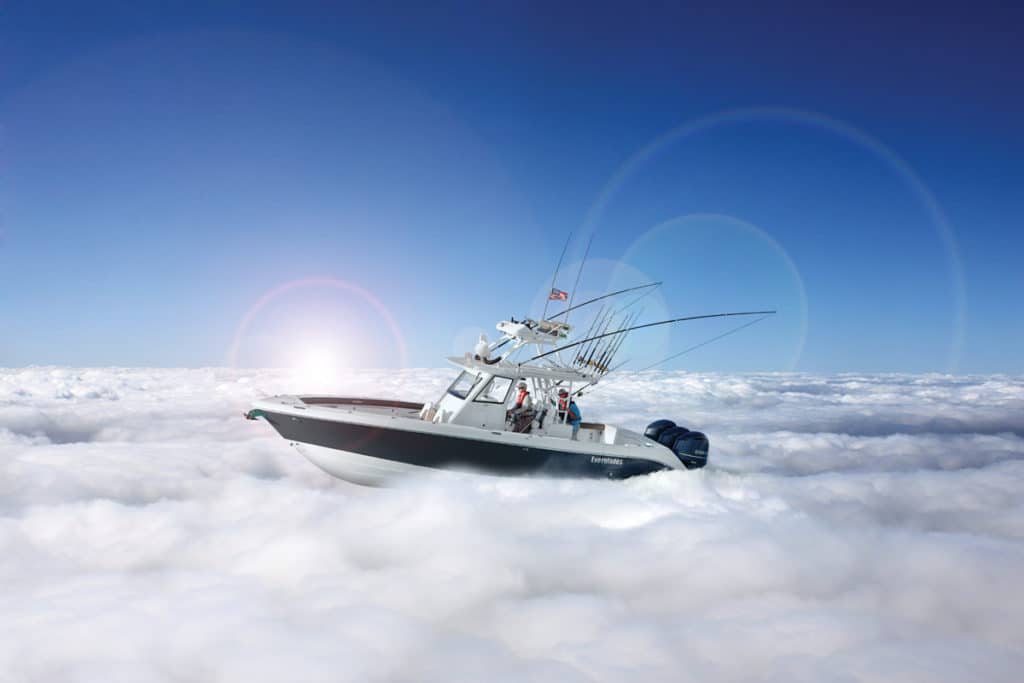
We’ve all been there. A headwind pipes up, and choppy, rough seas dance between you and your destination. You throttle up; you throttle back. You try to help your boat find its comfort zone, and you do your best to quarter the waves.
Inevitably, though, there are those stomach-dropping lurches and the slamming that clenches your muscles and rattles your dental work. Despite your best efforts, you can’t ignore the bangs down below, the ones that make the hull shudder. The ones that make you fervently hope that everyone involved with building this boat did a good job.
That’s a rough ride, even for a rough water boat. And it has happened to all of us, so let’s be honest. Not every boat can provide a soft, smooth ride in snotty conditions, no matter what the glossy brochures say.
We asked three prominent boat designers, and their answers provided much food for thought — regarding how to choose a vessel that’s going to provide a smooth ride, best boat for rough seas, the compromises and trade-offs inherent in your choice, and whether a smooth ride is even what you should be looking for in the first place.
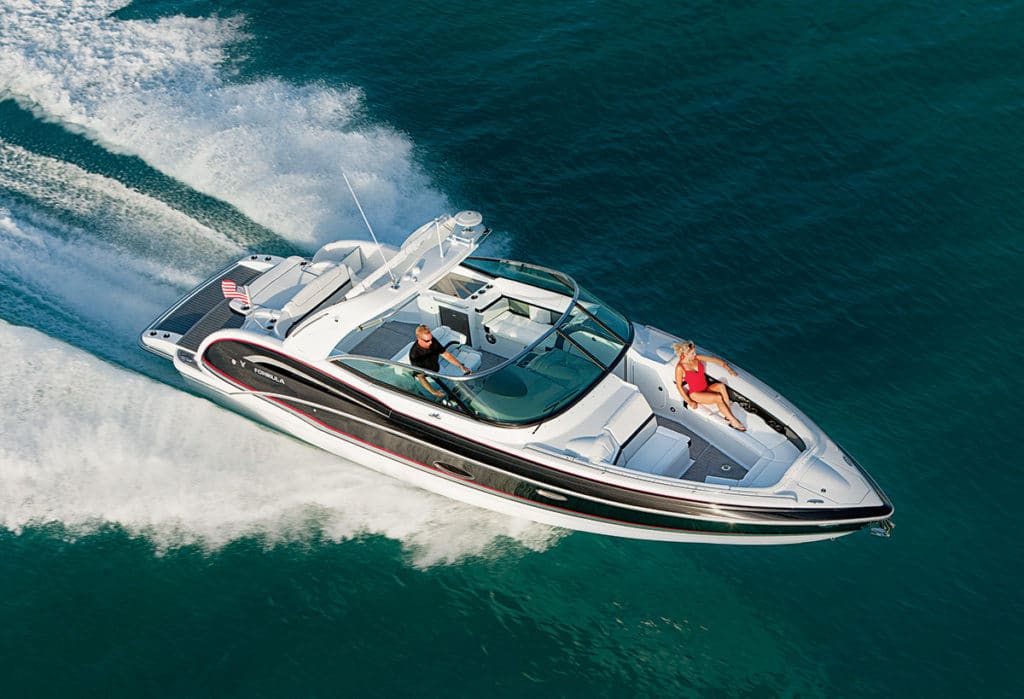
Comparing Displacement and Planing Boat Hulls
Dave Gerr founded New York City-based Gerr Marine Inc. in 1983. He’s designed a broad range of recreational boats and commercial vessels, both monohull and multihull. When it comes to designing a soft-riding hull, he immediately pointed out that there are different sets of criteria for displacement hulls and planing hulls.
Displacement hulls, he noted, don’t pound the way a planing hull will, so they automatically provide a softer ride. To maximize this, designers need to ensure three things: a good roll time, good heave characteristics and deadrise forward.
“For the roll time, we have a formula,” Gerr said. “Every boat has a natural roll period, which is 1 to 1.1 seconds times the boat’s beam in meters. If it’s slower than that, you’ll get that drunken motion. If it’s faster, it’s going to feel snappy and uncomfortable.”
For example, a boat with a 6.7-foot beam ideally should have an approximately two-second roll time. And, Gerr added, a reasonable deadrise forward will make the vessel even more comfortable.
The formula for heave, however, is more complicated. It involves the weight of the boat and the water plane area. The lighter the boat is, and the greater its water plane area, the greater the heave motion will be.
“A wide boat with a large water plane will bounce up and down violently,” Gerr said, “but if you have a small water plane compared to the boat’s weight, that heave will be slow. If it heaves too slowly, you’ve got a wet boat.
“You want to have your roll time and heave in the target region, and then add that deadrise forward,” he continued, “so you won’t have pounding in chop.”
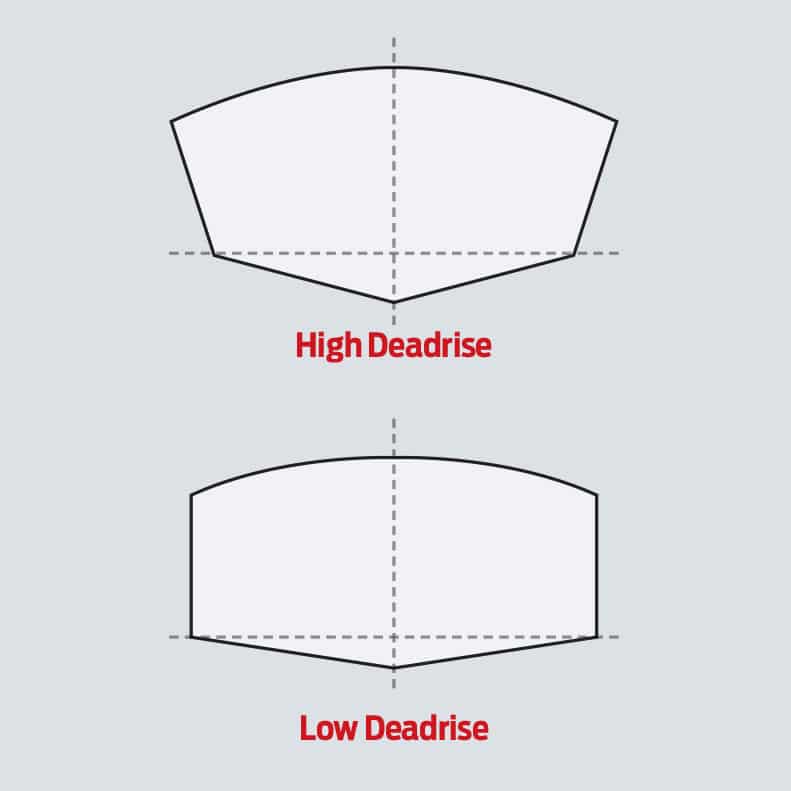
For a planing hull this is hard to achieve. By nature, these hulls are snappy and heave more while trolling or drifting; planing cancels that out, but you can still pound.
“What you really want is more deadrise,” Gerr said. “Just remember: The greater the deadrise, the slower the boat [for the same weight and engine]. That deep-V hull is going to need more power.”
A designer, he said, has to juggle power and what is good deadrise on a boat for optimum comfort.
“You put a deep, high deadrise at the forefoot to get the boat to lift its bow out of the water, or you’ll have steering problems,” he said. “You design it so it planes higher, and then you control it with trim tabs so you won’t trip over that forefoot.”
Deadrise is a difficult thing to visually assess at a boat show or in a dealer’s showroom, so how can a boater ascertain if a soft ride was a design priority? Gerr said the length-to-beam ratio is a dead giveaway.
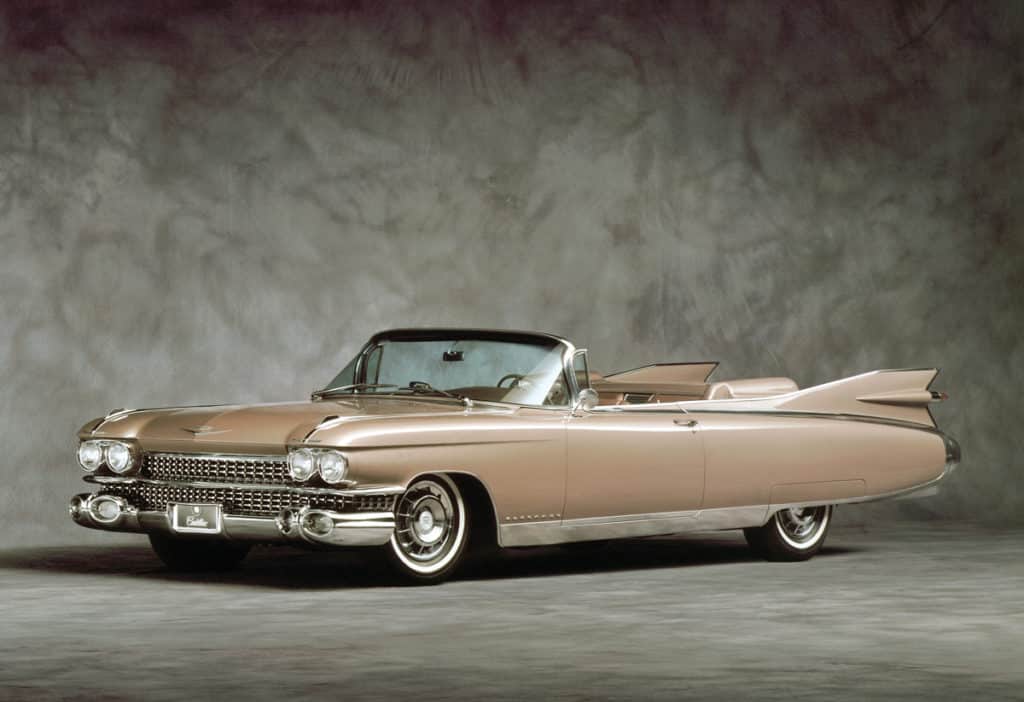
“A long, slender hull is going to have a softer ride, as long as the designer got the roll time right,” he stated. “A wide, shallow hull isn’t going to perform as well. And if you’ve got a high superstructure, you’re going to have increased roll and handling problems.”
Of course, less displacement means it’s a smaller boat inside. You’re going to have to go longer to get the same live-aboard space as that shorter, wider, taller boat next door, but the good news is that your boat is going to be faster and more fuel-efficient than the fat, high version of the same length.
If you are talking deadrise, Gerr said he likes to see a minimum of 17 degrees for offshore boats, although he observed that’s still a bit shallow. Deep-V hulls are considered to be 21 degrees or more. Consider this if you’re looking for the best deadrise for rough water.
“I’d say look for a deadrise of more than 20 degrees,” he advised, “and a length-to-beam ratio on the waterline that is greater than 3.5 to 1. Those two characteristics give you a pretty good idea that the design is intended for a soft ride.”
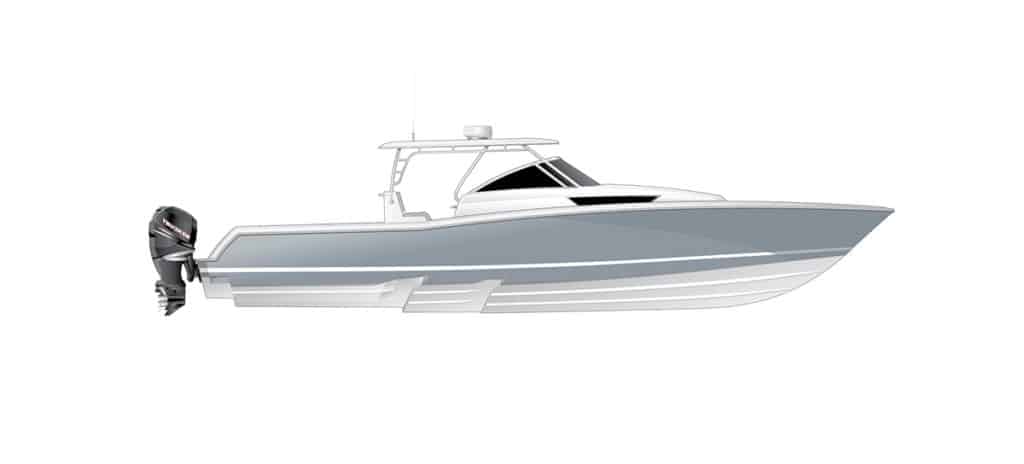
How Does a Boat Hull Handle in Following Seas?
Michael Peters founded Sarasota, Florida-based Michael Peters Yacht Design (MPYD) in 1981. Originally specializing in high-speed boats and offshore racing, MPYD now brings its fusion of performance and aesthetic standards to a wide variety of boat designs. When asked about the search for the perfect soft-riding boat, Peters laughed.
“Think of these ideals: soft-riding, dry and fast,” he said. “Now, pick two.”
The softer-riding a boat is, the wetter it is, because it doesn’t confront the wave. Rather, it splits it. If you want to knock the water down and push it away, then you’ll feel the impact. Boaters clearly need to consider these trade-offs when seeking a soft-riding vessel, but Peters has a more important cautionary tale to share. It’s natural to think of head seas and a soft-riding hull together in the same scenario — but what happens when the boat turns around?
“That’s a different story,” Peters said. “Following seas can pick up the stern, and the sharp angle and deadrise can cause the boat to bow-steer and broach. That’s a much more dangerous situation. It’s uncomfortable to hit the seas on the nose, but it won’t kill you. Boats go out of control in following seas, not head seas.”
Simply put, a hull that is too pointy forward and too flat aft will have an increased risk of broaching. Boaters should look for a hull with deadrise spread evenly — no extremes, such as a professional offshore racing boat’s sharp deadrise throughout the hull. The best boat hull for rough seas must be able to handle following seas.
“If you’re going to have fine forward sections, you’ll balance the hull by putting a lot of deadrise aft,” Peters explained. “You’re looking for recovery, a bow that doesn’t plunge and that can regain its buoyancy in a following sea.
“In our forward sections, we always run a convex section that’s puffed out,” he continued. “Some curvature helps dissipate wave energy and impact. Concave sections look like they’ll provide a softer ride, but they actually focus the energy.”
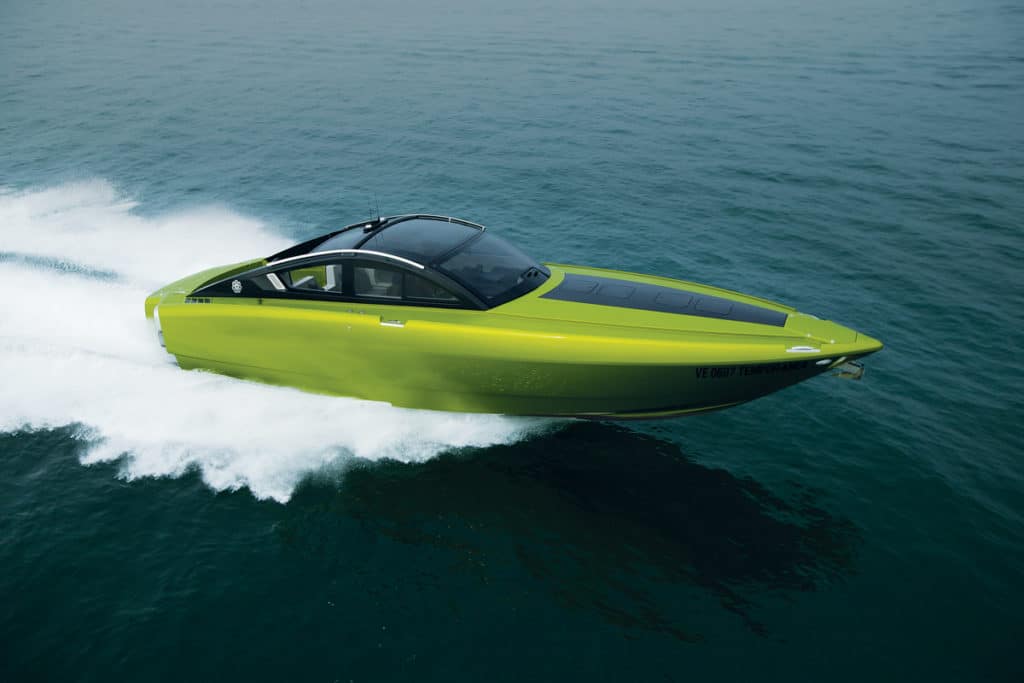
Peters’ advice to boaters is twofold. First, avoid those extremes. They’re not necessary for most recreational boaters. And second, make sure you have a good grasp of where and how you’re going to use the boat. An offshore cruising boat might not be the best choice for a river or inland lake.
“Lakes can be much harder for running a boat than the ocean, where you have long swells rather than steep, breaking seas,” Peters said. “Just make sure you’ve planned for the worst conditions you’ll run in, not the best, and never, ever sign a contract without running the boat in the intended conditions.”
Some boats, he said, are not designed to be the best boat . Sometimes the goal is to provide the best accommodations for the hull’s length and beam, which can mean creating a vessel that has a lot of windage, high freeboard, a high center of gravity and a very wide beam for its length.
“We don’t get to design the best boat in all cases,” Peters said. “No perfect boat? No kidding. But every boat appeals to somebody. One guy might love this particular boat, and he wants that 6-foot-4-inch headroom, while another guy is going to hate the compromises.”
“You always have to be aware that the more you emphasize space, the less boat it’s going to be,” he warned. “And it’s counterintuitive, but what looks good might not be good at all.”
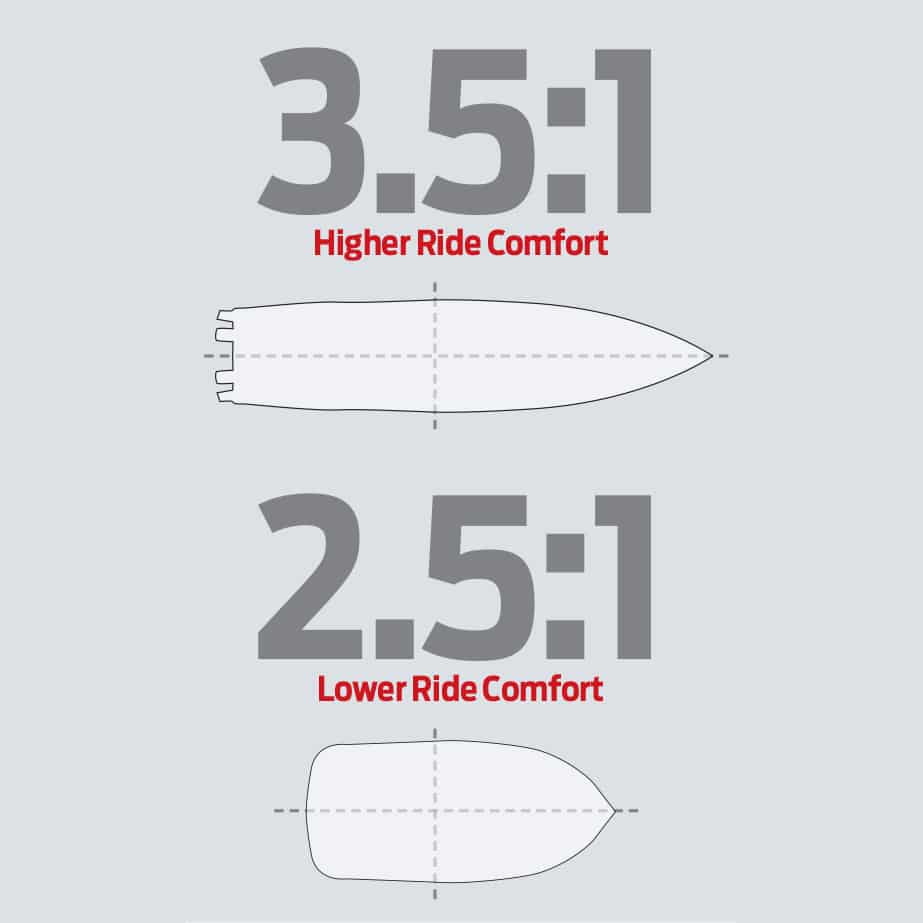
Peters also advised inquiring about a preferred design’s origins. Was it designed in-house at the boatbuilding facility? Was it designed by a naval architect? What are his or her credentials?
“Some people might not care, but it will help you better understand the design,” he said. “With a car, we accept that all the engineering is done correctly, and we can choose our favorite based on appeal alone. With a boat, you should think about engineering and stability calculations, not just styling.”
Finally, Peters noted that good hull designs stand the test of time. With most major advancements taking place in hybrids, like stepped hulls and multihulls, the average boat owner is going to be looking at hull designs that haven’t changed much in 20 or 30 years. And that’s OK.
“Most people just want a good family boat,” he said. “I’d say stay in the middle. The hull should look familiar. That hull from 30 years ago is still a good hull.”
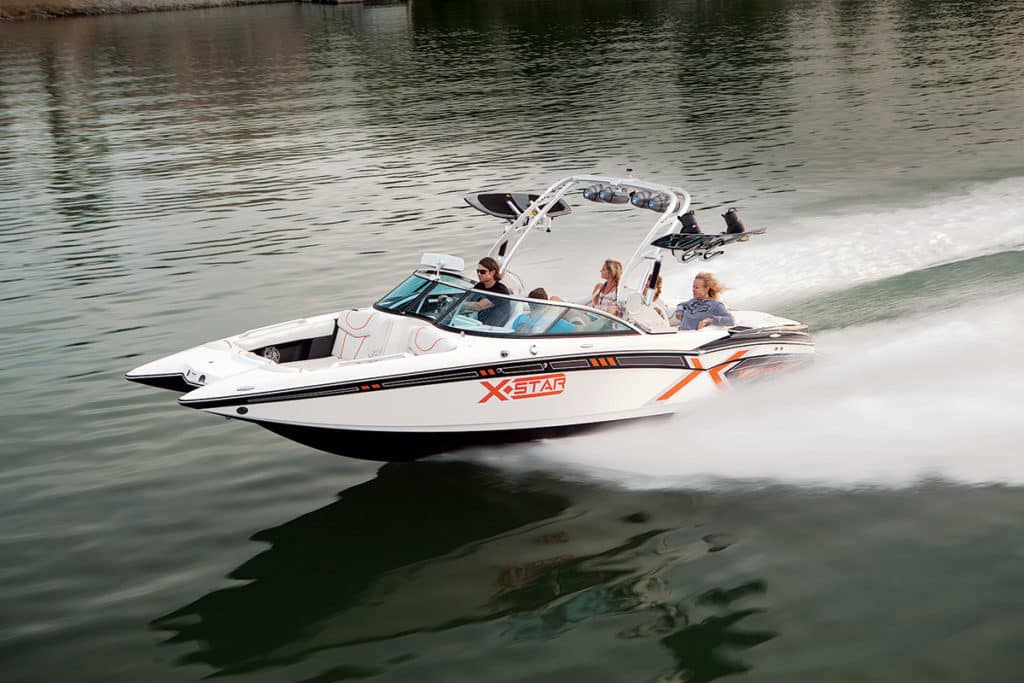
A Boat’s Soft Ride is Subjective
Peter Granata, owner of Palmetto Bluff, South Carolina-based Granata Design , has been designing boats since the early 1970s. With a number of award-winning designs and patented ideas under his belt, he’s firm in his conviction that the soft-ride discussion really shouldn’t be about the boat. It’s about the people involved.
“First of all, the hull ride is felt rather than measured,” he said. “And, it’s based very much on your own individual perception of what the boat looks like and what you expect it to deliver, plus your experience up to that point. It’s very subjective.”
Soft can be a relative term. A boater who is downsizing from a 60-foot yacht to a 30-foot pocket cruiser might find the smaller boat has the worst ride he’s experienced to date, whereas a boater jumping up from a 16-footer will say that 30-footer provides the best ride he’s ever had.
The most important questions a boater can ask, Granata said, are: How well does this design meet its intended purpose, and what can it do for me?
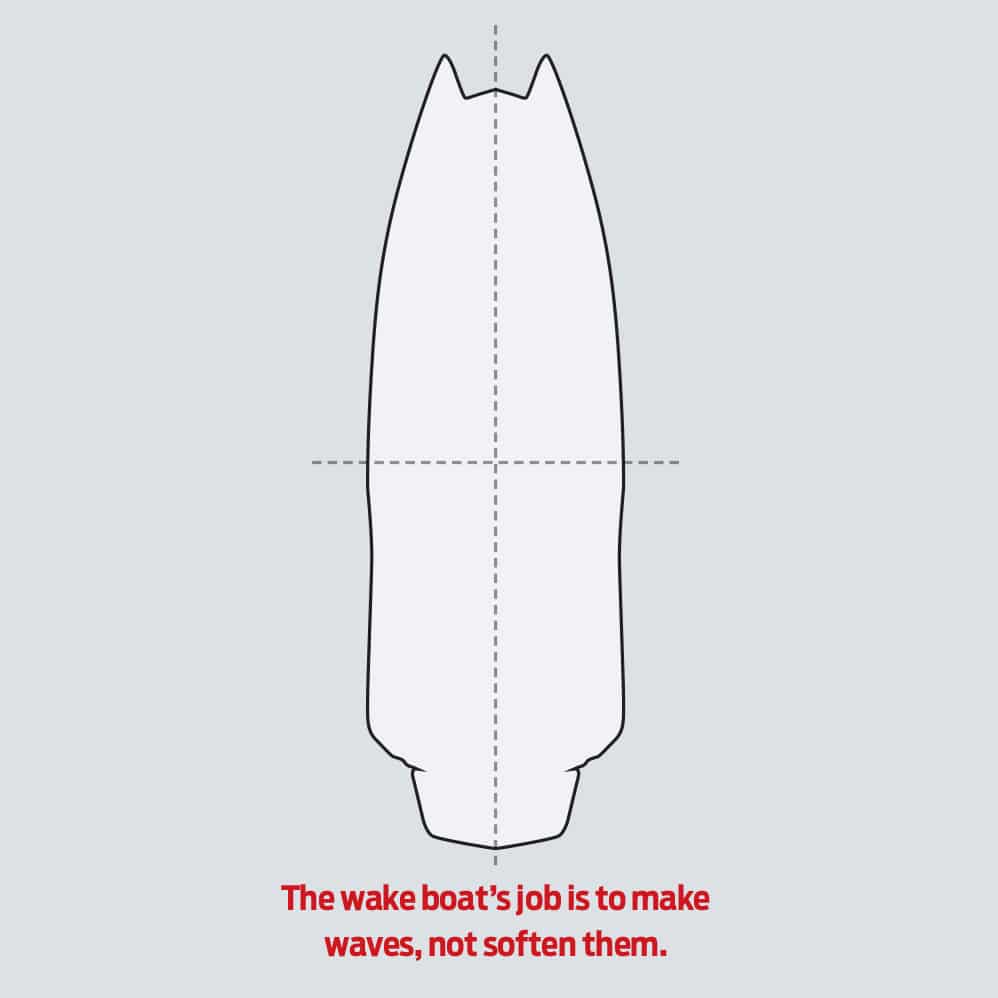
He provided a wakeboard boat as an example. The expectation is for thrills, not the softness of the ride.
“Soft ride is certainly a measurement when it comes to boat design, but it’s not the only one,” he said. “A designer should manage the ride aspect to meet the customer’s expectation. Does the boat do what it’s intended to do?”
The idea is that ride is less important than function, based on customer priorities. If you’re headed offshore and a dry ride is your No. 1 priority, you’ll want to make sure the hull has enough flare to ensure that the water follows the hull and travels outboard rather than over the deck. If you’re an angler, you might look for hull cutaways in the right spots to support the design’s self-bailing characteristics. Bass anglers seek extra buoyancy forward to support their weight.
With “dockominiums,” deep deadrise is unnecessary because owners place a higher priority on stability at rest, accommodations and space for entertaining. And with water-sports boats, the wake is all-important. Without that, the hull is worthless.
“We get so wrapped up in the specifics of hull generation that we forget someone has to buy it and spend time in it,” Granata said. “A designer has to know how the boat will be used, and you do as well. The boat is for you, not for the guy who made it.”
- More: boat building , Boats , Center Consoles
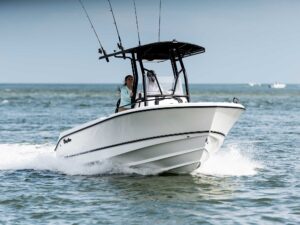
Boat Test: 2024 EdgeWater 208CC Watchman
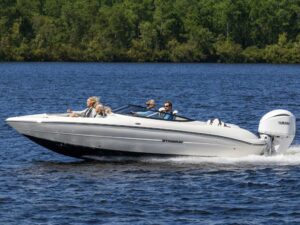
Boat Test: 2024 Stingray 23 OSX
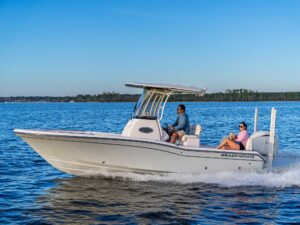
Boat Test: 2024 Grady-White 231 Coastal Explorer
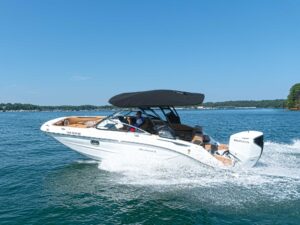
Boat Test: 2024 Hurricane SunDeck 2600 OB
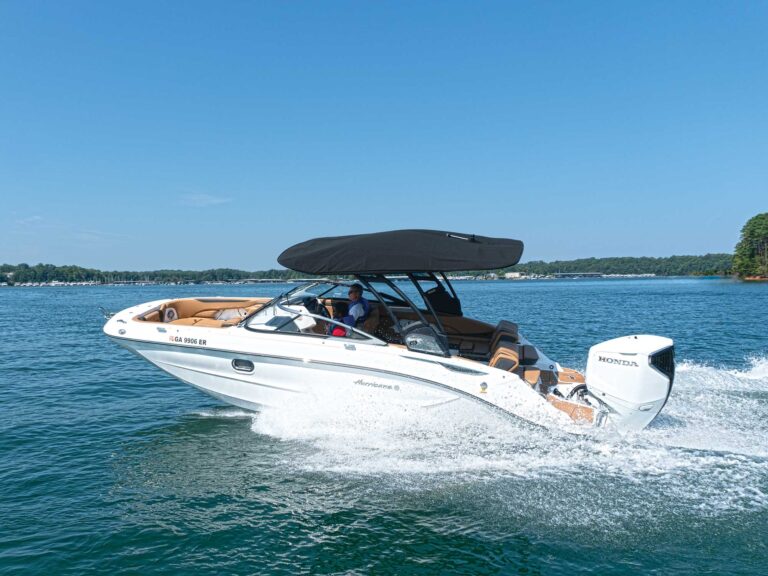
Boat Test: 2024 Brabus Shadow 1200 Sun-Top
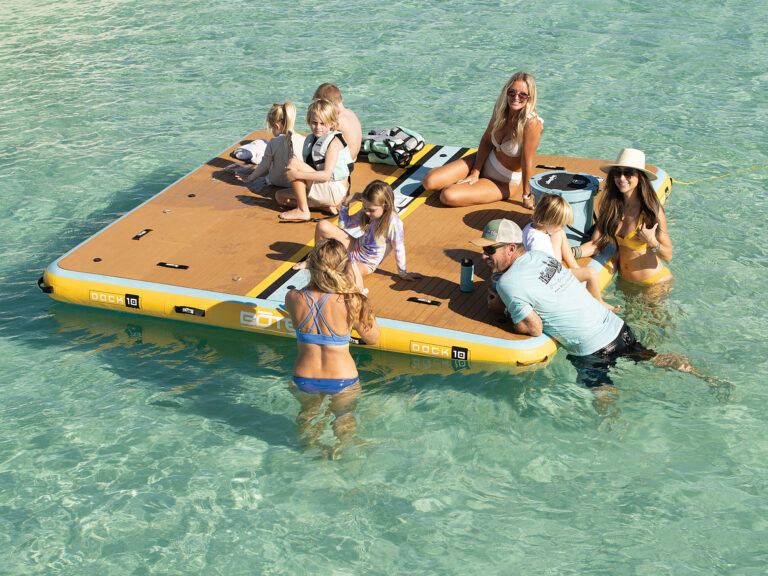
Inflatable Water Mats for Boaters
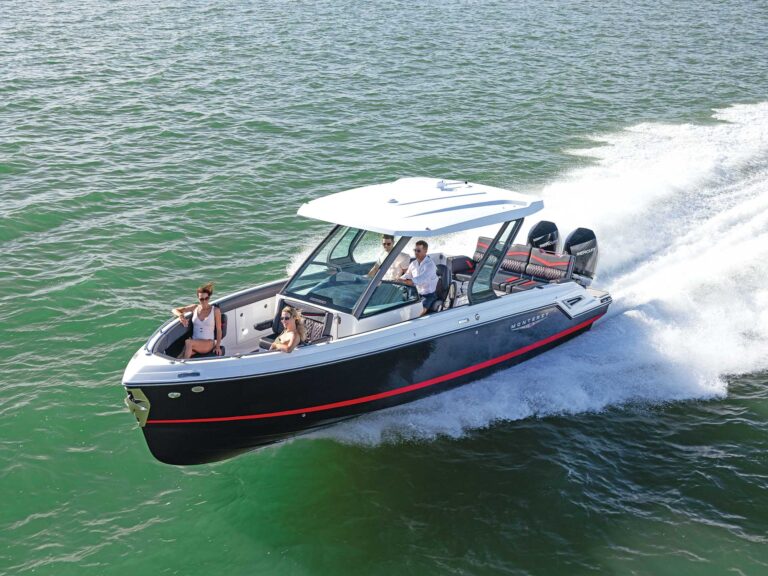
Boat Test: 2024 Monterey Elite 30

- Digital Edition
- Customer Service
- Privacy Policy
- Terms of Use
- Cruising World
- Sailing World
- Salt Water Sportsman
- Sport Fishing
- Wakeboarding
Many products featured on this site were editorially chosen. Boating may receive financial compensation for products purchased through this site.
Copyright © 2024 Boating Firecrown . All rights reserved. Reproduction in whole or in part without permission is prohibited.
- Yachting World
- Digital Edition

43 of the best bluewater sailboat designs of all time
- January 5, 2022
How do you choose the right yacht for you? We highlight the very best bluewater sailboat designs for every type of cruising

Which yacht is the best for bluewater boating? This question generates even more debate among sailors than questions about what’s the coolest yacht , or the best for racing. Whereas racing designs are measured against each other, cruising sailors get very limited opportunities to experience different yachts in real oceangoing conditions, so what is the best bluewater sailboat?
Here, we bring you our top choices from decades of designs and launches. Over the years, the Yachting World team has sailed these boats, tested them or judged them for European Yacht of the Year awards, and we have sifted through the many to curate a selection that we believe should be on your wishlist.
Making the right choice may come down to how you foresee your yacht being used after it has crossed an ocean or completed a passage: will you be living at anchor or cruising along the coast? If so, your guiding requirements will be space, cabin size, ease of launching a tender and anchoring closer to shore, and whether it can comfortably accommodate non-expert-sailor guests.
Article continues below…

The perfect boat: what makes an ideal offshore cruising yacht?
Choosing a boat for offshore cruising is not a decision to be taken lightly. I have researched this topic on…

European Yacht of the Year 2019: Best luxury cruisers
Before the sea trials began, I would have put money on a Hallberg-Rassy or the Wauquiez winning an award. The…
All of these considerations have generated the inexorable rise of the bluewater catamaran – monohulls can’t easily compete on these points. We have a full separate feature on the best bluewater multihulls of all time and here we mostly focus on monohulls. The only exceptions to that rule are two multihulls which made it into our best bluewater sailboats of 2022 list.
As so much of making the right choice is selecting the right boat for the venture in mind, we have separated out our edit into categories: best for comfort; for families; for performance; and for expedition or high latitudes sailing .
Best bluewater sailboats of 2022
The new flagship Allures 51.9, for example, is a no-nonsense adventure cruising design built and finished to a high standard. It retains Allures’ niche of using aluminium hulls with glassfibre decks and superstructures, which, the yard maintains, gives the optimum combination of least maintenance and less weight higher up. Priorities for this design were a full beam aft cabin and a spacious, long cockpit. Both are excellent, with the latter, at 6m long, offering formidable social, sailing and aft deck zones.
It likes some breeze to come to life on the wheel, but I appreciate that it’s designed to take up to five tonnes payload. And I like the ease with which you can change gears using the furling headsails and the positioning of the powerful Andersen winches inboard. The arch is standard and comes with a textile sprayhood or hard bimini.
Below decks you’ll find abundant headroom and natural light, a deep U-shape galley and cavernous stowage. For those who like the layout of the Amel 50 but would prefer aluminium or shoal draught, look no further.
Allures 51.9 price: €766,000
The Ovni 370 is another cunning new aluminum centreboard offering, a true deck saloon cruiser for two. The designers say the biggest challenge was to create a Category A ocean going yacht at this size with a lifting keel, hence the hull had to be very stable.
Enjoyable to helm, it has a practical, deep cockpit behind a large sprayhood, which can link to the bimini on the arch. Many of its most appealing features lie in the bright, light, contemporary, clever, voluminous interior, which has good stowage and tankage allocation. There’s also a practical navstation, a large workroom and a vast separate shower. I particularly like the convertible saloom, which can double as a large secure daybed or pilot berth.
Potentially the least expensive Category A lift keel boat available, the Ovni will get you dreaming of remote places again.
Ovni 370 price: €282,080

There’s no shortage of spirit in the Windelo 50. We gave this a sustainability award after it’s founders spent two years researching environmentally-friendly composite materials, developing an eco-composite of basalt fibre and recycled PET foam so it could build boats that halve the environmental impact of standard glassfibre yachts.
The Windelo 50 is an intriguing package – from the styling, modular interior and novel layout to the solar field on the roof and the standard electric propulsion, it is completely fresh.
Windelo 50 price: €795,000
Best bluewater sailboat of 2022 – Outremer 55
I would argue that this is the most successful new production yacht on the market. Well over 50 have already sold (an equipped model typically costs €1.6m) – and I can understand why. After all, were money no object, I had this design earmarked as the new yacht I would most likely choose for a world trip.
Indeed 55 number one Sanya, was fully equipped for a family’s world cruise, and left during our stay for the Grand Large Odyssey tour. Whereas we sailed Magic Kili, which was tricked up with performance options, including foam-cored deckheads and supports, carbon crossbeam and bulkheads, and synthetic rigging.
At rest, these are enticing space ships. Taking one out to sea is another matter though. These are speed machines with the size, scale and loads to be rightly weary of. Last month Nikki Henderson wrote a feature for us about how to manage a new breed of performance cruising cats just like this and how she coaches new owners. I could not think of wiser money spent for those who do not have ample multihull sailing experience.
Under sail, the most fun was obviously reserved for the reaching leg under asymmetric, where we clocked between 11-16 knots in 15-16 knots wind. But it was the stability and of those sustained low teen speeds which really hit home – passagemaking where you really cover miles.
Key features include the swing helms, which give you views from outboard, over the coachroof or from a protected position in the cockpit through the coachroof windows, and the vast island in the galley, which is key to an open plan main living area. It helps provide cavernous stowage and acts as the heart of the entertaining space as it would in a modern home. As Danish judge Morten Brandt-Rasmussen comments: “Apart from being the TGV of ocean passages the boat offers the most spacious, open and best integration of the cockpit and salon areas in the market.”
Outremer has done a top job in packing in the creature comforts, stowage space and payload capacity, while keeping it light enough to eat miles. Although a lot to absorb and handle, the 55 offers a formidable blend of speed and luxury cruising.
Outremer 55 price: €1.35m
Best bluewater sailboats for comfort
This is the successor to the legendary Super Maramu, a ketch design that for several decades defined easy downwind handling and fostered a cult following for the French yard. Nearly a decade old, the Amel 55 is the bridge between those world-girdling stalwarts and Amel’s more recent and totally re-imagined sloop designs, the Amel 50 and 60.
The 55 boasts all the serious features Amel aficionados loved and valued: a skeg-hung rudder, solidly built hull, watertight bulkheads, solid guardrails and rampart bulwarks. And, most noticeable, the solid doghouse in which the helmsman sits in perfect shelter at the wheel.
This is a design to live on comfortably for long periods and the list of standard features just goes on and on: passarelle; proper sea berths with lee cloths; electric furling main and genoa; and a multitude of practical items that go right down to a dishwasher and crockery.
There’s no getting around the fact these designs do look rather dated now, and through the development of easier sail handling systems the ketch rig has fallen out of fashion, but the Amel is nothing short of a phenomenon, and if you’ve never even peeked on board one, you really have missed a treat.

Photo: Sander van der Borch
Contest 50CS
A centre cockpit cruiser with true longevity, the Contest 50CS was launched by Conyplex back in 2003 and is still being built by the family-owned Dutch company, now in updated and restyled form.
With a fully balanced rudder, large wheel and modern underwater sections, the Contest 50CS is a surprisingly good performer for a boat that has a dry weight of 17.5 tonnes. Many were fitted with in-mast furling, which clearly curtails that performance, but even without, this boat is set up for a small crew.
Electric winches and mainsheet traveller are all easy to reach from the helm. On our test of the Contest 50CS, we saw for ourselves how two people can gybe downwind under spinnaker without undue drama. Upwind, a 105% genoa is so easy to tack it flatters even the weediest crewmember.
Down below, the finish level of the joinery work is up there among the best and the interior is full of clever touches, again updated and modernised since the early models. Never the cheapest bluewater sailing yacht around, the Contest 50CS has remained in demand as a brokerage buy. She is a reassuringly sure-footed, easily handled, very well built yacht that for all those reasons has stood the test of time.
This is a yacht that would be well capable of helping you extend your cruising grounds, almost without realising it.
Read more about the Contest 50CS and the new Contest 49CS

Photo: Rick Tomlinson
Hallberg-Rassy 48 Mk II
For many, the Swedish Hallberg-Rassy yard makes the quintessential bluewater cruiser for couples. With their distinctive blue cove line, these designs are famous for their seakindly behaviour, solid-as-a-rock build and beautifully finished, traditional interiors.
To some eyes, Hallberg-Rassys aren’t quite cool enough, but it’s been company owner Magnus Rassy’s confidence in the formula and belief in incremental ‘step-by-step’ evolution that has been such an exceptional guarantor of reliable quality, reputation and resale value.
The centre cockpit Hallberg-Rassy 48 epitomises the concept of comfort at sea and, like all the Frers-designed Hallberg-Rassys since the 1990s, is surprisingly fleet upwind as well as steady downwind. The 48 is perfectly able to be handled by a couple (as we found a few years back in the Pacific), and could with no great effort crack out 200-mile days.
The Hallberg-Rassy 48 was launched nearly a decade ago, but the Mk II from 2014 is our pick, updated with a more modern profile, larger windows and hull portlights that flood the saloon and aft cabin with light. With a large chart table, secure linear galley, heaps of stowage and space for bluewater extras such as machinery and gear, this yacht pretty much ticks all the boxes.

Discovery 55
First launched in 2000, the Discovery 55 has stood the test of time. Designed by Ron Holland, it hit a sweet spot in size that appealed to couples and families with world girdling plans.
Elegantly styled and well balanced, the 55 is also a practical design, with a deep and secure cockpit, comfortable seating, a self-tacking jib, dedicated stowage for the liferaft , a decent sugar scoop transom that’s useful for swimming or dinghy access, and very comfortable accommodation below. In short, it is a design that has been well thought out by those who’ve been there, got the bruises, stubbed their toes and vowed to change things in the future if they ever got the chance.
Throughout the accommodation there are plenty of examples of good detailing, from the proliferation of handholds and grabrails, to deep sinks in the galley offering immediate stowage when under way and the stand up/sit down showers. Stowage is good, too, with plenty of sensibly sized lockers in easily accessible positions.
The Discovery 55 has practical ideas and nifty details aplenty. She’s not, and never was, a breakthrough in modern luxury cruising but she is pretty, comfortable to sail and live on, and well mannered.

Photo: Latitudes Picture Library
You can’t get much more Cornish than a Rustler. The hulls of this Stephen Jones design are hand-moulded and fitted out in Falmouth – and few are more ruggedly built than this traditional, up-for-anything offshore cruiser.
She boasts an encapsulated lead keel, eliminating keel bolts and creating a sump for generous fuel and water tankage, while a chunky skeg protects the rudder. She is designed for good directional stability and load carrying ability. These are all features that lend this yacht confidence as it shoulders aside the rough stuff.
Most of those built have had a cutter rig, a flexible arrangement that makes sense for long passages in all sea and weather conditions. Down below, the galley and saloon berths are comfortable and sensible for living in port and at sea, with joinery that Rustler’s builders are rightly proud of.
As modern yachts have got wider, higher and fatter, the Rustler 42 is an exception. This is an exceptionally well-mannered seagoing yacht in the traditional vein, with elegant lines and pleasing overhangs, yet also surprisingly powerful. And although now over 20 years old, timeless looks and qualities mean this design makes her look ever more like a perennial, a modern classic.
The definitive crossover size, the point at which a yacht can be handled by a couple but is just large enough to have a professional skipper and be chartered, sits at around the 60ft mark. At 58ft 8in, the Oyster 575 fitted perfectly into this growing market when launched in 2010. It went on to be one of the most popular models from the yard, and is only now being superseded by the newer Rob Humphreys-designed Oyster 565 (just launched this spring).
Built in various configurations with either a deep keel, shoal draught keel or centreboard with twin rudders, owners could trade off better performance against easy access to shallower coves and anchorages. The deep-bodied hull, also by Rob Humphreys, is known for its easy motion at sea.
Some of the Oyster 575’s best features include its hallmark coachroof windows style and centre cockpit – almost everyone will know at first glance this is an Oyster – and superb interior finish. If she has a flaw, it is arguably the high cockpit, but the flip side is the galley headroom and passageway berth to the large aft stateroom.
This design also has a host of practical features for long-distance cruising, such as high guardrails, dedicated liferaft stowage, a vast lazarette for swallowing sails, tender, fenders etc, and a penthouse engine room.

Privilege Serie 5
A true luxury catamaran which, fully fitted out, will top €1m, this deserves to be seen alongside the likes of the Oyster 575, Gunfleet 58 and Hallberg-Rassy 55. It boasts a large cockpit and living area, and a light and spacious saloon with an emphasis on indoor-outdoor living, masses of refrigeration and a big galley.
Standout features are finish quality and solid build in a yacht designed to take a high payload, a secure walkaround deck and all-round views from the helm station. The new Privilege 510 that will replace this launches in February 2020.
Gunfleet 43
It was with this Tony Castro design that Richard Matthews, founder of Oyster Yachts, launched a brand new rival brand in 2012, the smallest of a range stretching to the flagship Gunfleet 74. The combination of short overhangs and centre cockpit at this size do make the Gunfleet 43 look modern if a little boxy, but time and subsequent design trends have been kind to her lines, and the build quality is excellent. The saloon, galley and aft cabin space is exceptional on a yacht of this size.

Photo: David Harding
Conceived as a belt-and-braces cruiser, the Kraken 50 launched last year. Its unique points lie underwater in the guise of a full skeg-hung rudder and so-called ‘Zero Keel’, an encapsulated long keel with lead ballast.
Kraken Yachts is the brainchild of British businessman and highly experienced cruiser Dick Beaumont, who is adamant that safety should be foremost in cruising yacht design and build. “There is no such thing as ‘one yacht for all purposes’… You cannot have the best of all worlds, whatever the salesman tells you,” he says.
Read our full review of the Kraken 50 .

Wauquiez Centurion 57
Few yachts can claim to be both an exciting Med-style design and a serious and practical northern European offshore cruiser, but the Wauquiez Centurion 57 tries to blend both. She slightly misses if you judge solely by either criterion, but is pretty and practical enough to suit her purpose.
A very pleasant, well-considered yacht, she is impressively built and finished with a warm and comfortable interior. More versatile than radical, she could be used for sailing across the Atlantic in comfort and raced with equal enjoyment at Antigua Sailing Week .

A modern classic if ever there was one. A medium to heavy displacement yacht, stiff and easily capable of standing up to her canvas. Pretty, traditional lines and layout below.

Photo: Voyage of Swell
Well-proven US legacy design dating back to the mid-1960s that once conquered the Transpac Race . Still admired as pretty, with slight spoon bow and overhanging transom.

Capable medium displacement cruiser, ideal size and good accommodation for couples or family cruising, and much less costly than similar luxury brands.

Photo: Peter Szamer
Swedish-built aft cockpit cruiser, smaller than many here, but a well-built and finished, super-durable pocket ocean cruiser.

Tartan 3700
Designed as a performance cruiser there are nimbler alternatives now, but this is still an extremely pretty yacht.
Broker ’ s choice

Discovery 55 Brizo
This yacht has already circumnavigated the globe and is ‘prepared for her next adventure,’ says broker Berthon. Price: £535,000 + VAT

Oyster 575 Ayesha
‘Stunning, and perfectly equipped for bluewater cruising,’ says broker Ancasta International. Price: £845,000 (tax not paid)

Oyster 575 Pearls of Nautilus
Nearly new and with a high spec, this Oyster Brokerage yacht features American white oak joinery and white leather upholstery and has a shoal draught keel. Price: $1.49m
Best bluewater yachts for performance
The Frers-designed Swan 54 may not be the newest hull shape but heralded Swan’s latest generation of displacement bluewater cruisers when launched four years ago. With raked stem, deep V hull form, lower freeboard and slight curve to the topsides she has a more timeless aesthetic than many modern slab-sided high volume yachts, and with that a seakindly motion in waves. If you plan to cover many miles to weather, this is probably the yacht you want to be on.

Photo: Carlo Borlenghi
Besides Swan’s superlative build quality, the 54 brings many true bluewater features, including a dedicated sail locker. There’s also a cockpit locker that functions as a utility cabin, with potential to hold your generator and washing machine, or be a workshop space.
The sloping transom opens out to reveal a 2.5m bathing platform, and although the cabins are not huge there is copious stowage space. Down below the top-notch oak joinery is well thought through with deep fiddles, and there is a substantial nav station. But the Swan 54 wins for handling above all, with well laid-out sail controls that can be easily managed between a couple, while offering real sailing enjoyment to the helmsman.

Photo: Graham Snook
The Performance Cruiser winner at the 2019 European Yacht of the Year awards, the Arcona 435 is all about the sailing experience. She has genuine potential as a cruiser-racer, but her strengths are as an enjoyable cruiser rather than a full-blown liveaboard bluewater boat.
Build quality is excellent, there is the option of a carbon hull and deck, and elegant lines and a plumb bow give the Arcona 435 good looks as well as excellent performance in light airs. Besides slick sail handling systems, there are well thought-out features for cruising, such as ample built-in rope bins and an optional semi-closed stern with stowage and swim platform.

Outremer 51
If you want the space and stability of a cat but still prioritise sailing performance, Outremer has built a reputation on building catamarans with true bluewater characteristics that have cruised the planet for the past 30 years.
Lighter and slimmer-hulled than most cruising cats, the Outremer 51 is all about sailing at faster speeds, more easily. The lower volume hulls and higher bridgedeck make for a better motion in waves, while owners report that being able to maintain a decent pace even under reduced canvas makes for stress-free passages. Deep daggerboards also give good upwind performance.
With bucket seats and tiller steering options, the Outremer 51 rewards sailors who want to spend time steering, while they’re famously well set up for handling with one person on deck. The compromise comes with the interior space – even with a relatively minimalist style, there is less cabin space and stowage volume than on the bulkier cats, but the Outremer 51 still packs in plenty of practical features.

The Xc45 was the first cruising yacht X-Yachts ever built, and designed to give the same X-Yachts sailing experience for sailors who’d spent years racing 30/40-footer X- and IMX designs, but in a cruising package.
Launched over 10 years ago, the Xc45 has been revisited a few times to increase the stowage and modernise some of the styling, but the key features remain the same, including substantial tanks set low for a low centre of gravity, and X-Yachts’ trademark steel keel grid structure. She has fairly traditional styling and layout, matched with solid build quality.
A soft bilge and V-shaped hull gives a kindly motion in waves, and the cockpit is secure, if narrow by modern standards.

A three or four cabin catamaran that’s fleet of foot with high bridgedeck clearance for comfortable motion at sea. With tall daggerboards and carbon construction in some high load areas, Catana cats are light and quick to accelerate.

Sweden Yachts 45
An established bluewater design that also features in plenty of offshore races. Some examples are specced with carbon rig and retractable bowsprits. All have a self-tacking jib for ease. Expect sweeping areas of teak above decks and a traditionally wooded interior with hanging wet locker.

A vintage performer, first launched in 1981, the 51 was the first Frers-designed Swan and marked a new era of iconic cruiser-racers. Some 36 of the Swan 51 were built, many still actively racing and cruising nearly 40 years on. Classic lines and a split cockpit make this a boat for helming, not sunbathing.

Photo: Julien Girardot / EYOTY
The JPK 45 comes from a French racing stable, combining race-winning design heritage with cruising amenities. What you see is what you get – there are no superfluous headliners or floorboards, but there are plenty of ocean sailing details, like inboard winches for safe trimming. The JPK 45 also has a brilliantly designed cockpit with an optional doghouse creating all-weather shelter, twin wheels and superb clutch and rope bin arrangement.

Photo: Andreas Lindlahr
For sailors who don’t mind exchanging a few creature comforts for downwind planing performance, the Pogo 50 offers double-digit surfing speeds for exhilarating tradewind sailing. There’s an open transom, tiller steering and no backstay or runners. The Pogo 50 also has a swing keel, to nose into shallow anchorages.

Seawind 1600
Seawinds are relatively unknown in Europe, but these bluewater cats are very popular in Australia. As would be expected from a Reichel-Pugh design, this 52-footer combines striking good looks and high performance, with fine entry bows and comparatively low freeboard. Rudders are foam cored lifting designs in cassettes, which offer straightforward access in case of repairs, while daggerboards are housed under the deck.
Best bluewater sailboats for families
It’s unsurprising that, for many families, it’s a catamaran that meets their requirements best of increased space – both living space and separate cabins for privacy-seeking teenagers, additional crew or visiting family – as well as stable and predictable handling.

Photo: Nicholas Claris
Undoubtedly one of the biggest success stories has been the Lagoon 450, which, together with boats like the Fountaine Pajot 44, helped drive up the popularity of catamaran cruising by making it affordable and accessible. They have sold in huge numbers – over 1,000 Lagoon 450s have been built since its launch in 2010.
The VPLP-designed 450 was originally launched with a flybridge with a near central helming position and upper level lounging areas (450F). The later ‘sport top’ option (450S) offered a starboard helm station and lower boom (and hence lower centre of gravity for reduced pitching). The 450S also gained a hull chine to create additional volume above the waterline. The Lagoon features forward lounging and aft cockpit areas for additional outdoor living space.
Besides being a big hit among charter operators, Lagoons have proven themselves over thousands of bluewater miles – there were seven Lagoon 450s in last year’s ARC alone. In what remains a competitive sector of the market, Lagoon has recently launched a new 46, with a larger self-tacking jib and mast moved aft, and more lounging areas.

Photo: Gilles Martin-Raget
Fountaine Pajot Helia 44
The FP Helia 44 is lighter, lower volume, and has a lower freeboard than the Lagoon, weighing in at 10.8 tonnes unloaded (compared to 15 for the 450). The helm station is on a mezzanine level two steps up from the bridgedeck, with a bench seat behind. A later ‘Evolution’ version was designed for liveaboard cruisers, featuring beefed up dinghy davits and an improved saloon space.
Available in three or four cabin layouts, the Helia 44 was also popular with charter owners as well as families. The new 45 promises additional volume, and an optional hydraulically lowered ‘beach club’ swim platform.

Photo: Arnaud De Buyzer / graphikup.com
The French RM 1370 might be less well known than the big brand names, but offers something a little bit different for anyone who wants a relatively voluminous cruising yacht. Designed by Marc Lombard, and beautifully built from plywood/epoxy, the RM is stiff and responsive, and sails superbly.
The RM yachts have a more individual look – in part down to the painted finish, which encourages many owners to personalise their yachts, but also thanks to their distinctive lines with reverse sheer and dreadnought bow. The cockpit is well laid out with the primary winches inboard for a secure trimming position. The interior is light, airy and modern, although the open transom won’t appeal to everyone.
For those wanting a monohull, the Hanse 575 hits a similar sweet spot to the popular multis, maximising accommodation for a realistic price, yet with responsive performance.
The Hanse offers a vast amount of living space thanks to the ‘loft design’ concept of having all the living areas on a single level, which gives a real feeling of spaciousness with no raised saloon or steps to accommodation. The trade-off for such lofty head height is a substantial freeboard – it towers above the pontoon, while, below, a stepladder is provided to reach some hatches.
Galley options include drawer fridge-freezers, microwave and coffee machine, and the full size nav station can double up as an office or study space.
But while the Hanse 575 is a seriously large boat, its popularity is also down to the fact that it is genuinely able to be handled by a couple. It was innovative in its deck layout: with a self-tacking jib and mainsheet winches immediately to hand next to the helm, one person could both steer and trim.
Direct steering gives a feeling of control and some tangible sailing fun, while the waterline length makes for rapid passage times. In 2016 the German yard launched the newer Hanse 588 model, having already sold 175 of the 575s in just four years.

Photo: Bertel Kolthof
Jeanneau 54
Jeanneau leads the way among production builders for versatile all-rounder yachts that balance sail performance and handling, ergonomics, liveaboard functionality and good looks. The Jeanneau 54 , part of the range designed by Philippe Briand with interior by Andrew Winch, melds the best of the larger and smaller models and is available in a vast array of layout options from two cabins/two heads right up to five cabins and three heads.
We’ve tested the Jeanneau 54 in a gale and very light winds, and it acquitted itself handsomely in both extremes. The primary and mainsheet winches are to hand next to the wheel, and the cockpit is spacious, protected and child-friendly. An electric folding swim and sun deck makes for quick fun in the water.

Nautitech Open 46
This was the first Nautitech catamaran to be built under the ownership of Bavaria, designed with an open-plan bridgedeck and cockpit for free-flowing living space. But with good pace for eating up bluewater miles, and aft twin helms rather than a flybridge, the Nautitech Open 46 also appeals to monohull sailors who prefer a more direct sailing experience.

Made by Robertson and Caine, who produce catamarans under a dual identity as both Leopard and the Sunsail/Moorings charter cats, the Leopard 45 is set to be another big seller. Reflecting its charter DNA, the Leopard 45 is voluminous, with stepped hulls for reduced waterline, and a separate forward cockpit.
Built in South Africa, they are robustly tested off the Cape and constructed ruggedly enough to handle heavy weather sailing as well as the demands of chartering.

Photo: Olivier Blanchet
If space is king then three hulls might be even better than two. The Neel 51 is rare as a cruising trimaran with enough space for proper liveaboard sailing. The galley and saloon are in the large central hull, together with an owner’s cabin on one level for a unique sensation of living above the water. Guest or family cabins lie in the outer hulls for privacy and there is a cavernous full height engine room under the cabin sole.
Performance is notably higher than an equivalent cruising cat, particularly in light winds, with a single rudder giving a truly direct feel in the helm, although manoeuvring a 50ft trimaran may daunt many sailors.

Beneteau Oceanis 46.1
A brilliant new model from Beneteau, this Finot Conq design has a modern stepped hull, which offers exhilarating and confidence-inspiring handling in big breezes, and slippery performance in lighter winds.
The Beneteau Oceanis 46.1 was the standout performer at this year’s European Yacht of the Year awards, and, in replacing the popular Oceanis 45, looks set to be another bestseller. Interior space is well used with a double island berth in the forepeak. An additional inboard unit creates a secure galley area, but tank capacity is moderate for long periods aboard.

Beneteau Oceanis 473
A popular model that offers beam and height in a functional layout, although, as with many boats of this age (she was launched in 2002), the mainsheet is not within reach of the helmsman.

Jeanneau Sun Odyssey 49
The Philippe Briand-designed Sun Odyssey range has a solid reputation as family production cruisers. Like the 473, the Sun Odyssey 49 was popular for charter so there are plenty of four-cabin models on the market.

Nautitech 441
The hull design dates back to 1995, but was relaunched in 2012. Though the saloon interior has dated, the 441 has solid practical features, such as a rainwater run-off collection gutter around the coachroof.

Atlantic 42
Chris White-designed cats feature a pilothouse and forward waist-high working cockpit with helm position, as well as an inside wheel at the nav station. The Atlantic 42 offers limited accommodation by modern cat standards but a very different sailing experience.
Best bluewater sailing yachts for expeditions
Bestevaer 56.
All of the yachts in our ‘expedition’ category are aluminium-hulled designs suitable for high latitude sailing, and all are exceptional yachts. But the Bestevaer 56 is a spectacular amount of boat to take on a true adventure. Each Bestevaer is a near-custom build with plenty of bespoke options for owners to customise the layout and where they fall on the scale of rugged off-grid adventurer to 4×4-style luxury fit out.

The Bestevaer range began when renowned naval architect Gerard Dijkstra chose to design his own personal yacht for liveaboard adventure cruising, a 53-footer. The concept drew plenty of interest from bluewater sailors wanting to make longer expeditions and Bestevaers are now available in a range of sizes, with the 56-footer proving a popular mid-range length.
The well-known Bestevaer 56 Tranquilo (pictured above) has a deep, secure cockpit, voluminous tanks (700lt water and over 1,100lt fuel) and a lifting keel plus water ballast, with classically styled teak clad decks and pilot house. Other owners have opted for functional bare aluminium hull and deck, some choose a doghouse and others a pilothouse.

Photo: Jean-Marie Liot
The Boreal 52 also offers Land Rover-esque practicality, with utilitarian bare aluminium hulls and a distinctive double-level doghouse/coachroof arrangement for added protection in all weathers. The cockpit is clean and uncluttered, thanks to the mainsheet position on top of the doghouse, although for visibility in close manoeuvring the helmsman will want to step up onto the aft deck.
Twin daggerboards, a lifting centreboard and long skeg on which she can settle make this a true go-anywhere expedition yacht. The metres of chain required for adventurous anchoring is stowed in a special locker by the mast to keep the weight central. Down below has been thought through with equally practical touches, including plenty of bracing points and lighting that switches on to red light first to protect your night vision.

Photo: Morris Adant / Garcia Yachts
Garcia Exploration 45
The Garcia Exploration 45 comes with real experience behind her – she was created in association with Jimmy Cornell, based on his many hundreds of thousands of miles of bluewater cruising, to go anywhere from high latitudes to the tropics.
Arguably less of a looker than the Bestevaer, the Garcia Exploration 45 features a rounded aluminium hull, centreboard with deep skeg and twin daggerboards. The considerable anchor chain weight has again been brought aft, this time via a special conduit to a watertight locker in front of the centreboard.
This is a yacht designed to be lived on for extended periods with ample storage, and panoramic portlights to give a near 360° view of whichever extraordinary landscape you are exploring. Safety features include a watertight companionway door to keep extreme weather out and through-hull fittings placed above the waterline. When former Vendée Globe skipper Pete Goss went cruising , this was the boat he chose to do it in.

Photo: svnaima.com
A truly well-proven expedition design, some 1,500 Ovnis have been built and many sailed to some of the most far-flung corners of the world. (Jimmy Cornell sailed his Aventura some 30,000 miles, including two Drake Passage crossings, one in 50 knots of wind).

Futuna Exploration 54
Another aluminium design with a swinging centreboard and a solid enclosed pilothouse with protected cockpit area. There’s a chunky bowsprit and substantial transom arch to house all manner of electronics and power generation.
Previous boats have been spec’d for North West Passage crossings with additional heating and engine power, although there’s a carbon rig option for those that want a touch of the black stuff. The tanks are capacious, with 1,000lt capability for both fresh water and fuel.
If you enjoyed this….
Yachting World is the world’s leading magazine for bluewater cruisers and offshore sailors. Every month we have inspirational adventures and practical features to help you realise your sailing dreams. Build your knowledge with a subscription delivered to your door. See our latest offers and save at least 30% off the cover price.
- THE PRINCESS PASSPORT
- Email Newsletter
- Yacht Walkthroughs
- Destinations
- Electronics
- Boating Safety
- Ultimate Boating Giveaway

14 Great Pocket Cruisers in 2023
- By Victor Tan
- Updated: July 20, 2023
Pocket cruisers and mini yachts are generally vessels under 50 feet in length overall, and can include express cruiser designs, flybridge yachts as well as either monohull or catamaran hull forms. They are cruising boats easily handled by a small, or even shorthanded, crew. Pocket cruisers generally have wave-taming hull designs and have the ability to take on sporty seas, offer comfortable accommodations belowdecks with one or two staterooms for extended voyages, “homelike amenities,” and the ability to cruise as slowly or as quickly as an owner desires with inboard- and outboard-power options. These pocket-cruising boats have the range for longer voyages , can pull up in skinny water at the sandbar thanks to shallow drafts, and head over the horizon where cruising adventure awaits. Pocket cruisers are true multitasking yachts. When it comes to family and couples cruising, it’s hard to beat a well-built and well-equipped and pocket cruiser.
Best Cruising Boats Under 50-Feet
The following 14 pocket cruisers and mini yachts are all vessels we’ve seen, been aboard, and tested. They are listed in no particular order.
- Hood 35 LM: high-tech, family-friendly pocket cruiser
- Galeon Yachts 375 GTO: mid-size boat with plenty of below-deck space
- Aquila 42: sleek power catamaran ready to entertain
- Azimut Verve 42 : small, yet mighty yacht ready for open water
- Hinckley Yachts 35: luxury picnic cruiser with range
- Beneteau Gran Turismo 45: sleek cruising yacht with all the amenities
- Solaris Power 48 Open: eye-catching power yacht with 360-degree views
- Cruisers Yachts 42 GLS: luxury cruiser yacht with powerful outboard options
- Back Cove 34O: modern outboard power combined with classic Downeast styling
- Picnic Boat 40: speedy and fuel-efficient vessel with great looks
- Aquila 36: comfortably seat up to 20 guests for fun on the salt
- Boston Whaler 350 Realm: multitasker built for fishing and entertaining
- MJM 35z: sporty, aesthetically pleasing, cruising-conscious features and elegant lines
- Greenline 39: sturdy-looking lines and environmentally-friendly power
When Android co-founder, Rich Miner, wanted a new family-friendly pocket cruiser , he turned to a custom-penned C.W. Hood design and a Lyman-Morse-built 35-footer, which has a timeless Down East profile matched to seriously modern technology under the hood.
This yacht looks like a traditional, cold-molded Down East dayboat, but actually, it has everything, from Hamilton HJX Series water-jet drives to a planned Sea Machines autonomous command-and-control system . Top speed: 40-plus knots.
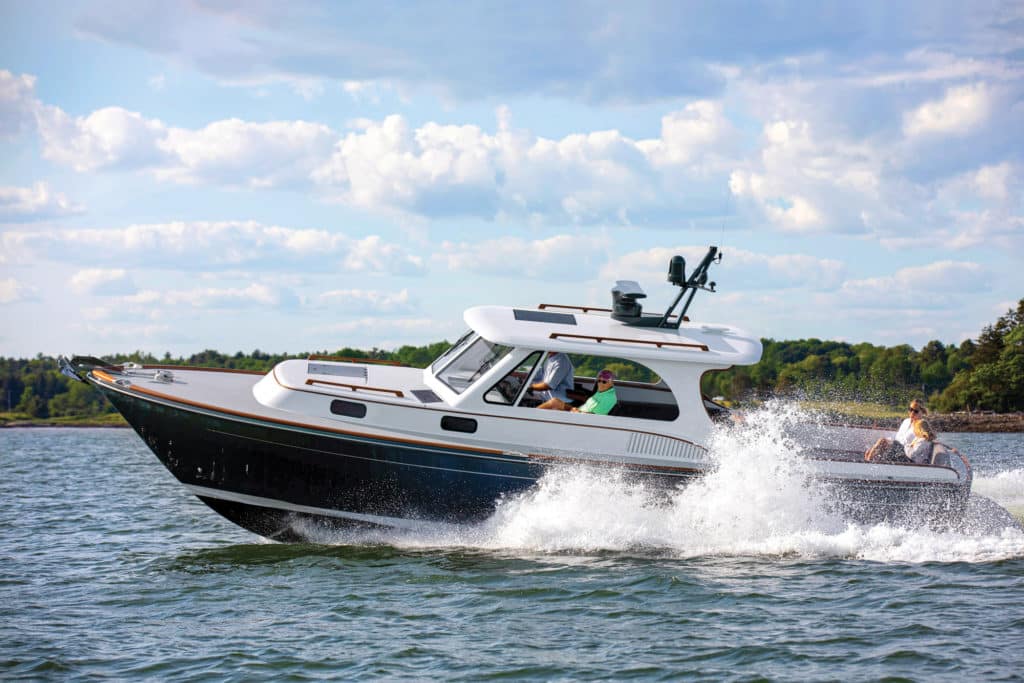
Quick Specifications
| 34’10” | |
| 11’6″ | |
| 350 Gal. | |
| 60 Gal. | |
| 19,000 lbs. |
Galeon Yachts 375 GTO
Even the remnants of Hurricane Ian, couldn’t dissuade the Galeon Yacht 375 GTO from its cruising mission. The small yacht’s wave-splitting hull form is paired to torque-filled 600 hp Mercury Verado outboards , giving this fun-in-the-sun boat a 47-knot top hop.
The 375 GTO is a speedster, to be sure, but it’s also so much more. Just about every aspect of the main deck seating is transformable and multifunction, from the aft seating to the alfresco dining abaft the helm, and beyond. It also has a family-size and eminently cruise-worthy belowdecks space for four guests, all while providing a foredeck entertaining lounge too.
The Galeon Yachts 375 GTO ticks all the boxes for an easy-to-handle and sporty cruiser.
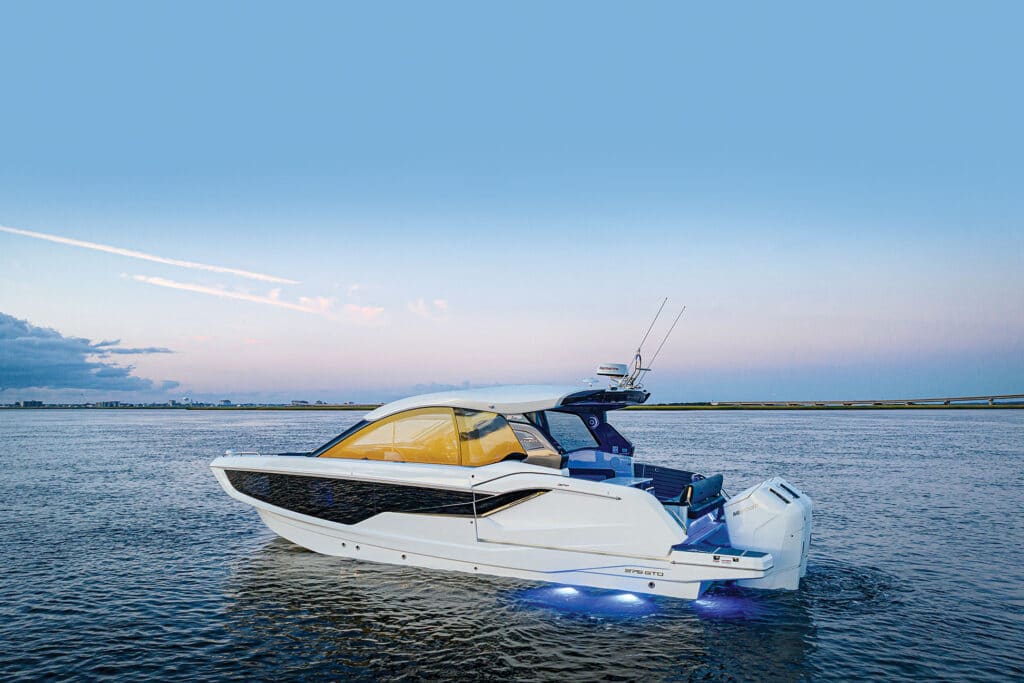
| 37’9″ | |
| 12′ | |
| 396.25 Gal. | |
| 53 Gal. | |
| 27,270 lbs. |
Aquila 42 Yacht Power Catamaran
Following the success of its 44-, 54- and 70-foot power catamaran models, Aquila has launched the stable-as-a-table, owner-operator-ready Aquila 42 Yacht Power Catamaran .
The Aquila 42 is the entry point into the builder’s yacht line and is noteworthy for its ability to accommodate anywhere from a two- to four-stateroom layout, depending on the owner’s cruising requirements. There are alfresco spaces to manage the sunset cruise with friends and family, including a foredeck lounge area that can be accessed via centerline steps from the flybridge. The Aquila 42 is available with several Volvo Penta diesel-engine options .
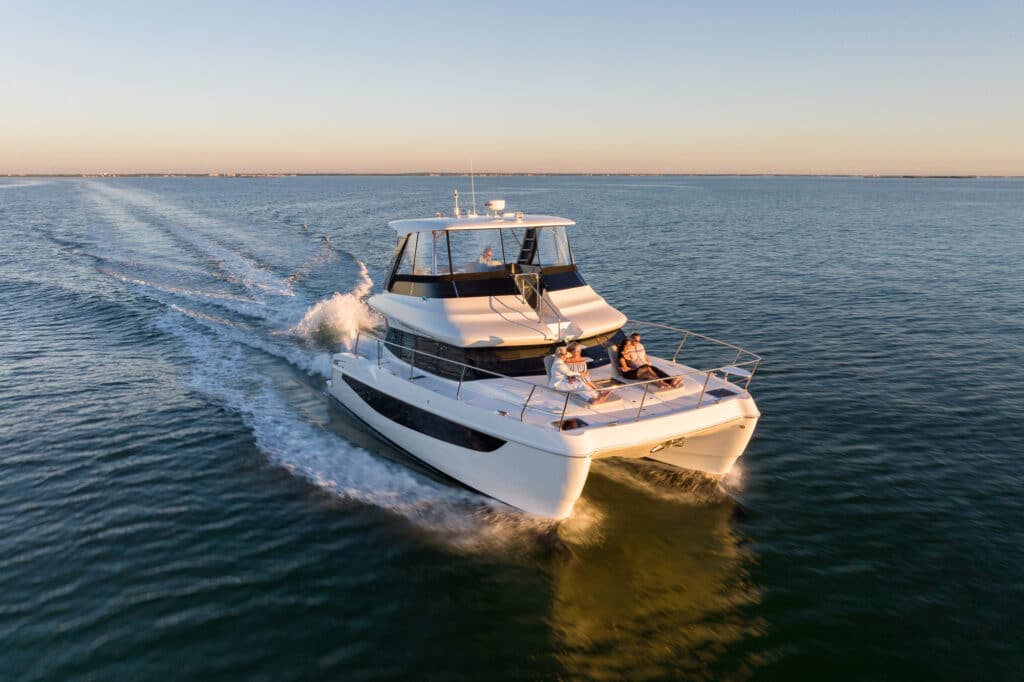
| 41’6″ | |
| 21′ | |
| 290 Gal. | |
| 132 Gal. | |
| 41,895 lbs. |
Azimut Verve 42
Want to cruise from Florida to Bimini in about an hour? The Azimut Yachts Verve 42 can do that thanks, in part, to triple 450 hp Mercury Racing outboards and a hull designed to dice-and-slice a seaway. Top hop: 45 knots. The Verve 42 also has style for miles with a fine entry, raked hardtop, and a razorlike sheerline accented by sweeping hull glass from bow to stern. It’s striking.
With accommodation for a family of four, the Verve 42 is also solid under the hull tokeep everyone safe on those passages. The Verve 42’s hull is built of fiberglass and uses vinylester resins for blister protection. The yacht’s deck and hardtop are comprised of carbon fiber for strength without added weight. This all means that the Azimut Verve 42 is built to CE Classification Type A , making it suitable for sea voyages where winds can exceed 45 mph and seas to 13 feet.
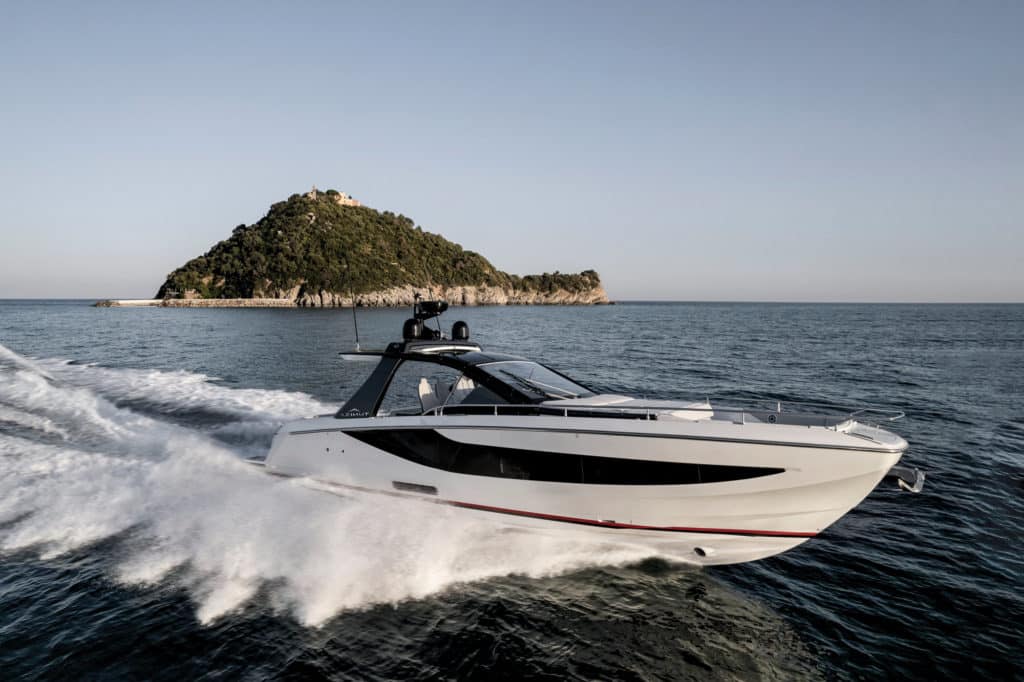
| 42’4″ | |
| 12’11” | |
| 462 Gal. | |
| 66 Gal. | |
| 30,865 lbs. |
Hinckley Yachts 35
The Hinckley Yachts 35 takes everything that yachtsmen like about this pedigreed-brand’s classic profile and infuses today’s modern outboard power to create 40 knots of sheer fun wrapped in sheer luxury.
This 35-foot Hinckley is built on a Michael-Peters-penned hull form with a fine entry, wider-than-average chines and a moderate deadrise. While the boat is built to sprint when desired, it’s also a relatively economical cruiser. For instance, a comfortable 24-knot cruise the Hinckley Yachts 35 has a 276-nautical-mile range.
It also has a tech-build thanks to vacuum-infused carbon-fiber composites and epoxy resin. An integrated interior structure is infused with the hull adding rigidity. The hull is then post-cured in an 80-foot oven, further strengthening the structure.
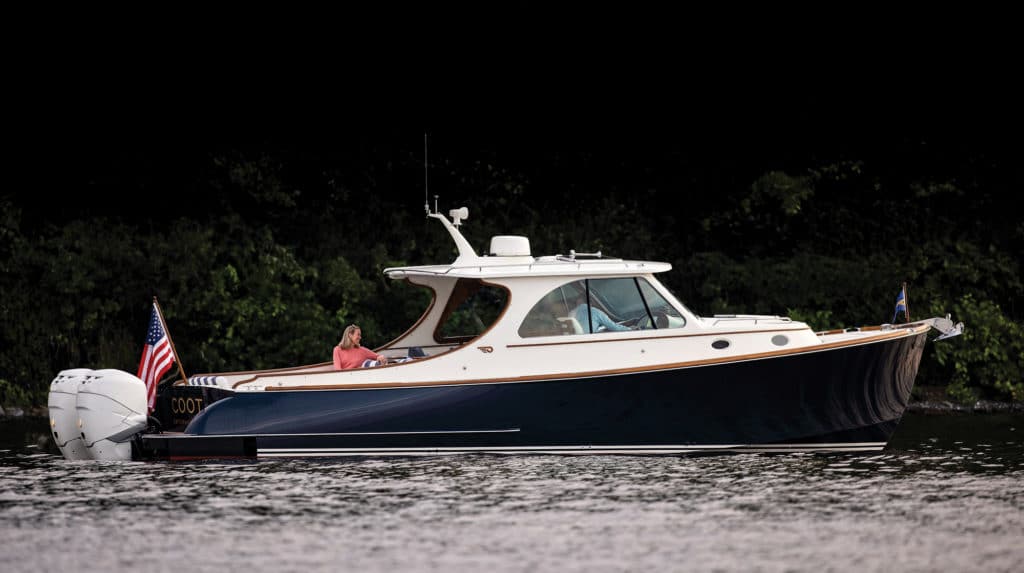
| 38’8″ | |
| 11′ | |
| 250 Gal. | |
| 35 Gal. | |
| 13,174 lbs. |
Beneteau Gran Turismo 45
The Beneteau Gran Turismo is the flagship of the builder’s four-model GT series, which also includes 32-, 36- and 41-foot models.
The Gran Turismo 45 ’s cruise-centric layout includes two staterooms and two heads belowdecks, as well as a galley down. There is also a dinette for meals and a settee for rainy-day lounging. Entertaining guests and enjoying the sun is the primary mission of the main deck.
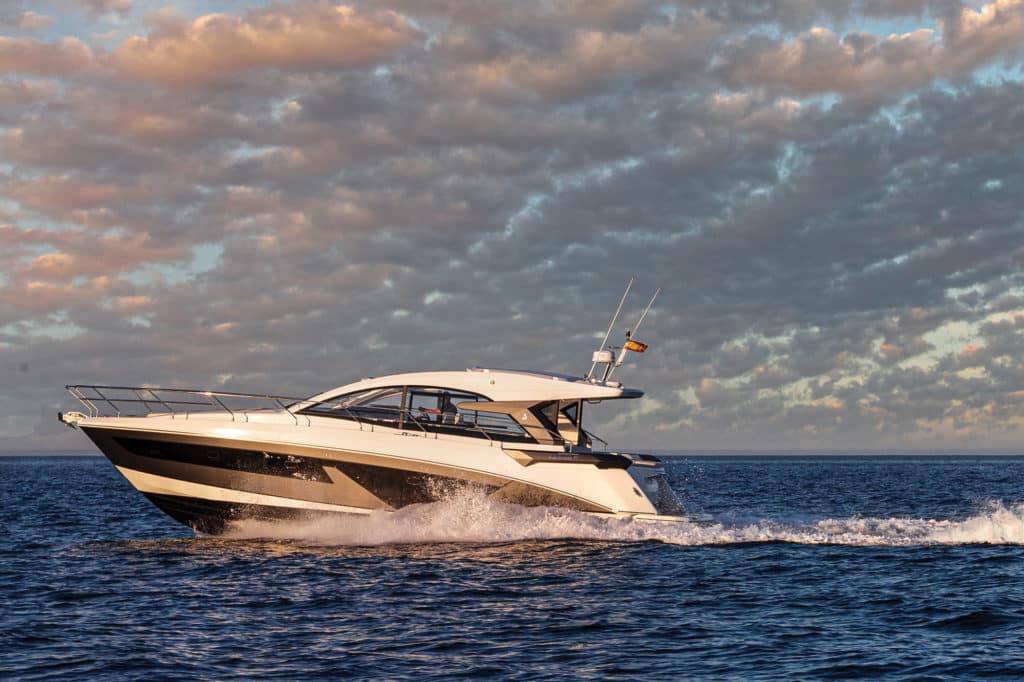
| 48’6″ | |
| 13’9″ | |
| 238 Gal. | |
| 106 Gal. | |
| 24,782 lbs. |
Solaris Power 48 Open
The Solaris Power 48 Open was the first powerboat from this longtime builder known for its sailing yachts, ranging from 40 to 110 feet length overall. The Solaris Power 48 Open is notable for its wave-slicing plumb-bow design, high freeboard forward and 32-knot-plus speed. Power is twin 480 hp Volvo Penta IPS650 diesels.
The high freeboard keeps the deck dry and help creates sizable volume belowdecks with an average 6-foot-6-inch headroom. This enables real estate for either one or two staterooms. With the single-stateroom setup, there is a forepeak master stateroom while an L-shaped settee converts to sleeping accommodations for family or occasional guests. Interior wood options are oak or walnut.
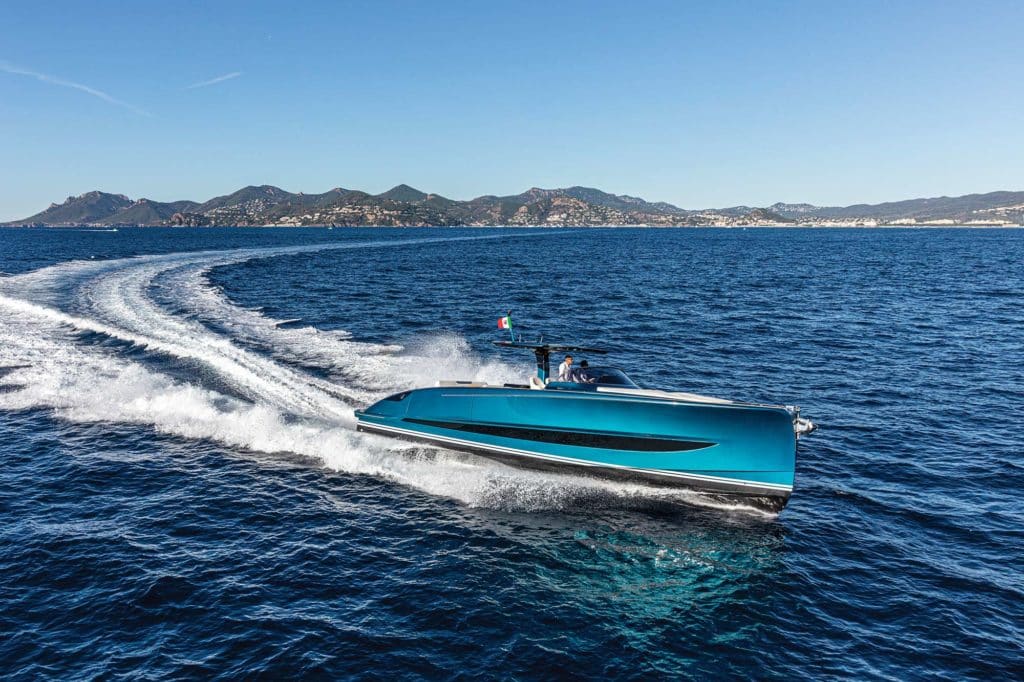
| 48’8″ | |
| 15’10” | |
| 396 Gal. | |
| 114 Gal. | |
| 37,037 lbs. |
Cruisers Yachts 42 GLS
Outboard-power cruising aficionados will appreciate the triple-engine options for the Cruisers Yachts 42 GLS . The 42 GLS we got aboard had the triple 400 hp Mercury Verados , which produced a top hop of 45 knots, but triple 450 hp Verados are available. Triple 350 hp Mercury Verados are the standard engine option. No matter the power arrangement, this express cruiser can easily be used for wakeboarding and tube towing. The 42 GLS is designed to handle the rough stuff too, with a fine entry and 21-degree transom deadrise.
For cruising enthusiasts, the 42 GLS has a master stateroom with an athwartships and a nearly queen-size berth, and the lower salon’s U-shaped dinette converts to a queen-size berth for the kids.
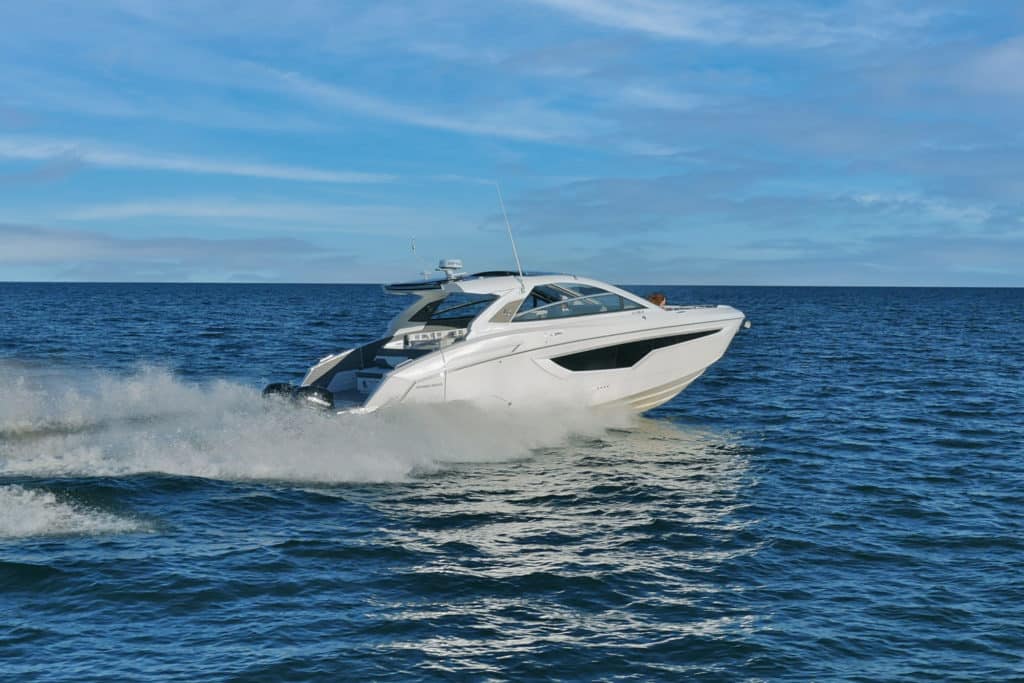
| 42′ | |
| 13′ | |
| 403 Gal. | |
| 50 Gal. | |
| 27,000 lbs. |
Back Cove 34O
Combining modern outboard power with classic Downeast styling, the Back Cove 34O touts award-winning standards with cruising in mind. The 34O is equipped with twin 300 hp Yamaha outboards, engines that allow the Newport International Boat Show’s 2018 Best Powerboat Under 35 Feet winner to travel up to 214 nautical miles at 24 knots on a 250-gallon fuel tank.
Belowdecks, the 34O has an island double berth and a split-head arrangement with the toilet to port and a separate shower stall to starboard. On the main deck, a U-shape dinette to port accommodates four or more guests on the Back Cove Yachts vessel. The 34O’s galley is equipped with a Cuisinart microwave, a two-burner Kenyon electric cooktop and a Vitrifrigo fridge and freezer.
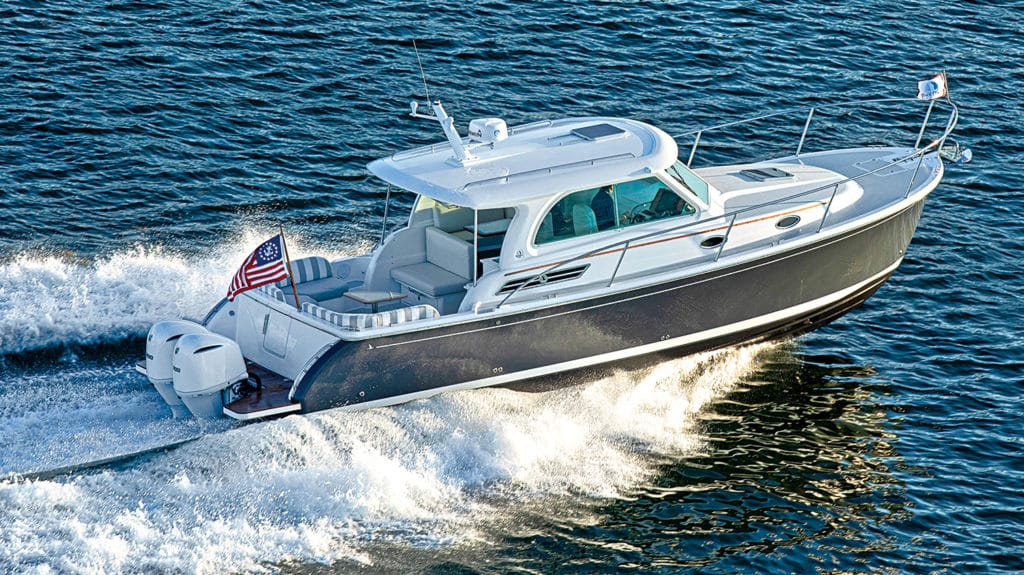
| 38’11” | |
| 11’10” | |
| 242 Gal. | |
| 60 Gal. | |
| 17,000 lbs. |
Picnic Boat 40
Hinckley Yachts unveiled its first Picnic Boat more than two decades ago. Now, after two previous, sub-40-foot models, the Maine-based boatbuilder has developed its largest and most advanced model to date: the Picnic Boat 40.
Twin 480 hp Cummins diesel engines paired to twin Hamilton 322 jet drives propel the yacht to a 30-knot cruising speed and 34 knots on the pins. With optional twin 550 hp Cummins diesels, cruise and top-end speeds jump to 35 and 38 knots, respectively.
There is an L-shaped settee with a table and a wet bar on the main deck to port. The helm station is forward and to starboard with a benchseat for two. There is also a companion seat across from the helm. Belowdecks, there is 6-foot-2-inch headroom, and the dinette table drops to form a California-king berth for overnights and weekending.
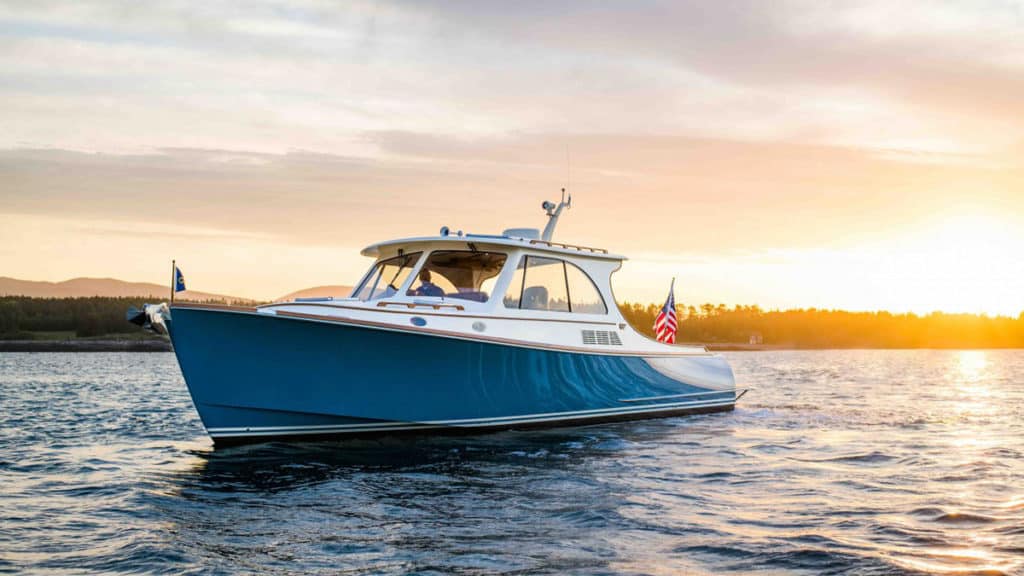
| 42′ | |
| 12’10” | |
| 375 Gal. | |
| 80 Gal. | |
| 25,000 lbs. |
Aquila Power Catamarans started its line with 44- and 48-footers, and now the builder’s Aquila 36 takes the line into the midsize market.
The 36 features a single, main-living area from bow to stern, helped in part by the vessel’s 14-foot, 7-inch beam. The boat can comfortably seat up to 20 guests for fun on the salt. Several Mercury Verado engine options are available for the Aquila 36, including twin 250-, 300- and 350-hp four-strokes. With the 350s, the Aquila has a top-end speed of 37 knots.
Other notable features include a fiberglass hardtop, a dinette, a cooktop, a fridge, a sink and a smokeless grill. Belowdecks, there are two staterooms with nearly queen-size berths, en suite heads and 6-foot-6-inch headroom in each.
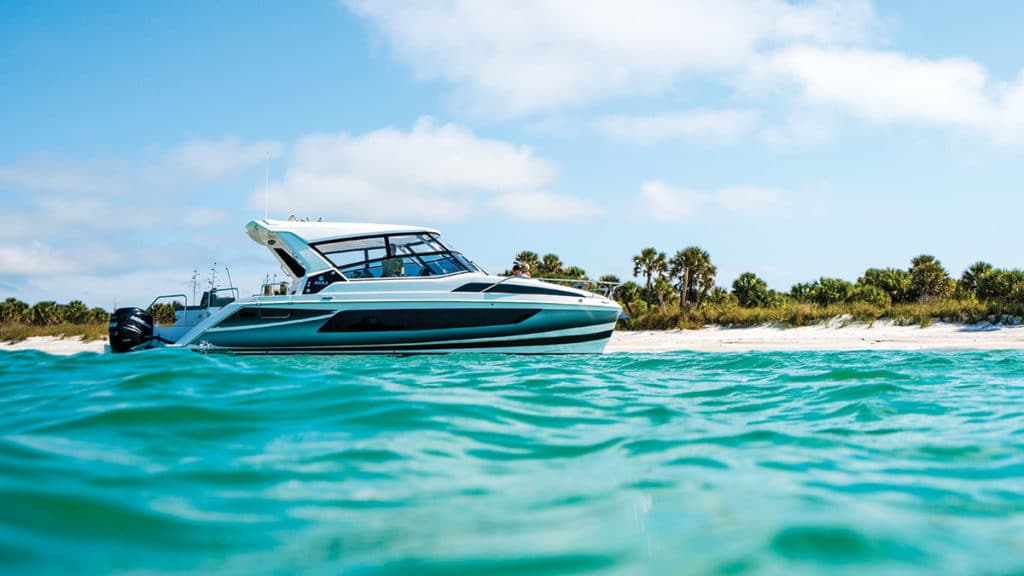
| 36′ | |
| 14’7″ | |
| 330 Gal. | |
| 52 Gal. | |
| 21,572 lbs. |
Boston Whaler 350 Realm
From fishing and entertaining guests to diving and overnight cruising, Boston Whaler ‘s 350 Realm is a multitasker. And it’s fast, too. It’s powered with either triple 300 hp or triple 350 hp Mercury Verados. The 350 Realm can reach a top speed of 46 knots.
At the helm, two Raymarine displays provide vital navigation data. The captain can take in the displays’ view from a doublewide helm seat. There’s a flip-down platform for standing when needed and a footrest when desired.
There is a V-shaped berth that converts into a double berth with a filler cushion. The separated head has a VacuFlush MSD and a hot-and-cold shower. Owners also have the option to add a microwave and a flat-screen TV.
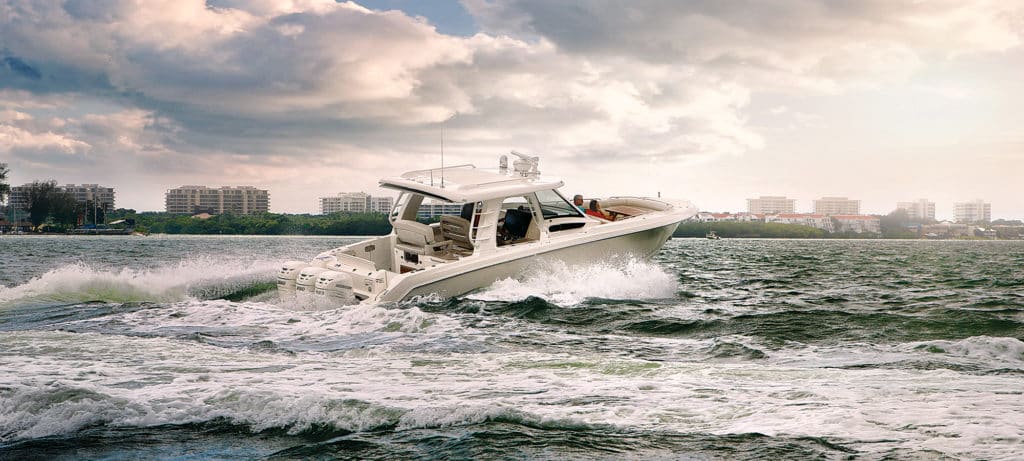
| 35’6″ | |
| 10’10” | |
| 385 Gal. | |
| 45 Gal. | |
| 18,830 lbs. |
The MJM 35z can reach a top speed of 44 knots and a cruising speed of 33 knots on its optional 350 hp Mercury Verado outboards; twin 300 hp outboards are standard on this MJM Yachts vessel. Additionally, the 35z can travel up to 304 nautical miles on its 250-gallon fuel tank.
The 35z has a flush-deck layout and to port is space for an electric grill, a baitwell, a sink, an ice maker and a fridge. There are two Stidd helm seats—one for the helmsman and the other for a copilot—that rotate to face the rest of the seating aft. In the cabin is V-shaped seating forward that can be converted to a berth.
Owners also have the option of adding a Seakeeper 3 gyrostabilizer and a full-length Bimini top to shade the cockpit.
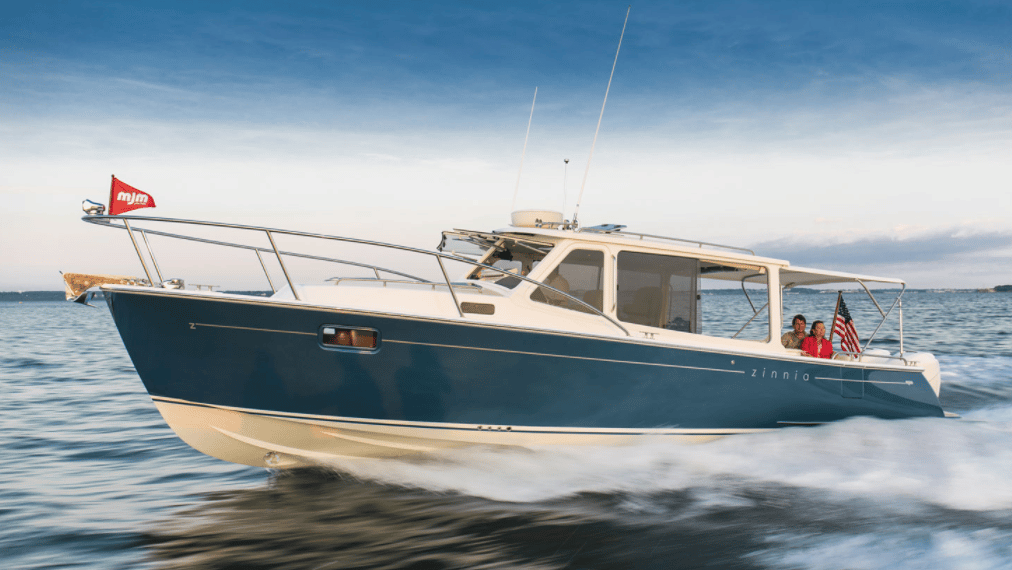
| 38’3″ | |
| 11′ | |
| 250 Gal. | |
| 58 Gal. | |
| 13,279 lbs. |
Greenline 39
Greenline Yachts ‘ vessels are aptly named for their environmentally friendly means of moving about; the Greenline 39 is no different. The Slovenian yacht manufacturer produces two types of this model: hybrid and solar.
If owners opt for the latter, the 39’s four solar panels atop the salon power all of the vessel’s systems for three hours. With the power of the sun, the 39 can achieve a max speed of 6.5 knots and a cruising speed of 4 knots. The hybrid type uses those same panels to help power a 220 hp Volvo Penta D3 with a Mahle electric-drive system. Owners have the option of replacing the standard engine with a 370 hp Yanmar 8LV diesel.
Belowdecks, scissor berths provide accommodations for long weekends.
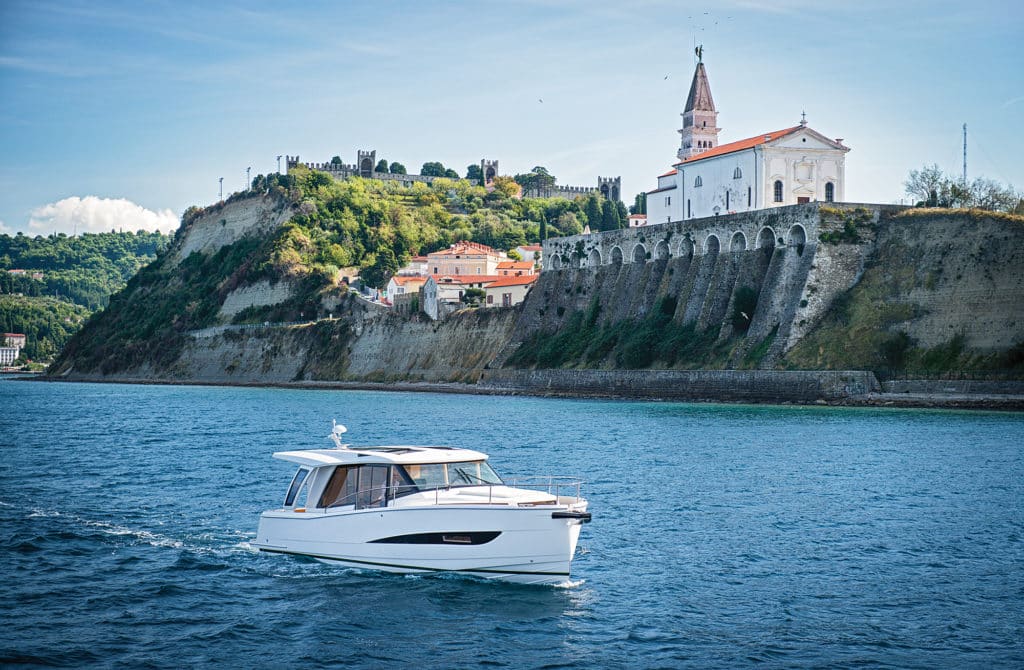
| 39’5″ | |
| 12’4″ | |
| 185 Gal. | |
| 105 Gal. | |
| 15,432 lbs. |
- More: Center Consoles , Express and Flybridge Cruisers , Tenders , Yachts
- More Yachts
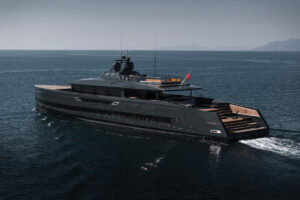
Alia Yachts to Debut SAN Superyacht in Monaco
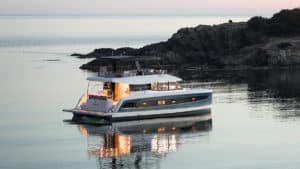
Discover the Top Power Catamarans for 2024
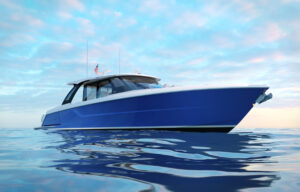
Coming Next Year: Tiara Yachts 56 LS

Top Nine Fishing Tenders For 2024
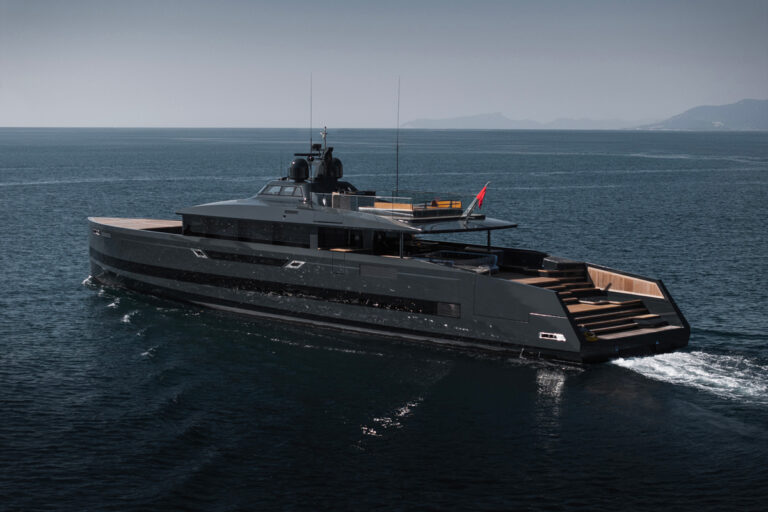
Top Bar Harbor Maine Sights For Visiting Cruisers
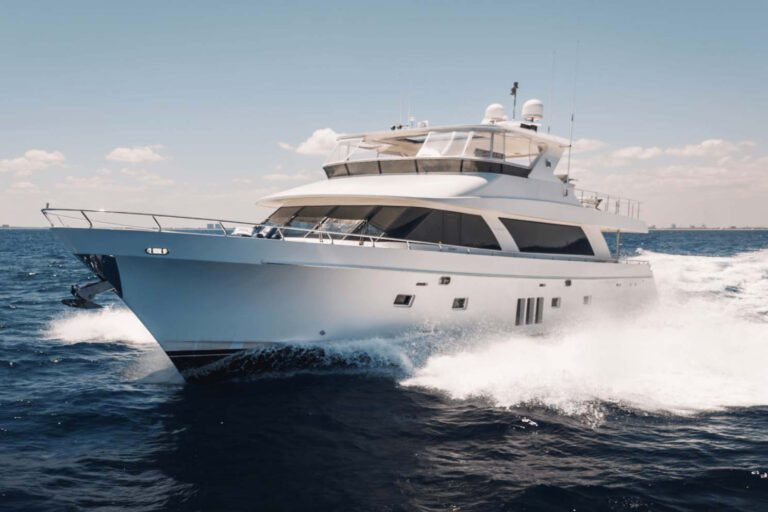
Always In Style: Ocean Alexander 85E For Sale
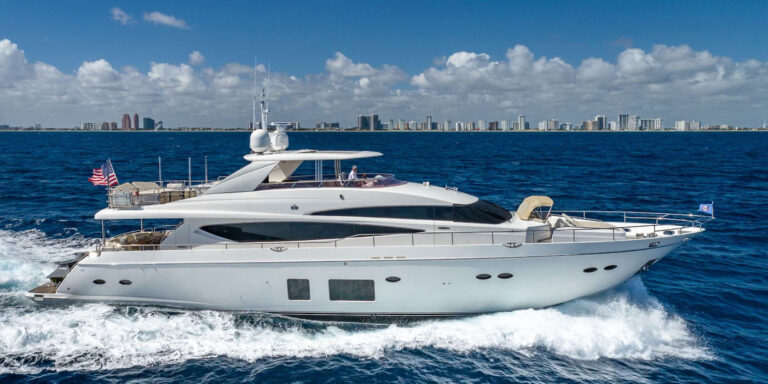
Spend Thanksgiving on a Yacht

- Digital Edition
- Customer Service
- Privacy Policy
- Terms of Use
- Email Newsletters
- Cruising World
- Sailing World
- Salt Water Sportsman
- Sport Fishing
- Wakeboarding
Best Boats for Ocean Boating
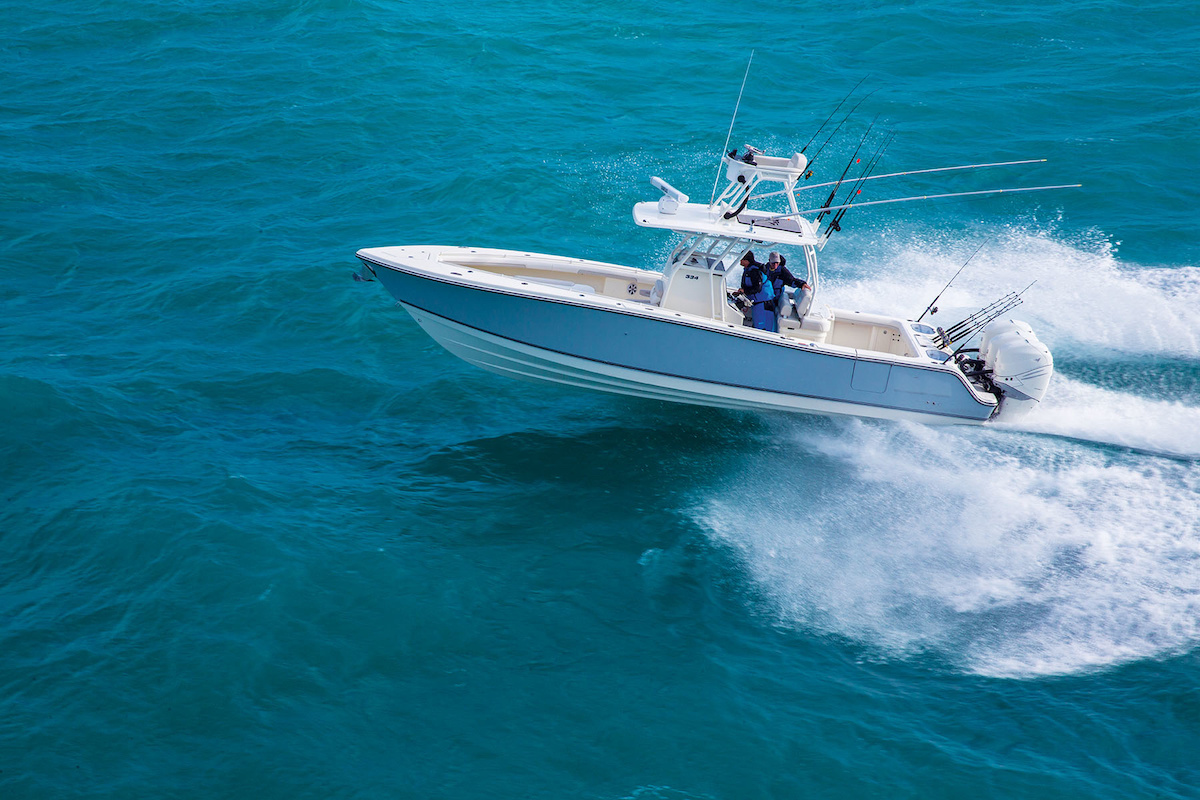
9 Best Ocean Boats
- Cabin Cruisers
- Center Consoles
- High-Performance Boats
- Motor Yachts/Power Cruisers
- Multi-Hull Powerboats (Catamarans)
- Sportfishing Yachts
- Walkarounds
Obviously, this is a wide range of boat types and which will be your personal best choice depends on how you plan to use your boat. If you enjoy saltwater fishing and you dream about hunting down huge pelagic trophy fish, this list of choices shrinks to include center consoles, sportfishing yachts, and walkarounds. But if you just want to go on dolphin- or whale-watching cruises or head down the coast to a new destination, one of the other types of boats will probably be a better pick.
In all of these cases, however, one thing’s for sure: you want to feel safe and confident in your boat’s abilities. To that end, there are some specific attributes any vessel needs if you plan to use it for ocean boating.
Explore Saltwater Fishing Boats
Must-Haves for Boating on the Ocean
First and foremost, any boat that goes through an inlet and into the ocean must be large enough and seaworthy enough to safely handle the conditions .
Just exactly what this means is a judgement call, because boating in the ocean can vary dramatically depending on the location and the weather. Wind speed, sea state, and the potential for storms (see Boat Handling: Riders on the Storm , to make sure you know what to do if you get caught in a sudden squall) all play a role in determining whether or not any boat can safely venture out into the ocean on any given day. That’s why checking the latest weather forecasts and paying close attention to changing conditions is absolutely critical. So, how can one say which are the best boats for ocean boating, in this regard? You simply can’t—the correct answers change from day to day and place to place.
Being properly equipped with safety, communications, and navigational gear is another necessity.
You can check out Boat Safety Checklist & Safety Equipment to see the must-haves as well as recommended safety gear, but in addition, most experienced captains would agree that a VHF radio should be on each and every boat entering the ocean. Naturally you also need to have a full understanding of how to use it; see How to Use a VHF Radio , to get the scoop. And remember that when you’re in the ocean, losing sight of land is almost always a possibility be it due to distance, haze, or fog. In any case you’ll need to be able to find your way back to that inlet, so GPS should also be considered a must-have. In fact, it’s critical for anyone captaining a boat in the ocean to have a firm grasp on how to navigate a boat with and without the assistance of electronics.
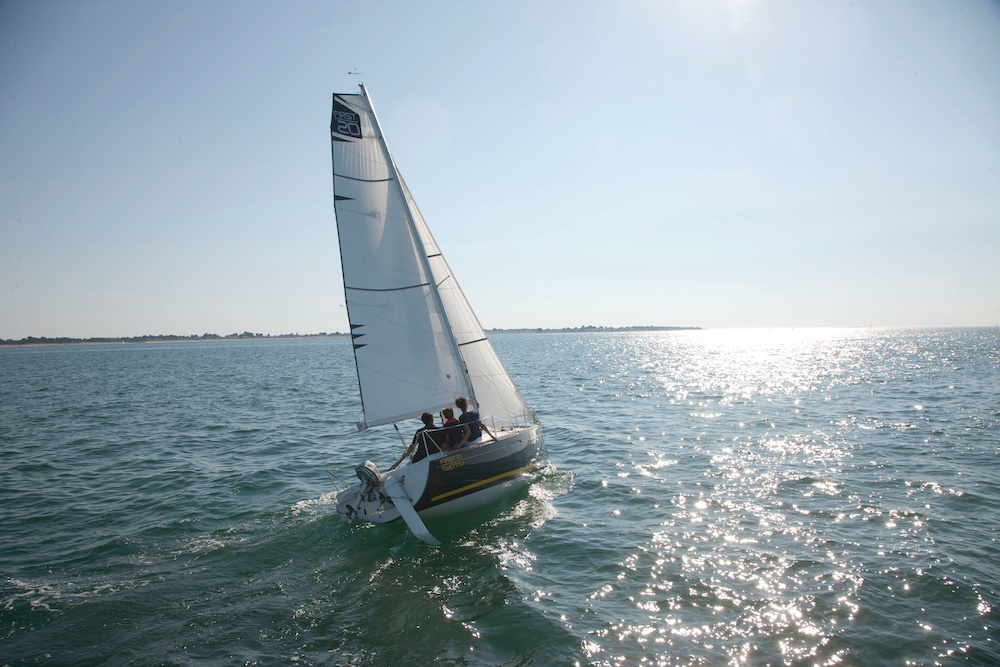
Another critical factor for boats used in the ocean is that they’re designed and built with corrosion-resistant hardware.
Most of the boat types we’ve listed above will have stainless-steel fittings and fasteners, but if you take a boat that was intended for freshwater use and put it in the ocean, you’ll likely have corrosion streaks and deteriorating hardware starting on day one. In just a season or two, serious damage can occur.
Fuel economy and fuel capacity also become important issues to consider when ocean boating.
Remember, the ocean is essentially limitless when you’re on a boat, and while a boat may be perfectly competent to take offshore, some will burn a lot more fuel than others doing so. There are many high-performance boats, for example, that are designed for offshore racing, can handle heavy seas, and are equipped to navigate beyond sight of land. But those big engines need to be fed lots of fuel, and this can mean range restrictions. If the captain miscalculates his or her range, running out of fuel is a much bigger problem than it would be ashore. On the flip side of the equation, some sailboats can travel for literally thousands of miles while requiring little to no fuel. When calculating range for your own boat, most experts advise accounting for a bare minimum of 10-percent of fuel capacity in reserve, and some suggest it’s safest to plan in as much as one-third in reserve.
What are the Best Boats for Ocean Boating?
As is usually the case when it comes to boating in general, the answer to the above question will be different from one person to the next. But we can say one thing for sure: if you have a boat that’s appropriately sized, designed, built, and equipped for ocean boating, you should consider giving it a try. Because the experience of fishing, cruising, or just observing nature outside of the inlet is an amazing adventure that many people in this world never get to enjoy—and that’s one more reason why the boating life is indeed a better life.
Read Next: Best Family Boats
You Might Also Like:
- Best Boats for Beginners
- Best Small Sailboats for Beginners
- When is the Best Time to Buy a Boat?
- The Ultimate Boat Buyer's Guide
- Small Boats: What Are My Options?

Join Our Newsletter!
Get community news, buying bargains, and how-to guides at your fingertips.
Most Seaworthy Boats Under 30 Feet (What Are The Best Options?)

August 30, 2022

If asked about the most seaworthy boats, you would think of giant cruise and cargo ships. But what are the most seaworthy boats under 30 feet?
The most seaworthy boats tend to be quite large as longer and wider boats offer more stability at sea. But not everyone needs something as big as a super yacht to have fun and feel safe out on the open ocean, and smaller boats are definitely a lot more accessible to the average person. So what are the most seaworthy boats under 30 feet?
Some of the best and most seaworthy boats under 30 feet are:
- The Boston whaler 280 outrage
- Blackfin 272CC, the Hunter 27
- And the cape dory 28
All of these boats offer everything you’ll need to have a great time on the water. There are lots of things to consider when measuring how seaworthy a boat is. So what exactly makes a boat seaworthy, and what are some of the most common types of boats under 30 feet that are considered to be seaworthy? If you’re thinking about buying a boat, these are all things that you can really benefit from knowing, and if not, it's always good to learn something new.
Growing up in a small coastal town in Massachusetts, I spent a lot of time navigating the coastal waters of the surrounding area. Though I prefer sailing, there is no shortage of quality, seaworthy boats, both sail, and motor, that are perfect for spending time on the sea.
Table of contents
what makes a boat seaworthy.
There are lots of different factors to consider when thinking about how seaworthy a boat is; however, the two most important factors are stability and durability.
Boat stability can be defined as the boat's ability to right itself or come back to an even keel after something like the wind or a wave has caused it to roll to one side. This ability of the boat to stop itself from keeling over in rough conditions is incredibly important to any seaworthy vessel.
There are lots of different elements that affect how stable a boat will be, including the center of gravity, the center of buoyancy, and the general shape of the hull.
When calculating the stability of a boat, the center of gravity and the center of buoyancy is incredibly important. The center of gravity of an object is essentially the center of its mass. If you were to support the object from just this, it would balance perfectly, remaining in equilibrium. The center of buoyancy, on the other hand, is the center of mass of the water displaced by the vessel.
These forces of gravity and buoyancy push in opposite directions from these points, gravity pushing the boat down and buoyancy pushing it back up. When the boat is completely level, the center of gravity will be directly under the center of buoyancy. These two forces pulling in opposite directions ensure that the boat stays level.
However, if another force is applied to the boat, the centers of gravity and buoyancy can shift. Imagine a wave hits the side of the boat, causing it to lean in one direction. The farther the boat leans to one side, the closer the center of gravity and center of buoyancy come to one another.
As long as the center of buoyancy remains above the center of gravity, the forces of gravity and buoyancy will push the boat back up to a stable position. However, if the boat leans far enough to the side the center of buoyancy is below the center of gravity, causing the boat to be unstable and capsize. This is why it's so important for a boat to have a low center of gravity.
The shape of the hull also has also affected the stability of a boat, especially when the boat is heeled at a low angle. In general, boats with wider hulls are more stable. However, if you go overboard with this, a very wide boat without a center of gravity far below the water level is a recipe for disaster, as it will be much easier to capsize than it would be for a boat with a thinner hull and lower center of gravity.
Another very important factor to consider when determining the seaworthiness of a boat is its durability. Essentially, how unsinkable is the boat? Can it take a lot of damage before it will sink or will only minor damage cause catastrophic failure?
Unfortunately, for boats around 25 to 30 feet, durability can be quite a bit issue. As you know, in order for a boat to stay afloat, it has to displace its own weight in water, a boat's ability to do this can be easily compromised with even the smallest amount of damage.
Normally smaller boats under 20 feet contain a lot of foam in the hull to help keep the boat afloat if damaged. Larger boats do this as well, but they also employ the strategy of compartmentation in their designs. Basically, if the hull is divided into enough separate compartments, damage to one part of the hull isn’t much of a big deal. If one compartment is filled with water there are still plenty of others that aren't, allowing the boat to stay afloat and get back to shore.
Unfortunately, boats between 25 and 30 feet are likely to lack the necessary foam and compartmentation needed to keep them afloat if the hull is damaged. Even the smallest of holes form in the hull could cause the boat sink quickly. Because of this, it is often boats that are smaller than 20 feet and much longer than 30 feet that are the hardest to sink, leaving boats in the middle to have a higher risk of being catastrophically damaged than the others.
Most boats also have bilge pumps that allow water that collects in the bilge, the bottom of the inside of the hull, to be pumped out. This can help keep the boat afloat by removing much of the water that's been taken on over time. This allows the boat to better maintain its ability to displace its own weight.
In all, it is incredibly important that the boat is able to take the harsh beating that the sea will inevitably give it. The structural integrity of the boat must not be easily compromised by the abuse it takes, and the hatches and windows need to be just as strong and watertight to be truly seaworthy.
Other Factors That Can Affect Seaworthiness
Water shedding, reserve buoyancy, speed, and the design of the helm are a few more things to consider when talking about the seaworthiness of a boat.
For boats with self-bailing hulls that use gravity as opposed to a water pump to remove water, the ability for the boat to shed water is critical. If you get hit with a wave and water comes on board, you’ll want to be sure that the boat is able to rid itself of the extra water as quickly as possible.
Reserve buoyancy is also an essential thing to consider. Your boat may sit high on the water without any gear, fuel, or passengers on board; as the boat is loaded up, it will sit lower and lower in the water. This is incredibly important to be aware of as reserve buoyancy is integral to the stability of the boat.
The speed capabilities of the boat can also be crucial if you end up in a bad situation. An incoming storm may be able to be outrun by a faster boat, but in a boat with a speed of only 10 to 15 knots, it will be nearly impossible to get out ahead of the storm. Speed can also help you dodge waves and gives you increased control of your location and water conditions.
In addition to those aforementioned, the design and setup of the helm is another significant factor in the seaworthiness of a boat. The most important thing here is all-around visibility. Simply being able to see straight ahead doesn’t help you achieve the necessary overall situational awareness needed when piloting a boat in rough conditions.
The helm should also be equipped with the necessary electronic systems required to safely and efficiently pilot the boat. Water depth and GPS information should be easily accessible and the radio should be easily operable from one singular position around the wheel. An intelligently designed helm can really improve the overall seaworthiness of a boat.
What Types Of Boats Under 30 Are The Most Seaworthy?
If you were asked about what you think the most seaworthy boats are, there is no doubt that you would immediately think of some sort of giant, an ocean-crossing ship like a cruise ship or cargo ship. At the very least, you’ll think of some type of large yacht, most likely over 50 feet in length. In either case, the common link is that the boats you normally think of as being particularly seaworthy are also much larger than 30 feet in length.
So then, what types of boats are most commonly considered seaworthy while remaining under that 30 feet mark? Fishing boats and sailboats are two that immediately come to mind. While it would be inadvisable to cross the Atlantic in one of these boats, at least not without a lot of experience and preparation, fishing boats and sailboats alike are built durably enough to withstand the immense battering that the ocean can shell out while still oftentimes being under 30 feet.
Because sailboats and fishing tend to be the most seaworthy at this length while also being so vastly different from one another, I will be talking about the fishing boats that I deem to be the most seaworthy first, and will then list the most seaworthy sailboats after that.
The Most Seaworthy Fishing Boats Under 30 Feet
As mentioned before, fishing boats are among the most common seaworthy vessels under 30 feet, so I will be sharing the fishing boats that I deem to be the most seaworthy first.
1. Boston Whaler 280 Outrage
Coming in at 28 feet in length, the Boston Whaler 280 Outrage is an incredible boat for anyone looking to buy one of the most seaworthy offshore fishing boats. The boat is incredibly powerful, coming standard with two 250-horsepower Mercury Verado outboard engines. If you’re willing to shell out a bit of extra cash, these engines can be upgraded to two 400-horsepower engines that allow the boat to reach about 65 mph at full throttle.
Boston Whaler is known for making their boats unsinkable, and the 280 Outrage is no different, only adding to the seaworthiness of the vessel. The 280 Outrage is constructed using materials that float, so even if you take on water or damage the hull of the boat; it will stay level above the water. However, even if water does come on board, there's no need to worry as this boat’s self-bailing deck will shed the water in an instant.
As you would hope with any fishing boat, the 280 Outrage is packed to the brim with all the amenities you’ll need to have a successful fishing trip. The boat is equipped with 14-rod holders located all around the boat and also includes two 54-gallon fish boxes to store what you reel in. The inclusion of a convenient bait-prep area and tackle storage drawers adds to the utility of this incredibly seaworthy fishing boat.
2. Blackfin 272CC
At 27 feet and 2 inches, the Blackfin 272CC is almost a whole foot shorter than the Boston Whaler, but this doesn’t mean it's any less seaworthy. Easily the best-looking boat on this list, the 272CC’s design philosophy of utility and comfort really shine when you’re on this boat.
Boasting up to 600 horsepower, this boat has more than enough power to get up above 60 mph, and its hull remains stable in even the toughest of waters. The boat won’t leave you feeling uncomfortable either as many other fishing boats might. The seats at the helm and forward bow are beautifully designed and largely outmatch all of its competitors in the comfort department, so you know that your family won’t get restless the next time you take them out on the water.
Of course, as a fishing boat, you can still expect the boat to have all of the things necessary to aid you on your next fishing trip. The 272CC has 8-rod holders, two 54-gallon fish boxes, a 30-gallon bait well and a 5-gallon bait bucket. Though not quite as many rod holders as the aforementioned 280 Outrage, you can also upgrade and get six additional hardtop rod holders that can bring the total to 14.
The Most Seaworthy Sailboats Under 30 Feet
Though the aforementioned fishing boats are worth consideration for anyone looking for the most seaworthy boats under 30 feet, I’ve always been much more of a sailor myself, so here are the sailboats I think are the most seaworthy.
1. Cape Dory 28
Coming in at 28 feet and 9 inches, the Cape Dory 28 is a classic sailboat with unmatched seaworthiness. In fact, to prove how seaworthy this boat is, in 2009, a sailor named Fred Bickum successfully circumnavigated the earth, a voyage that took him three years in his 1978 Cape Dory.
Produced from 1975 to 1988, the Cape Dory 28 is still one of the most rugged and sought-after sailboats today. Designed by Carl Alberg, the Cape Dory combines classic design elements with comfort, durability, and spaciousness. When onboard, this bout truly feels much bigger than it actually is, even when compared with many modern 28-foot sailboats.
The build quality of this boat is unrivaled, with solid fiberglass in polyester resin hull and decks made from balsa and plywood-cored fiberglass. However, though its construction is solid, if not properly maintained over the years, osmotic blistering in the hull and water absorption through stress cracks in the deck can cause the structure of the boat to be weakened. Bronze is used for most of the fittings around the boat and the 8 opening ports, which adds to the classic look of this sailboat.
Under sail, the Cape Dory 28 is incredibly capable in harsh waters and in conditions with choppy water or low wind; the boat still maintains the ability to move a lot more quickly than many other similarly sized sailboats.
The spaciousness of the Cape Dory’s interior is also one of the big selling points, especially for a boat this old that can still compete with newer models. It features a V-berth bed and a cockpit with wheel steering that can comfortably fit six adults, as well as a galley and bathroom equipped with a toilet and shower. The interior cockpit is especially useful if you run into stormy weather as you can easily escape the harsh outside conditions and still maintain control of the boat.
2. Hunter 27
Also coming in at 27 feet and 2 inches, the Hunter 27 is a great seaworthy sailboat for anyone from beginner sailors to seasoned veterans. First introduced in 1974, the Hunter 27 has stood the test of time and is still one of the most popular sailboats to this day.
The Hunter 27’s lack of customization and standardized construction means that the price of this boat is much lower than many others, but don’t even begin to think that this boat is built poorly as the hull is strong enough to handle whatever the ocean throws at it. The boat is shipped with a mainsail and 110% genoa, offering an average amount of square sail footage for a boat its size and features wheel steering, something much more commonplace on a larger boat.
The Hunter 27 handles great under sail, but even if winds are particularly weak or you’re simply feeling a bit lazy, you won’t have to worry about being stranded. Since 1979 this boat has come standard with a reliable 14-horsepower Yanmar diesel engine. Though this won’t get you moving at groundbreaking speeds, it's enough to keep you moving if you need it to.
The boat also provides all the space you’ll need when spending multiple days on the water. The Hunter 27 includes a comfortable cabin, a saloon with enough seating for six centered around a table, a solid galley, and a toilet and shower, all wrapped up in this compact package.

What's The Fastest Boat That Has Crossed the Atlantic Ocean?

Is Motion Sickness Worse In The Front Or Back Of A Boat?

Sailing As A Sport: An Overview Of Its History And Evolution

How Do Boats Float?
This article may contain affiliate links where we earn a commission from qualifying purchases. The images and content on this page may be created by, or with the assistance of, artificial intelligence, and should be used for entertainment and informational purposes only.
About THE AUTHOR
Brian Samson
I have a deep love of houseboating and the life-changing experiences houseboating has brought into my life. I’ve been going to Lake Powell on our family’s houseboat for over 30 years and have made many great memories, first as a child and now as a parent. My family has a passion for helping others have similar fun, safe experiences on their houseboat.
Trending Now

How Fast Does A Shipping Boat Go?

Mastering Boat Steering Techniques: From Rudder to Tiller

Is A Ferry A Type Of Boat? (Everything You Need To Know)

What Is The Gunwale On A Boat?
After spending over 30 years on houseboats, the memories and knowledge we've gained will never fade. Learn from our experiences here on LakeWizard. You can read more about us and our team, here .
©2024 LakeWizard. All rights reserved.
You can email us at [email protected]
LakeWizard.com is a participant in the Amazon Services LLC Associates Program, an affiliate advertising program designed to provide a means for sites to earn advertising fees by advertising and linking to Amazon. This site also participates in other affiliate programs including but not limited to ShareASale, CJ, and ClickBank, and is compensated for referring traffic and business to these companies.
The Best Center Console Boats for Rough Water

No one likes being knocked around in rough water. Even less so when you load your family and friends on board.
If you’re going to buy a center console boat, it’s inevitable that you’ll often find yourself in some variable conditions. It’s just the nature of the beast. May as well do yourself a favor and choose a boat that can take some abuse while keeping you comfortable at the same time.
I’ve put together a list of some of the best riding center console boats in the industry. The boats on this list vary in size, but they’re all top-notch choices in their respective classes for handling rough seas. I’ve categorized them by size in order to simplify things.
Also, it goes without saying, but just to be safe: Always know the limitations of your boat and your skills as an operator. Just because one boat rides better than another in “rough water” doesn’t mean that it’s safe to take on Poseidon’s fury.
Research on, my friends! This should get you started on your way to finding the right fit.
Under 25ft Center Consoles for Rough Water
This is the smallest Center Console group on the list. I’m sticking between 20-25ft for this one, as I personally don’t recommend the vast majority center consoles under 20ft in rough seas.
If you’re on the fence about a 20ft+ boat and you plan on going anywhere near rough seas, go ahead and save some extra money to make the jump. The comfort and (more importantly) safety is 100% worth the extra money.
Regulator 23
Spoiler Alert: Regulator will make more than one appearance on this list. Regulator builds an outstanding boat and they are borderline legendary for their comfortable ride in rougher seas.
The Regulator 23 is no exception.
This center console measures in at 23’5″, but don’t let its size trick you into believing it’s a small boat. It looks and feels much bigger than it really is, making it a pound-for-pound beast in rough waters.
The 23 can take whatever you can throw at it within reason. It has absolutely no problem outclassing plenty of boats that, on paper, measure far bigger. The build quality is awesome and features some of the best stringer construction on the market- perfect for taking offshore abuse with a smile.
If you want a sub-25ft center console that can take some heat, it’s extremely, extremely hard to beat the Regulator 23.
Everglades 255
Everglades makes a really nice boat and the 255 is a great entry into the world of offshore center consoles
The 255 is compact, but has a deep-V hull that does a great job of slicing through rough seas. Definitely a sturdy vessel and the craftsmanship is awesome. From the hull design to the strategically-placed handles to grab onto when things get dicey, there’s a lot to like when the 255 goes offshore.
As with any Everglades boat, there’s also the top-tier style factor. The 255 looks and feels premium all over. Everglades fit, finish, and style is well known. And for good reason.
Like the 23 Regulator, the Everglades 255 is a relatively small center console that can truly outclass many bigger boats.
25ft to 30ft Center Consoles for Rough Water
This is the size range that starts getting much more comfortable. Options starting opening up much more from here. For rough seas, I recommend at least making the jump from sub-25ft to 25ft-30ft.
Blackfin 272
I love Blackfins. They are basically bombproof with all of the creature comforts you could ask for in a center console fishing boat.
The Blackfin 272 carries on the time-honored Blackfin tradition of beastly boats. This thing is a machine and it performs and performs. You’ll beat the snot out of yourself long before the 272 is ready to quit.
The 272 is also beautiful. It’s sleek all over with a fit and finish to match. From the hull to the console to the badges, it’s hard not to fall in love at first sight when you see one of these roll up.
Regulator 28
Told you Regulator would be back! Like the earlier Regulator 23 entry, the Regulator 28 is a beast in tough conditions. It’s just bigger and better.
Regulator’s 26 is considered to be one of the greatest center consoles of all time, but the 28 still manages to go one further. The Reg 28 is a monster for its size. It’s heavy, but it handles fast and efficient. It also has a huge console for its class and a flush deck. So much room for activities.
True to Regulator form, fit and finish is awesome. The 28’s hull is top-tier with some of the best stringers ever made.
You can ask almost any industry professional- this is one of the best center consoles ever made. Full stop.
Sea Vee 290
Could this list really exist without Sea Vee making an appearance? The hype is real folks.
More importantly, the performance is real. It really can’t be denied how well a Sea Vee performs in nasty conditions.
The Sea Vee reputation holds up with the 290. This isn’t a massive boat by offshore center console standards, but it outperforms its size. The hull design is solid as a rock. Roll is minimal and it’s a very dry ride.
The 290 is in a sweet spot for anyone who wants a trailerable center console that can get down and dirty offshore. It’s a manageable size, but it feels much bigger when you put it in the water.
It goes without saying that any Sea Vee has the looks to go with the performance. Everyone on the water recognizes a Sea Vee the moment they lock eyes on it and the 290 will be no exception there.
Intrepid 300
I’ve got one Intrepid boat in my family already and I hope it never goes away. Intrepid builds a killer boat and I’ve spent more time on them than any other on this list.
The Intrepid 300, like all Intrepids, has a bulletproof hull that can take you just about anywhere. It does a wonderful job of cruising along at a comfortable speed in rough water. And from my experience, the build quality is as good as it gets.
Intrepid is famous for being uber-customizable. No matter what you want to do with your Intrepid, they’ll outfit you for the job. The configuration options are staggering when compared to most other manufacturers and the customer service is always as solid as the boat itself.
30ft+ Center Consoles for Rough Water
We’re getting into the big boy boats now. And honestly, this is where you want to be if you want maximum comfort and maximum safety. Rule of thumb with rough water is that, generally, the bigger the boat, the better.
Regulator 34
You already knew this was coming.
In the 30ft+ category, Regulator still goes strong with the 34. Best of all, this is one of the best values in its class. Regulator recently redesigned the 34 to add even more features to an already outstanding boat.
Like the earlier Regulator entries on this list, the 34 outperforms its size. It’s a pound-for-pound beast when compared to most 35ft to 40ft vessels.
The deep-V hull is solid as a rock and the console is roomy. You can run this boat all day in rough water and stay comfortable doing it.
If you’re making the jump to a 30ft+ center console, the Regulator 34 should be the first boat you look at.
Yellowfin 36
It had to show up sometime.
At this point in time, Yellowfin has achieved mythological status in the boating community. These are some of the most celebrated yet polarizing boats on the market.
But let’s be honest- 99% of the time, the only knock anyone has on Yellowfin is price. Yes, they’re not cheap. But they are without a doubt one of the best performers.
The Yellowfin 36 is like all large Yellowfin CC’s. It’s made to handle the sea and handle it with speed. You don’t buy a Yellowfin to baby it. You buy it to push the throttle down.
Variable conditions are a breeze in the 36. The hull will roll over just about whatever you want it to and it will hold up under stress. Yellowfin fit and finish is well known and, from my experience, always holds up.
Hype or no hype, the Yellowfin 36 is legitimately one of the best in its class.

Sea Vee 390
Just like the 290, the Sea Vee 390 is a straight-up competitor in its arena. This is a big boat and it’s a solid one. It’s beefy all over and it will go wherever you want to take it.
Truthfully, once you make your way to a center console of this size and price, you’re really not going to worry much about whether or not it can handle rough (but still safe) water. You should expect for this kind of vessel to handle the way you want it to and the 390 definitely accomplishes this.
It’s worth noting that the Sea Vee 390 is very roomy, especially in the back. There’s a ton of space to move comfortably move around, whether your fishing with a handful of people or cruising around with a whole boatload.
Yellowfin 42
I’m going to be short and sweet on this one. The Yellowfin 42 takes some coin to acquire, but it’s always going to be one of the most capable, impressive center consoles on the market.
If the price tag doesn’t scare you off, the 42 will get you through just about any kind of water you need it to. And it will do it at warp speed.
Yellowfin is famous for building boats that can outrun just about everything else. The 42 is no exception. It’ll pop up onto plane and leave just about any boat in its class in the dust.
If you’ve made it this far, your pocketbook is definitely in trouble and you should just embrace it. On the bright side, there’s no need to worry about missing out on features. We left compromises behind a few boats ago.
The Jupiter 43 is a monster of a boat with style for days. This is the dream CC for many folks. Even smaller Jupiter boats handle variable conditions beautifully, but the 43 is simply next-level.
Basically, the Jupiter 43 is the in-between fusion of a big center console and a sportfish. To that point, it rides like a dream. It’s already a big boat, but like most entries on this list, it somehow rides even bigger.
You can go anywhere you want to go, fish for anything you want to fish for, and (no matter how hard you try to deny it) look as good as humanly possible in this boat.
Hopefully this helps you move further along in your quest for the perfect center console. Brand loyalty aside, you’d be hard-pressed to find folks in the boating community who would argue against these boats as solid riders in less-than-ideal conditions.
Let us know how you feel about this list. We’d love to know what center console you feel has the best ride. Also, absolutely let us know if you pull the trigger on one of the boats listed here!
© 2024 by Upland Coast
Username or Email Address
Remember Me
Forgot password?
Enter your account data and we will send you a link to reset your password.
Your password reset link appears to be invalid or expired.
Privacy policy.
To use social login you have to agree with the storage and handling of your data by this website. %privacy_policy%
Add to Collection
Public collection title
Private collection title
No Collections
Here you'll find all collections you've created before.

Home » Blog » Buy a boat » 5 best small sailboats for sailing around the world
5 best small sailboats for sailing around the world
By Author Fiona McGlynn
Posted on Last updated: April 19, 2023

A small sailboat can take you big places
Small sailboats are the ticket to going cruising NOW — not when you retire, save up enough money, or find the “perfect” bluewater cruising boat. In fact, it’s the first principle in Lin and Larry Pardey’s cruising philosophy: “Go small, go simple, go now.”
Small yachts can be affordable, simple, and seaworthy . However, you won’t see many of them in today’s cruising grounds. In three years and 13,000 nautical miles of bluewater cruising, I could count the number of under 30-foot sailboats I’ve seen on one hand (all of them were skippered by people in their 20s and 30s).
Today’s anchorages are full of 40, 50, and 60-foot-plus ocean sailboats, but that’s not to say you can’t sail the world in a small sailboat. Just look at Alessandro di Benedetto who in 2010 broke the record for the smallest boat to sail around the world non-stop in his 21-foot Mini 6.5 .
So long as you don’t mind forgoing a few comforts, you can sail around the world on a small budget .

What makes a good blue water sailboat
While you might not think a small sailboat is up to the task of going long distances, some of the best bluewater sailboats are under 40 feet.
However, if you’re thinking about buying a boat for offshore cruising, there are a few things to know about what makes a small boat offshore capable .
Smaller equals slower
Don’t expect to be sailing at high speeds in a pocket cruiser. Smaller displacement monohulls are always going to be slower than larger displacement monohulls (see the video below to learn why smaller boats are slower). Therefore a smaller cruiser is going to take longer on a given passage, making them more vulnerable to changes in weather.
A few feet can make a big difference over a week-long passage. On the last leg of our Pacific Ocean crossing, our 35-foot sailboat narrowly avoid a storm that our buddy boat, a 28-foot sailboat, couldn’t. Our friend was only a knot slower but it meant he had to heave to for a miserable three days.

Small but sturdy
If a pocket cruiser encounters bad weather, they will be less able to outrun or avoid it. For this reason, many of the blue water sailboats in this list are heavily built and designed to take a beating.
Yacht design has changed dramatically over the last 50 years. Today, new boats are designed to be light and fast. The small sailboats in our list are 30-plus year-old designs and were built in a time when weather forecasts were less accurate and harder to come by.
Back in the day, boat were constructed with thicker fiberglass hulls than you see in modern builds. Rigs, keels, rudders, hulls and decks – everything about these small cruising sailboats was designed to stand up to strong winds and big waves. Some of the boats in this post have skeg-hung rudders and most of them are full keel boats.
The pros and cons of pocket cruiser sailboats
Pocket cruiser sailboats present certain advantages and disadvantages.
More affordable
Their smaller size makes them affordable bluewater sailboats. You can often find great deals on pocket cruisers and sometimes you can even get them for free.
You’ll also save money on retrofits and repairs because small cruising sailboats need smaller boat parts (which cost a lot less) . For example, you can get away with smaller sails, ground tackle, winches, and lighter lines than on a bigger boat.
Moorage, haul-outs, and marine services are often billed by foot of boat length . A small sailboat makes traveling the world , far more affordable!
When something major breaks (like an engine) it will be less costly to repair or replace than it would be on a bigger boat.

Less time consuming
Smaller boats tend to have simpler systems which means you’ll spend less time fixing and paying to maintain those systems. For example, most small yachts don’t have showers, watermakers , hot water, and electric anchor windlasses.
On the flip side, you’ll spend more time collecting water (the low-tech way) . On a small sailboat, this means bucket baths, catching fresh water in your sails, and hand-bombing your anchor. Though less convenient, this simplicity can save you years of preparation and saving to go sailing.
Oh, and did I mention that you’ll become a complete water meiser? Conserving water aboard becomes pretty important when you have to blue-jug every drop of it from town back to your boat.
Easier to sail
Lastly, smaller boats can be physically easier to sail , just think of the difference between raising a sail on a 25-foot boat versus a 50-foot boat! You can more easily single-hand or short-hand a small sailboat. For that reason, some of the best solo blue water sailboats are quite petite.
As mentioned above small boats are slow boats and will arrive in port, sometimes days (and even weeks) behind their faster counterparts on long offshore crossings.
Consider this scenario: two boats crossed the Atlantic on a 4,000 nautical mile route. The small boat averaged four miles an hour, while the big boat averaged seven miles an hour. If both started at the same time, the small boat will have completed the crossing two weeks after the larger sailboat!
Less spacious
Living on a boat can be challenging — living on a small sailboat, even more so! Small cruising boats don’t provide much in the way of living space and creature comforts.
Not only will you have to downsize when you move onto a boat you’ll also have to get pretty creative when it comes to boat storage.
It also makes it more difficult to accommodate crew for long periods which means there are fewer people to share work and night shifts.
If you plan on sailing with your dog , it might put a small boat right out of the question (depending on the size of your four-legged crew member).

Less comfortable
It’s not just the living situation that is less comfortable, the sailing can be pretty uncomfortable too! Pocket cruisers tend to be a far less comfortable ride than larger boats as they are more easily tossed about in big ocean swell.
Here are our 5 favorite small blue water sailboats for sailing around the world
When we sailed across the Pacific these were some of the best small sailboats that we saw. Their owners loved them and we hope you will too!
The boats in this list are under 30 feet. If you’re looking for something slightly larger, you might want to check out our post on the best bluewater sailboats under 40 feet .
Note: Price ranges are based on SailboatListings.com and YachtWorld.com listings for Aug. 2018
Albin Vega 27($7-22K USD)

The Albin Vega has earned a reputation as a bluewater cruiser through adventurous sailors like Matt Rutherford, who in 2012 completed a 309-day solo nonstop circumnavigation of the Americas via Cape Horn and the Northwest Passage (see his story in the documentary Red Dot on the Ocean ).
- Hull Type: Long fin keel
- Hull Material: GRP (fibreglass)
- Length Overall:27′ 1″ / 8.25m
- Waterline Length:23′ 0″ / 7.01m
- Beam:8′ 1″ / 2.46m
- Draft:3′ 8″ / 1.12m
- Rig Type: Masthead sloop rig
- Displacement:5,070lb / 2,300kg
- Designer:Per Brohall
- Builder:Albin Marine AB (Swed.)
- Year First Built:1965
- Year Last Built:1979
- Number Built:3,450
Cape Dory 28 ($10-32K USD)

This small cruising sailboat is cute and classic as she is rugged and roomy. With at least one known circumnavigation and plenty of shorter bluewater voyages, the Cape Dory 28 has proven herself offshore capable.
- Hull Type: Full Keel
- Length Overall:28′ 09″ / 8.56m
- Waterline Length:22′ 50″ / 6.86m
- Beam:8’ 11” / 2.72m
- Draft:4’ 3” / 1.32m
- Rig Type:Masthead Sloop
- Displacement:9,300lb / 4,218kg
- Sail Area/Displacement Ratio:52
- Displacement/Length Ratio:49
- Designer: Carl Alberg
- Builder: Cape Dory Yachts (USA)
- Year First Built:1974
- Year Last Built:1988
- Number Built: 388
Dufour 29 ($7-23K)

As small bluewater sailboats go, the Dufour 29 is a lot of boat for your buck. We know of at least one that sailed across the Pacific last year. Designed as a cruiser racer she’s both fun to sail and adventure-ready. Like many Dufour sailboats from this era, she comes equipped with fiberglass molded wine bottle holders. Leave it to the French to think of everything!
- Hull Type: Fin with skeg-hung rudder
- Length Overall:29′ 4″ / 8.94m
- Waterline Length:25′ 1″ / 7.64m
- Beam:9′ 8″ / 2.95m
- Draft:5′ 3″ / 1.60m
- Displacement:7,250lb / 3,289kg
- Designer:Michael Dufour
- Builder:Dufour (France)
- Year First Built:1975
- Year Last Built:1984
Vancouver 28 ($15-34K)

A sensible small boat with a “go-anywhere” attitude, this pocket cruiser was designed with ocean sailors in mind. One of the best cruising sailboats under 40 feet, the Vancouver 28 is great sailing in a small package.
- Hull Type:Full keel with transom hung rudder
- Length Overall: 28′ 0″ / 8.53m
- Waterline Length:22’ 11” / 6.99m
- Beam:8’ 8” / 2.64m
- Draft:4’ 4” / 1.32m
- Rig Type: Cutter rig
- Displacement:8,960lb / 4,064 kg
- Designer: Robert B Harris
- Builder: Pheon Yachts Ltd. /Northshore Yachts Ltd.
- Year First Built:1986
- Last Year Built: 2007
- Number Built: 67
Westsail 28 ($30-35K)

Described in the 1975 marketing as “a hearty little cruiser”, the Westsail 28 was designed for those who were ready to embrace the cruising life. Perfect for a solo sailor or a cozy cruising couple!
- Hull Type: Full keel with transom hung rudder
- Hull Material:GRP (fibreglass)
- Length Overall:28′ 3” / 8.61m
- Waterline Length:23’ 6” / 7.16m
- Beam:9’ 7” / 2.92m
- Displacement:13,500lb / 6,124kg
- Designer: Herb David
- Builder: Westsail Corp. (USA)
- Number Built:78
Feeling inspired? Check out the “go small” philosophy of this 21-year-old who set sail in a CS 27.
Fiona McGlynn is an award-winning boating writer who created Waterborne as a place to learn about living aboard and traveling the world by sailboat. She has written for boating magazines including BoatUS, SAIL, Cruising World, and Good Old Boat. She’s also a contributing editor at Good Old Boat and BoatUS Magazine. In 2017, Fiona and her husband completed a 3-year, 13,000-mile voyage from Vancouver to Mexico to Australia on their 35-foot sailboat.
Saturday 1st of September 2018
Very useful list, but incomplete - as it would necessarily be, considering the number of seaworthy smaller boats that are around.
In particular, you missed/omitted the Westerly "Centaur" and its follow-on model, the "Griffon". 26 feet LOA, bilge-keelers, weighing something over 6000 pounds, usually fitted with a diesel inboard.
OK, these are British designs, and not that common in the US, but still they do exist, they're built like tanks, and it's rumored that at least one Centaur has circumnavigated.
Friday 31st of August 2018
This is a helpful list, thank you. I don't think most people would consider a 28' boat a pocket cruiser, though!
Terms and Conditions - Privacy Policy
7 Legendary Solo Bluewater Sailboats Worth Considering
When setting out to explore the open seas solo, you'll have to choose the right bluewater sailboat from so very many available options. The perfect boat for sailing single-handed is one that's not only safe and seaworthy, but also easy to handle on your own. In this article, we've handpicked the top 7 legendary solo bluewater sailboats worth considering for their excellent track records.
The most legendary solo bluewater sailboats are the Contessa 32, Westsail 32, Hallberg-Rassy 42F, Pacific Seacraft 37, Island Packet 38, Tayana 42, and Amel 54. These boats have it all: from robust designs to a world-renowned reputation for performance and reliability. They are known for their seaworthiness, durability, and comfort.
We understand the importance of balancing comfort and performance when spending prolonged periods at sea. Each of these sailboats has been proven to provide a harmonious blend of these attributes. Let's get to know them more below.
- Solo bluewater sailboats are designed to be sailed by a single person, making them ideal for solo circumnavigation or long-distance cruising.
- You can get the Contessa 32 and Westsail 32 for as little as $30,000.
- The maintenance and repair costs of the seven boats range from $5,000 to $50,000 per year.
- Marina fees and insurance can range from $5,000 to $20,000 per year.
- Factor in upgrades and equipment costs that can reach up to $100,000.
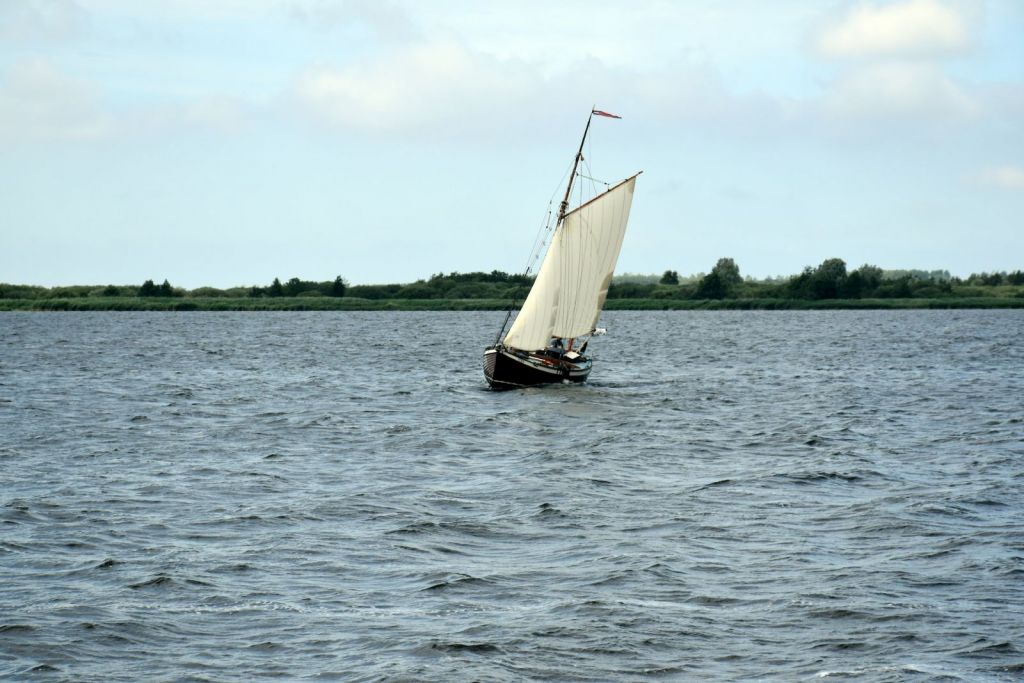
On this page:
The best solo bluewater sailboats, what makes a good solo bluewater sailboat, cost considerations when choosing a sailboat, maintaining your bluewater sailboat.
| Initial Purchase Price | Maintenance and Repairs | Marina Fees and Insurance | Upgrades and Equipment | |
|---|---|---|---|---|
| $30,000 to $60,000 | $5,000 to $10,000 per year | $5,000 per year | $5,000 to $15,000 | |
| $30,000 to $80,000 | $5,000 to $10,000 per year | $5,000 per year | $5,000 to $20,000 | |
| $200,000 to $400,000 | $10,000 to $20,000 per year | $10,000 per year | $20,000 to $50,000 | |
| $100,000 to $200,000 | $10,000 to $20,000 per year | $10,000 per year | $20,000 to $40,000 | |
| $100,000 to $200,000 | $10,000 to $20,000 per year | $10,000 per year | $20,000 to $40,000 | |
| $100,000 to $250,000 | $10,000 to $20,000 per year | $10,000 per year | $20,000 to $50,000 | |
| $500,000 to $1,000,000 | $20,000 to $50,000 per year | $20,000 per year | $50,000 to $100,000 |
Contessa 32 is a classic, compact, and seaworthy sailboat
Contessa 32's sturdy construction and excellent sailing performance have earned it a legendary reputation among sailors. With a well-designed interior layout, it has space for living aboard during your solo adventures. The Contessa 32 is a classic bluewater sailboat designed by David Sadler in the 1970s. It is known for its excellent balance, seaworthiness, and speed. It has a full keel, moderate displacement, and a classic design that has stood the test of time.
Westsail 32 is known for its rugged construction
The Westsail 32 gained fame as an affordable, rugged, and capable long-distance cruiser. Its full keel and sturdy hull ensure a comfortable ride in rough seas. The practical, function-driven interior makes it easy for solo sailors to maintain and navigate the vessel while providing essential amenities for an extended voyage.
Westsail 32 is another classic bluewater sailboat that was designed by William Crealock in the 1970s. It is known for its rugged construction, spacious interior, and excellent performance in heavy weather. The Westsail 32 has a full keel, heavy displacement, and a classic double-ender design.
Hallberg-Rassy 42F is known for its top-notch craftsmanship
The Hallberg-Rassy 42F is another superb choice for single-handed bluewater sailing. This Swedish-built yacht is well-renowned for its top-notch craftsmanship, stability, and comfort. It offers a spacious, well-lit interior, ensuring you'll enjoy your time below deck while cruising the open seas.
Hallberg-Rassy 42F is a modern bluewater sailboat designed by German Frers in the 1990s. It is known for its luxurious interior, excellent performance, and high-quality construction. The Hallberg-Rassy 42F has a fin keel, a spade rudder, and a modern design that combines comfort and performance.
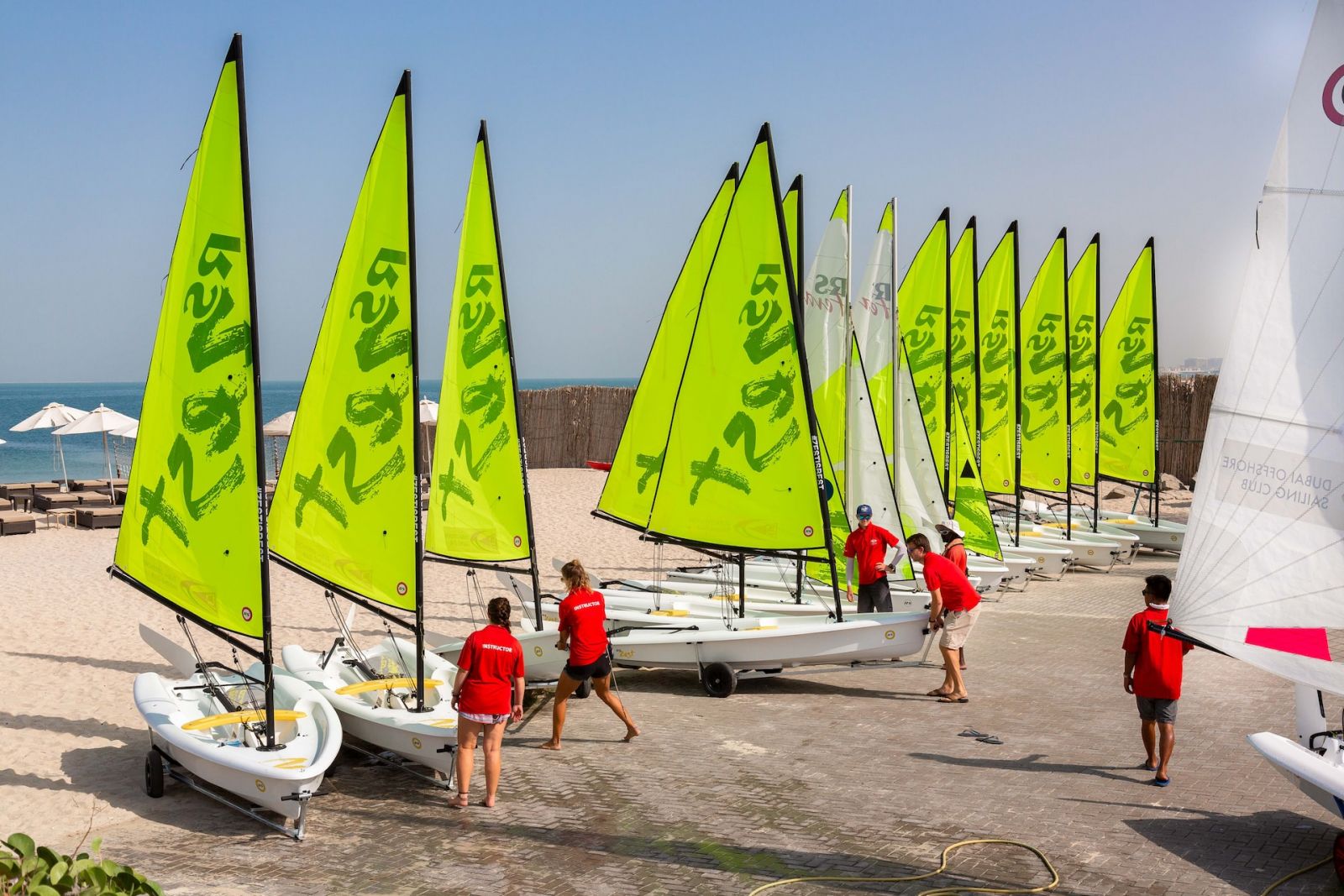
Pacific Seacraft 37 is designed for serious cruising
Pacific Seacraft 37 is a sturdy and reliable boat for solo sailors. Its moderate displacement and full keel provide excellent stability, while the well-thought-out interior layout includes abundant storage and comfortable living quarters. Its reputation as a proven bluewater cruiser makes it a top choice for solo sailors. The Pacific Seacraft 37 is another classic bluewater sailboat designed by Bill Crealock in the 1970s. It is known for its excellent balance, seaworthiness, and comfort.
Island Packet 38 is known for its spacious interior
Island Packet 38 is a popular choice among solo cruisers, thanks to its stable full keel design and living space. Its build quality, comfort, and performance make it well-suited for long-distance sailing. The spacious interior and practical layout ensure you have everything needed for a successful solo journey. Island Packet 38 is a modern bluewater sailboat designed by Bob Johnson in the 1990s. It 38 has a full keel, moderate displacement, and a modern design that combines comfort and performance.
Aside from bluewater sailing , there are other types of sailing discussed in this article.
Tayana 42 is known for its excellent balance, seaworthiness, and comfort
Tayana 42 is a comfortable, sea-kindly sailboat, ideal for single-handed offshore cruising. Its balanced performance, easy handling, and well-equipped interior ensure a safe and comfortable journey. It is well-regarded among sailors for its proven bluewater capabilities and timeless styling. The Tayana 42 is another classic bluewater sailboat designed by Bob Perry in the 1970s. It has a full keel, heavy displacement, and a classic design that has stood the test of time.
The Amel 54 is known for its luxury and exceptional build quality
This French-built vessel offers a spacious and comfortable interior with top-of-the-line amenities, making it an excellent option for solo sailors seeking a bluewater cruiser to explore the world in style and comfort. Its easy-to-handle design with advanced sailing systems allows you to sail solo with confidence and ease. The system includes electric winches, furling sails, and a self-tacking jib, which make it easy to handle the boat in all conditions.
To learn more about bluewater sailing , here's our comprehensive article on it.
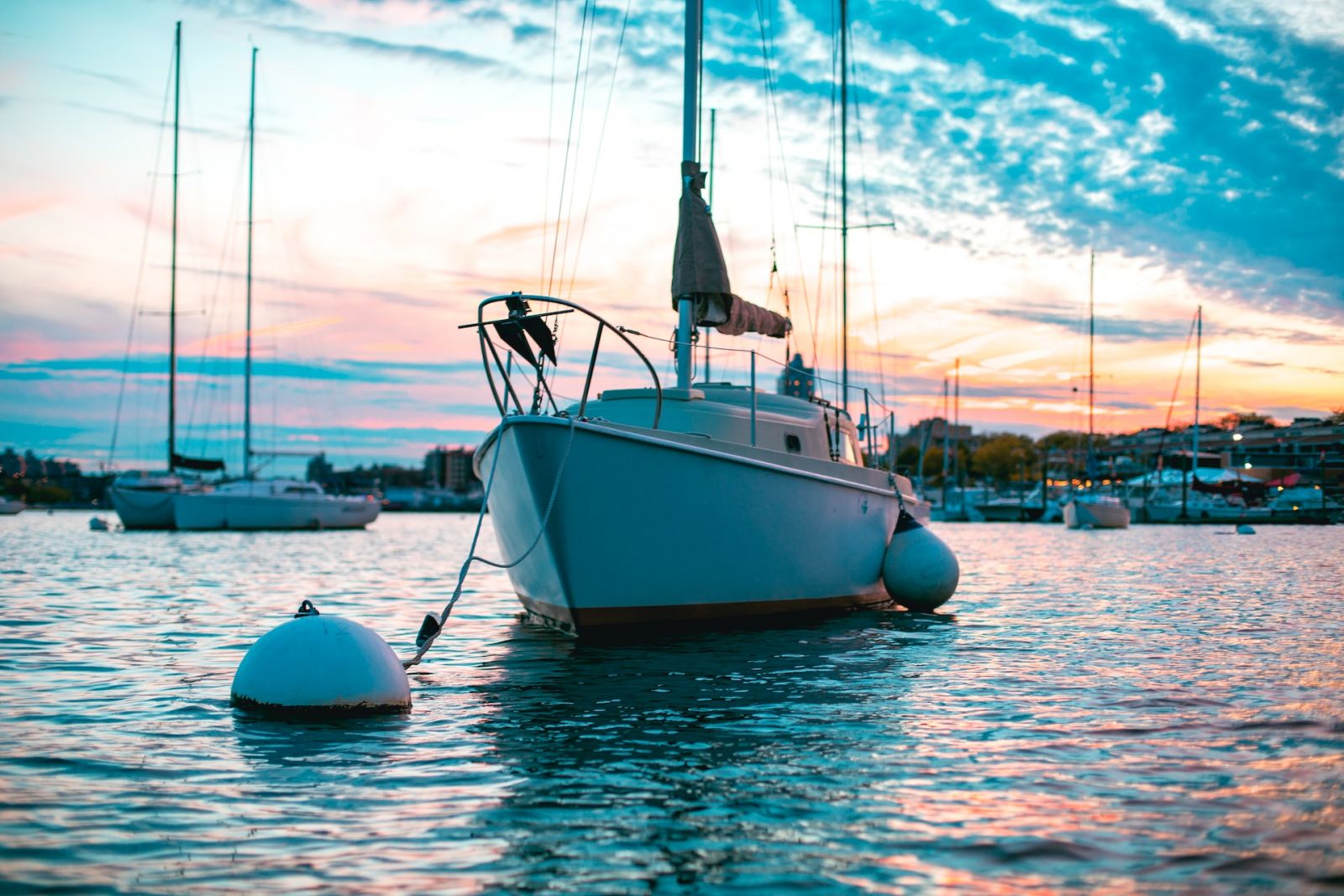
These factors will ensure not only your safety but also your comfort and ease during your sailing adventure.
Size and stability of a solo sailboat
A boat with a wide beam and short waterline provides more stability, making it easier for you to handle the vessel on your own. Some popular sailboat models known for their size and stability include the Westsail 32 and the Hunter Channel 31.
A good solo bluewater sailboat should be large enough to provide adequate storage space for supplies and equipment, while also being stable enough to handle rough seas and high winds. It should also have a well-designed hull shape that provides good stability and balance, and a keel that provides good tracking and prevents the boat from capsizing.
Ease of use and maneuverability of any solo sailboat
Features like roller furling and an electric windlass can make handling the sails and anchor much more straightforward. Also, hydraulic bow/stern thrusters with remotes can help you maneuver your boat easily and safely. Make sure to look for these features when choosing your bluewater sailboat.
A good solo bluewater sailboat should be easy to handle and operate by a single person. It should have a sail plan that is easy to adjust and control, and a steering system that is responsive and easy to use. It should also have a well-designed cockpit that provides good visibility and protection from the elements.
Durability and seaworthiness for long-term safety
A well-built sailboat with a history of proven offshore performance should be at the top of your list. Some of the best and most famous bluewater sailboats include the Alberg 30 and Hanse 371.
A good solo bluewater sailboat should be built to withstand the rigors of extended ocean voyages. It should have a strong, well-built hull that is capable of withstanding heavy seas and high winds. It should also have a well-designed rigging system that is strong and durable, and a keel that is designed to provide good stability and balance.
To learn more about the best keel design for bluewater sailing , here's our article on it.
Comfort and livability of a solo sailboat
Consider the layout and features of the boat, ensuring that it has a comfortable sleeping area, a well-equipped galley, and ample storage space. A good example is the Valiant 40, known for its excellent layout and seaworthiness.
A good solo bluewater sailboat should be comfortable and livable for extended periods of time. It should have a well-designed interior that provides adequate storage space, comfortable sleeping quarters, and a functional galley and head. It should also have good ventilation and lighting, and be well-insulated to provide protection from the elements.
Affordability and availability determine the sailboat's practicality
Set a budget and research suitable sailboats within that price range. Some budget-friendly options include the J/109 and Westsail 32. A good solo bluewater sailboat should be reasonably priced and readily available. It should be affordable for most sailors who are interested in long-distance cruising, and should be available for purchase or charter in most parts of the world.
If you're looking for bluewater sailboats under 40 feet , here's our article where we picked the top 13 most famous ones.
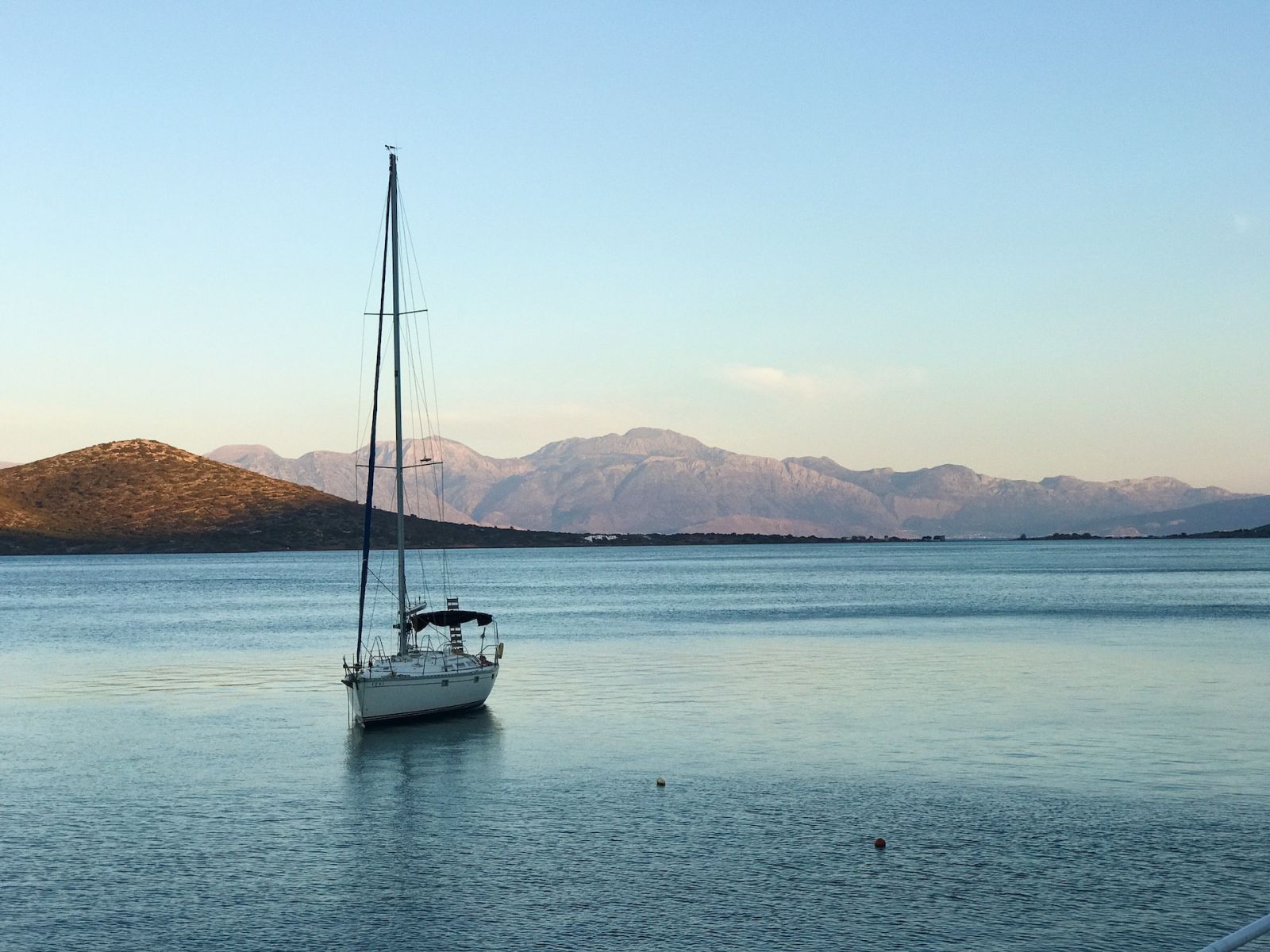
You'll be faced with a range of solo bluewater sailboat options, from budget-friendly to luxury models. Let's explore some factors you should keep in mind to make the best decision for your needs and budget.
Initial purchase price : This is often the first thing people think of when it comes to the cost of a sailboat. There's a wide range in prices, depending on factors like age, size, and brand. For example, a used Alberg 30 might cost between $10,000 and $15,000, while a new Amel 54 could be in the range of hundreds of thousands of dollars. It's important to find a balance between quality and affordability that suits your needs and financial capabilities.
Maintenance and repairs : Owning a sailboat comes with ongoing expenses to keep it in good sailing condition. Regular maintenance tasks like painting, replacing worn rigging, and inspecting safety equipment can add up over time. Be prepared to allocate a portion of your budget for these essential tasks, as neglecting them could lead to more expensive repairs down the line.
Marina fees and insurance : Depending on where you plan to keep your boat, you may incur costs for marina or dockage fees. Additionally, securing insurance coverage for your sailboat is a must to protect your investment. Both of these costs can vary widely, so make sure you factor them into your overall budget.
Upgrades and equipment : To ensure your sailboat is well-suited for solo bluewater sailing, you might need to invest in upgrades to improve its safety and performance. For instance, you may want to add a roller furling system, wind vane, or more advanced navigation equipment. These enhancements can amount to a significant investment, so it's wise to plan financially for any desired upgrades.
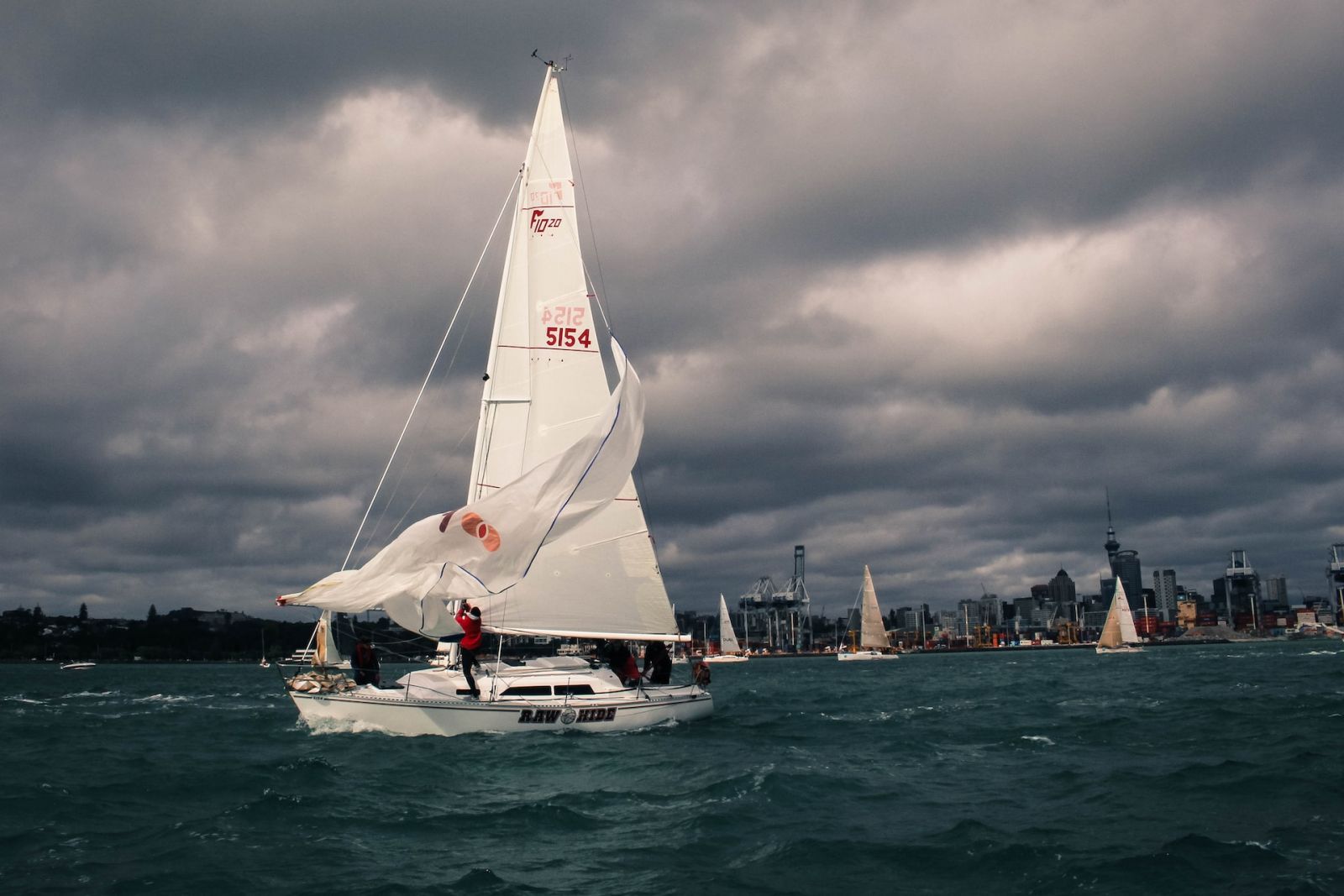
Here are some essential tips to keep your boat in top shape, and ensure its long life and performance during solo journeys:
Regular inspections : Make it a habit to perform a thorough inspection of your sailboat periodically. Examine the rigging, sails, hull, and all mechanical components. Routine inspections allow you to detect any signs of wear, damage or potential problems before they escalate.
Cleaning : Keep your sailboat clean by washing it regularly with freshwater and appropriate cleaning solutions. This simple practice prevents the buildup of dirt, salt, and other debris, which can cause corrosion and damage to your vessel over time.
Checking the bilge : Ensure that your bilge pump is working efficiently and that there's no water accumulating in the bilge area. If there are any signs of water accumulation, investigate the source and address any leaks or issues promptly.
Servicing the winches : Winches play a crucial role in your sailboat’s performance, so it’s essential to inspect, clean, and grease them regularly. This practice will guarantee their smooth operation and prolong their lifespan.
Sail care : Inspect your sails frequently for any tears, wear, or damage. Repair or replace them as necessary. To protect your sails from the sun’s harmful UV rays, always use a sail cover when not in use.
Keeping records : Maintain a logbook to document all maintenance tasks, inspections, and repairs. Not only will this help you keep track of what has been done, but it will also provide valuable information if you decide to sell your sailboat in the future.
Leave a comment
You may also like, what is bluewater sailing.
It's easy to confuse offshore sailing with bluewater sailing - and it's no wonder. Many people do, including myself. So I've decided to list the difference once and …
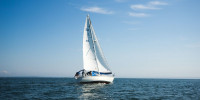
13 World-Famous Bluewater Sailboats Under 40 Feet

What's the Best Keel Design for Bluewater Sailing?

Different Types of Sailing and Racing Explained

41 Sailboat Cruising Essentials for Long Trips

What Is The Best Boat for Rough Water (According to Experts)
If you’re interested in boating, there are several different types of boats out there. If you love boating, you’re probably interested in knowing which boat works best for rough water.
Do you want to enjoy boating, but you’re not sure which type of boat is best for rough water? Do you want to learn more about boats? In this post, we’ll take a look at the different types of boats, as well as the different types of boats that are best for rough water.
In this article, we’ll help you decide which type of boat is best for rough water.
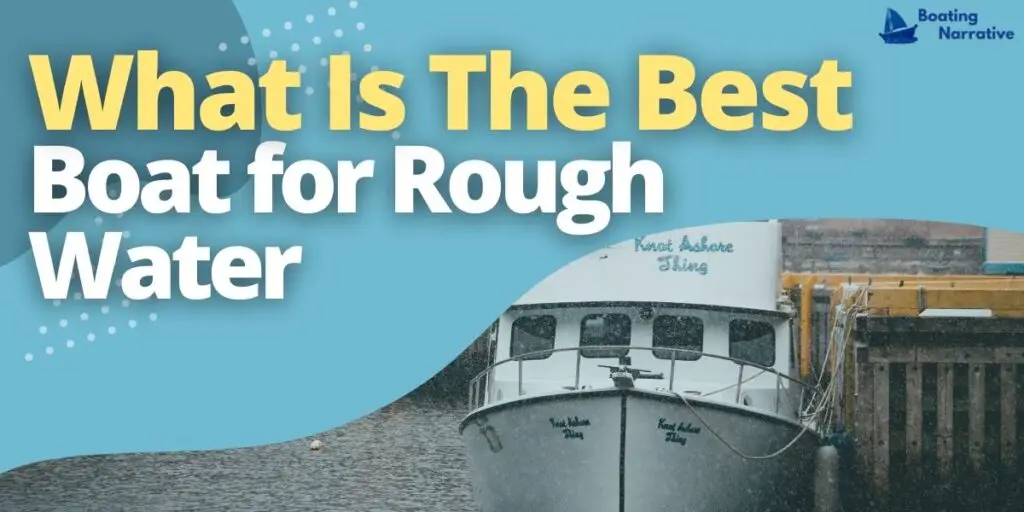
Here’s The Answer To What Is The Best Boat For Rough Water:
Aluminum-construction hulls are best for rough water, as are boats with semi-displacement hulls. Proper weight distribution also helps.
Sailing boats are a great choice for rough water. They are built to be in the water, whether that’s sailing through rough seas or crossing a river.
What Do You Need to Look For in a Boat for Rough Water?
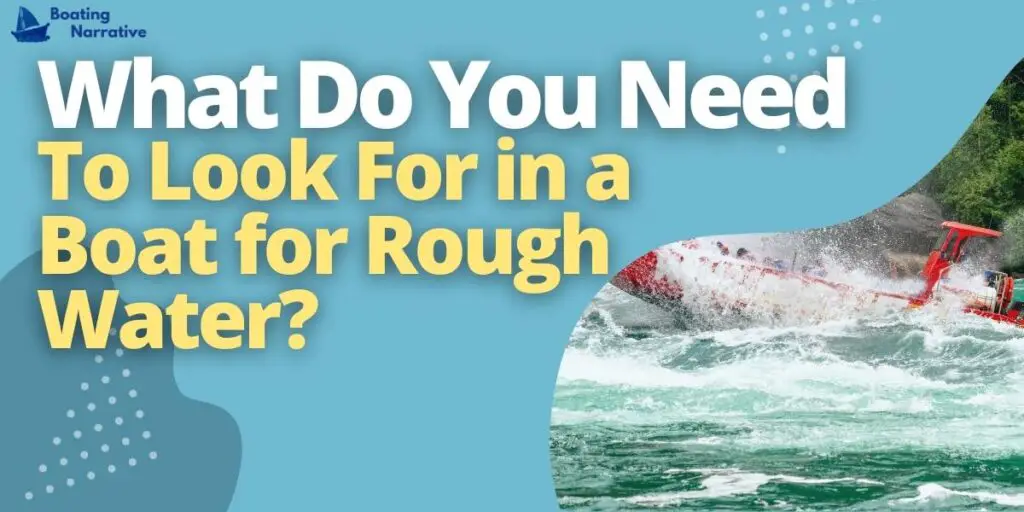
When you’re looking for a boat that can handle rough water, there are a few things you need to keep in mind. You need to design the hull in a way that is appropriate for the conditions.
A center console is a good choice for rough water because it is easy to handle and stable. The size of the boat also needs to be right for the weather. A smaller boat will be more maneuverable in rough water, while a larger boat will be more stable.
You also need to think about how the boat’s hull looks. A boat with a good hull design will be able to handle rough conditions better than one with a poor hull design. The hull should be designed to provide good buoyancy and stability in rough water.
Finally, you need to make sure that you’re in the right place when you’re boating in rough water. The wrong boat can be as dangerous as the wrong place. Make sure you know the conditions and choose a safe place to boat.
People can use many different types of boats in rough water, but not all of them are created equal. Some boat types are better suited to choppy conditions than others. Here are a few things to consider when choosing the best boat type for rough water:
- Monohull vs. Catamaran vs. Trimaran
- Deep-V Hull
- Center Console Boat
Almost all boats have monohulls, and they are typically a good choice for rough water. Catamarans and trimarans are both stable platforms, but they can be more difficult to maneuver in rough conditions.
The beam ratio is the width of the boat divided by the length. A boat with a higher beam ratio will be more stable in choppy conditions.
The cockpit is the area where the captain and crew sit. In rough water, it is important to have a cockpit that is enclosed and has good visibility.
Deep-v hulls are designed to cut through waves and provide a smooth ride. They are a good choice for rough water, but they can be difficult to maneuver in tight spaces.
In a boat, the bow is the front. In rough water, it is important to have a bow that is designed to cut through waves.
Because rough water can make it hard to find a good boat, you need to think about how big the hull is. A small boat with the right hull design can face the waves just as well as a bigger boat.
However, the size range of rough water boats can vary significantly, so it’s important to find the right size for your needs. There are two main types of rough water boats: small boats and big boats.
Small boats are typically between 10 and 20 feet long. They’re easy to maneuver and can be a good fit for those who want a smaller vessel. Big boats, on the other hand, are usually over 20 feet long.
They have more space and can accommodate more people, but they can be harder to handle in rough waters. When choosing the right size boat for rough waters, it’s important to consider your needs and the size of the waves you’ll be facing.
If you’re not sure what size boat is right for you, a hybrid option may be a good choice. Rough water boats come in a variety of sizes, so there’s sure to be a good fit for everyone.
Boat Designing Features

There are a few factors to look at when you choose the best boat for rough water. The first is the hull design. A flat bottom or shallower draft is a good idea for rough water. Intrepid boats are popular for their hull shape.
The wedge design is a good idea for rough water because it helps the boat face the waves.
The second thing to consider is the trim tabs. Trim tabs help the boat ride higher in the water and make it easier to maneuver.
The third thing to consider is the hull shape. The face of a wave is very important in rough water. A hull that is V-shaped is a good idea because it will cut through the waves.
Boat Material
Fiberglass is the most popular material for rough water boats because it is strong and durable. It is also a dry ride material, meaning it will not get wet in the ocean waters.
Aluminum is another popular choice for rough water boats because it is lightweight and has a good dry ride. Carbon fiber is also a good choice for rough water boats because it is strong and lightweight.
Wood is not a popular choice for rough water boats because it is not as strong as fiberglass or aluminum. However, some people believe that wood boats have a better dry ride than fiberglass or aluminum boats.
There is no right or wrong answer when it comes to choosing the best boat build material for rough water. It depends on the boater’s preferences and what they are looking for in a boat.
Factors Impacting Boat Performance In Rough Water
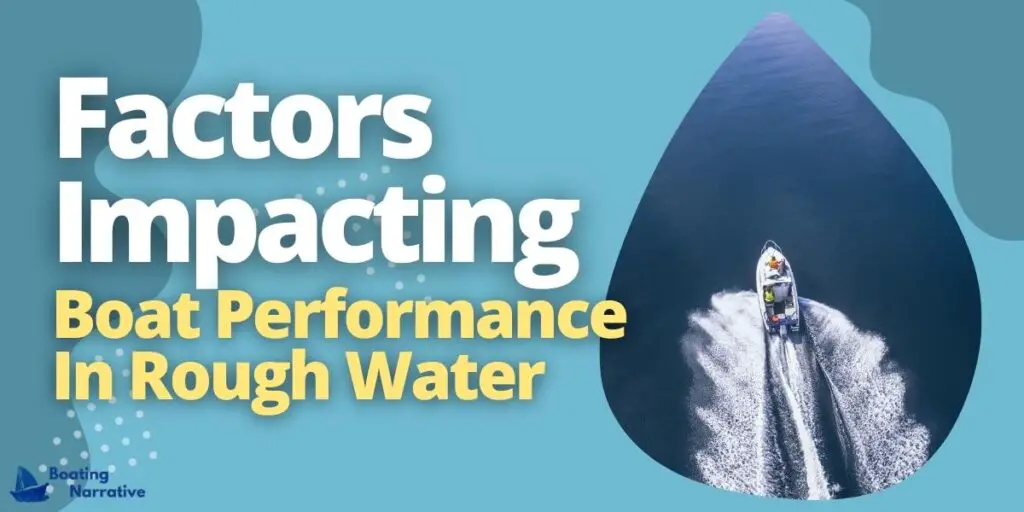
A boat’s performance in choppy water is influenced by a variety of factors. Some of these include the size and weight of the boat, the type of hull, and the power of the engine.
Bigger, heavier boats tend to do better in rough water than smaller, lighter ones. This is because they have more mass and are less likely to be tossed around by waves. They also tend to have deeper hulls, which helps them stay stable in choppy waters.
The type of hull also makes a difference. Boats with deep-V hulls tend to do better in rough water than those with shallow hulls. This is because the deep-V hulls provide more stability and can handle more waves without capsizing.
Finally, the power of the engine is a factor. Boats with more powerful engines can typically handle rougher water than those with weaker engines. This is because they have more power to push through waves and keep the boat moving forward.
Boat Engine’s Power to Handle Rough Water
A boat’s engine needs to be powerful enough to handle rough water. This means that the engine must be able to generate enough power to move the boat through the water, even when the water is choppy, or there is a strong wind.
- The amount of power that a boat’s engine needs to be able to generate depends on the size and weight of the boat.
- In comparison to a huge boat, a tiny boat may get by with a less powerful motor.
- The type of boat also makes a difference. A speedboat, for example, needs a more powerful engine than a fishing boat.
Best Type of Boat for Choppy Water
There is no definitive answer to this question as it depends on a number of factors, including the type of water you’ll be boating in, the size and weight of your boat, and your personal preferences. We may, however, categorize it into a few broad groups.
If you’re looking for a boat that can handle rough, choppy waters, you’ll want something with a deep V-hull. This hull design cuts through waves rather than riding over them, making for a smoother, more stable ride.
Boats with a shallower hull can be just as stable in calm waters, but they tend to be less comfortable and more susceptible to waves in rougher conditions.
Another factor to consider is the size and weight of your boat. Heavier boats are often more stable in choppy waters, but they can be more difficult to maneuver. Lighter boats, on the other hand, are easier to handle but may not be as stable.
In the end, you must decide what trade-offs you are willing to make.
How Does a Sailboat Handle Choppy Water?

Sailboats are designed to handle choppy water. The hull of a sailboat is shaped to cut through the waves, and the keel helps to keep the boat stable. Sailboats also have a centerboard or daggerboard, which can be lowered into the water to help with stability.
How Do You Run a Boat in Rough Water?
Running a boat in rough water takes skill, knowledge, and practice. While it is possible to run a boat in rough water without incident, it is always best to be prepared. Here are some tips for running a boat in rough water:
- Know your boat: Before heading out in rough water, take some time to familiarize yourself with your boat. Know its capabilities and limitations. When running in rough water, this will assist you in making smarter decisions.
- Check the weather: Before heading out, always check the forecast. If the forecast calls for rough weather, it is best to stay at the dock.
- Use caution: When running in rough water, always use caution. This means paying attention to the waves and the wind and making sure that everyone on board is wearing a life jacket.
- Be prepared: In the event that you do end up in rough water, it is important to be prepared. If you need to abandon the ship, have a strategy in place. Make sure everyone on board knows the plan and where the life jackets are.
What Size Waves Can a Boat Handle?
A boat’s hull is designed to displace a certain amount of water. The deeper the boat sits in the water, the greater the amount of water it displaces and the more stable it is.
A boat’s weight also affects its stability. Heavier boats are more difficult to tip over than lighter boats.
The size of waves a boat can handle depends on the design of the hull, the weight of the boat, and the conditions of the water. In general, deeper hulls are more stable and can handle larger waves. Heavier boats are also more stable and can handle larger waves.
Most boaters have a pretty good idea of how big a wave their boat can handle. But, there are some things to consider when making that decision. The first is the size of the boat. A boat that is too small will be easily swamped by a big wave.
The second is the type of boat. A boat that is not designed for big water will be more likely to capsize in the following sea. The third is the experience of the boater.
A boater who is not experienced in handling a boat in big water is more likely to make a mistake that could result in a capsized boat.
How Do You Take Big Waves in A Small Boat?
In order to take big waves in a small boat, you need to have a few things. First, you need to have a boat that is seaworthy and able to handle big waves.
Second, you need to have the right equipment on board the boat, including the proper safety gear. Finally, you must be able to control the boat in large waves.
Be sure to practice handling the boat in big waves so that you are prepared for when you encounter them.
Avoid Boat Accidents and Damage in Rough Waters
Boat accidents happen every day, and many of them could have been avoided with proper precautions. In rough waters, it is especially important to be aware of your surroundings and take care not to damage your boat.
There are a few things you can do to avoid boat accidents and damage in rough waters.
- Be aware of your surroundings and pay attention to the weather conditions. If you see a storm coming, it is best to head to shore and wait it out.
- Make sure you have the proper safety gear on board, including life jackets and flares.
- Avoid drinking alcohol while boating. Alcohol impairs your judgment and can make it more difficult to operate your boat safely.
By following these simple tips, you can help to avoid boat accidents and damage in rough waters. Remember to always be aware of your surroundings and take precautions to keep yourself and your boat safe.
Is a Heavier Boat Better in Rough Water?
A heavier boat is not necessarily better in rough water. The weight of the boat can affect its performance in different ways. Heavier boats tend to be more stable in the water and are less likely to capsize.
They also tend to ride higher in the water, which can be an advantage in rough conditions. However, heavier boats are also more difficult to maneuver and can be slower to respond to changes in the water.
The best boat for rough water conditions depends on a number of factors, including the size and weight of the boat, the type of hull, and the experience of the boat operator.
In general, smaller and lighter boats are more maneuverable and responsive and can handle rough conditions better than larger and heavier boats.
Most Seaworthy Boat Design
There is no one design that is best suited for all water conditions and rough waters. Boat design refers to the way the boat is built, including its hull, deck, and sails.
Many boat designs are seaworthy in rough water. These include centerboard boats, bow-rider boats, catamaran-style boats with sailing rigs, and monohulls with deep keels.
The best boat for rough water is the largest one that can be safely operated. Larger boats are more stable and can handle rougher seas better than smaller boats. They also provide more space to ride out a storm, if necessary.
When it comes to choosing the best boat for rough water conditions, there is no one-size-fits-all answer. The best boat for you will depend on your specific needs and preferences.
It is important to do your research and choose the boat that is best suited for your specific needs.
- Rough water can be defined as water with waves that are higher than two feet.
- It is important to have a boat that can handle rough water conditions safely and efficiently.
- There are a variety of boats that are designed specifically for rough water conditions.
- Some of the most popular types of boats for rough water include catamarans, monohulls, and inflatables.
- Each type of boat has its own unique set of advantages and disadvantages.
- It is important to do your research and choose the boat that is best suited for your specific needs and preferences.
You’ll Want To Save Every Penny To Buy One Of These Extraordinary Boats
Say it with us: “I’m on a boat!”
Of course, depending on where you live and what layer of the economic strata you land in, you’ll probably be picturing something different than the person next to you . Some of us think of the humble fisherman bracing against a storm at sea. Others might be taken back to memories of their parents ditching the 9-to-5 and sailing them around the world . Others still may be thinking about the studio yacht party at last year’s Cannes.
Whatever thought or memory is conjured for you, one constant remains — those boats had to be built well, so as not to end up at the bottom of the drink. Last month, Van Dam Custom Boats showed us the mastery that goes into their stunning crafts. Here, take a peek:
In honor of that mastery, we’ve compiled a list of some of our other favorite boats we’d love to spend a day or 70 out on the water with. Some are humble, some are bombastic, some are faraway dreams. All of them are superb.
BOSTON WHALER – FISHING BOAT
View this post on Instagram A post shared by Boston Whaler (@boston_whaler)
Perhaps it’s best to start out with a little sport and utility before we get into the big hauls. A solid, well-equipped fishing boat is the first step in anyone’s sea-adventuring life. You go out, find some fish, fish those fish, and bring home dinner — all with the added benefit of knowing exactly what that dinner is . It can be a solo journey or a family affair. Either way a fishing boat is where most of us will start our water journeys.
There are so many fishing boat companies to chose from out there. Boston Whalers are always sturdy and reliable. They come completely customizable and tend to last in rough seas or calm.
VAN DAM CLASSIC RUNABOUT
View this post on Instagram A post shared by Van Dam Custom Boats (@vandamcustomboats)
A classic runabout or tender can get you from Point A to Point B in sleek style. Or they can help you get away from the Holy Grail henchmen along the canals of Venice . It’s a throwback to the days when people summered on bays and lakes and needed a water-savvy form of transportation to skim speedily across the water. Although these boats aren’t equipped to land a marlin or pull crab pots, they’re going to get you around while looking fly. And that’s worthwhile.
Van Dam is your best bet of getting behind the wheel of one of these throwback beauties — unless you’re a Kennedy or Bush and summer in New England .
POLYNEISAN VOYAGING CANOE
View this post on Instagram A post shared by Paula Fuga (@pfunklove)
Long before Columbus sailed the ocean blue, Polynesians were bobbing around the Pacific on massive outrigger canoes. These canoes got the Polynesians from deep in the South Pacific all the way to the North American coast with nothing more than a couple hauls, sails, and the starry night to guide them.
Although this may be a more advanced form of sailing (outrigger canoes take some serious skills), it’d still be a blast retracing the steps of ancient Hawaiians or Polynesians across the Pacific or around the world in your very own voyaging canoe. After all, an entire culture of people spent millennia perfecting their boats to do exactly that.
Alternately, you can spend a few years, and less dollars, custom building one yourself — there’s space in your garage, right?
View this post on Instagram A post shared by Bruddah Cliff (@cliff_kapono)
HALLBERG-RASSEY 64
View this post on Instagram A post shared by Hallberg-Rassy (@hallbergrassy)
Full disclosure, I sailed one of these boats across an ocean. So my including it on the list isn’t negating the abundance of other great makes of sailboats on the market. I just like this one. I know it. I sailed her blind in the pitch black nights. I slept, cooked, ate, and bathed with this boat for months. And that’s the rub. You can live in this boat and make the world your oyster (also, you’ll be on the sea, so oysters can be your oyster).
For about the same price as a small house ($250,000), you can call this boat your home. Hallberg -Rassey make seriously well constructed and spacious sailing vessels that can handle any of the seven seas. A family of four to six can easily live in the 64-foot sloop. Maybe you’re making the wrong mortgage payment and it’s time to live life at sea? Well, then this is a solid investment in your future and well-being. Adventure literally awaits.
DRAGONFLY TRIMARAN
View this post on Instagram A post shared by Dragonfly UK (@dragonflytrimarans.uk)
Now we’re getting into speed, class, and design brilliance. A streamlined main hull has two outer floats attached to bring the speed. Overall, this class of sailboat is for someone seeking a side of adventure with their main course of easy cruising.
Dragonfly’s Trimarans are consistently considered some of the best boats in their class for sailing competitively or leisurely . Their compact and sleek design is award-winning . If you’re thinking of getting into racing, this may be your gateway boat.
ITALIA YACHTS
View this post on Instagram A post shared by Italia Yachts (@italiayachts)
So you’ve decided to become a sailboat racer… You’ll need a boat that is hydrodynamical, built by masters who take the time to design a cruiser that can cut through the water at competitive speeds.
Italia Yachts combine the same devotion to hydrodynamics as they do to classic Italian style. Their boats are sleek. Their decks are clean and designed photo ready. The boats are big enough — and well laid out enough — for your racing team to live comfortably while you cross the sea. And they are fast .
SANLORENZO LUXURY YACHT
View this post on Instagram A post shared by Julia Skop (@julia_smartyachts)
There’s another class of sailing boat that tops all of these. They’re the luxury yachts. And when you win the lottery or invent whatever it is that replaces Facebook this will be your boat. These are for the dreamers whose dreams come true. Lucky bastards.
Sanlorenzo’s yachts are nicer than most 5-star hotels, and they cost about as much as a castle . But you can probably afford that with your lottery winnings too. These boats are for the 1 percent of the 1 percent, and their luxury knows no bounds. Now, where’d I put that lottery ticket…?
View this post on Instagram A post shared by MRSUPERYACHTS (@mrsuperyachts)
A FREAKING PIRATE SHIP
View this post on Instagram A post shared by Ania (@annowaa)
Childhood fantasies of buried treasure and adventure on the high seas are always fun to live out. So, why not buy a dang pirate ship? Yes, you can buy a pirate ship (or build one if that’s your thing). Whether or not you’ll find treasure or plunder other ships, well, that’s up to you.
You’ll be hard-pressed to find a pirate ship on the market, but they are out there . Otherwise, you’re going to have to build one yourself. Either way, it’s the most kickass way to sail the world’s seven seas. Let’s face it, who doesn’t want to roll into a new country in a foreboding, badass pirate ship with black sails and a Jolly Rodger flying from the mizzen mast?
View this post on Instagram A post shared by 🌙☀️🌲🍂🌸 (@curiousadventurez)


Download Brochure
Modern classic.
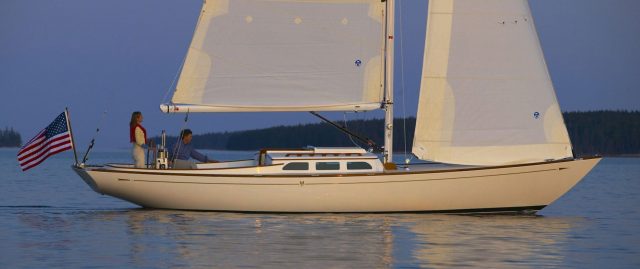
Sailing Simplicity at its Finest
Long time single handed sailors love the M36 because within 5 minutes they can be off the dock and sailing. Beginners are equally as enthralled because the M36 is simple to sail, simple to learn on and immediately rewarding with her straightforward sail handling and control lines that are lead under deck to electric winches at the helmsman’s fingertips. In addition, all instruments are intelligently arrayed to quickly provide all the information you need.
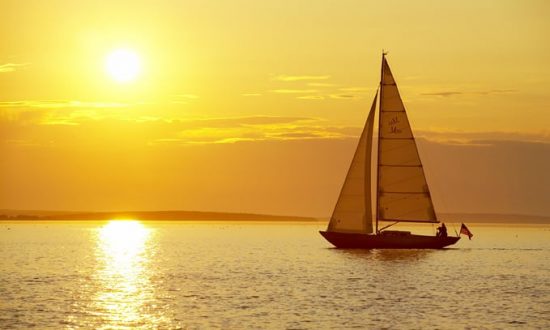
More Than a Daysailer
Take her overnight! The elegantly appointed optional V-berth, standard fridge and enclosed head make her far more versatile than a mere daysailer. The M36 also has a deep, safe and comfortable cockpit which accommodates six adults allowing you to safely entertain your guests.
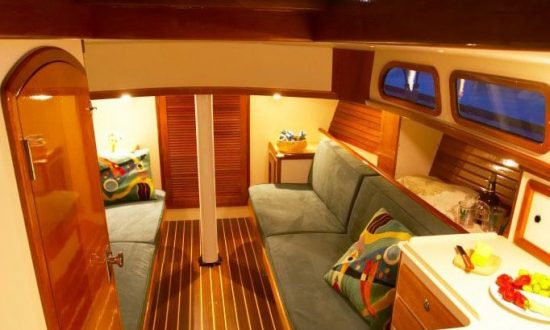
Beautifully Appointed Interior
No detail inside her cabin is overlooked. Large safety glass windows and a huge foredeck hatch flood the interior with natural light. The Herreshoff style interior is finished elegantly with white bulkheads, solid cherry trim and marvelously varnished hull sheathing. Twin port and starboard settees are ergonomically designed for comfortable lounging (or sleeping), and well placed reading lights invite you to enjoy the morning paper or catch up on some afternoon reading. Generous storage can be found in the forepeak. An alternative layout converts the forepeak space into a beautiful and functional V-Berth for overnight stays.
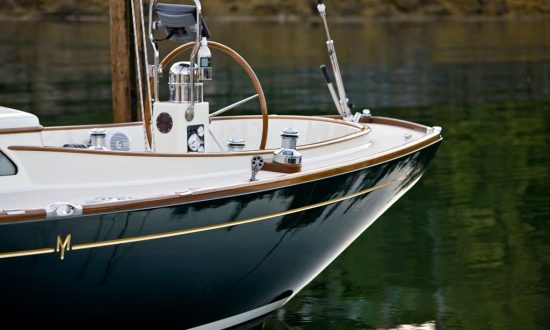
Remarkably Simple to Dock
The M36 does exactly what you tell her to do. She backs straight (no prop walk), turns on a dime and docks like a pro. In short, she maneuvers under power as responsively as she does under sail making her a pleasure to both sail and to bring back to port. Even the fenders are just a ‘clip’ away; pad eyes and stainless steel rub rails are placed on deck for ‘clip-on’ polar-fleece-covered fenders. What could be easier!
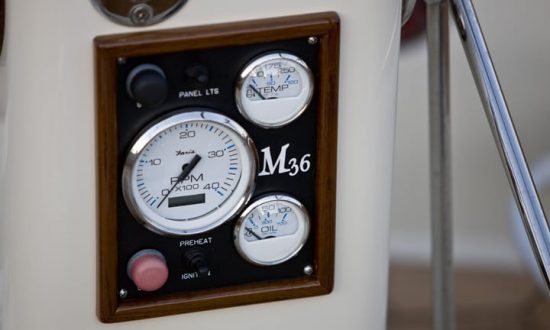
Perfectly Engineered
At Morris Yachts we’re not just boat builders; we’re sailors and boat owners too. Perhaps this is the reason the M36 is so intuitively designed with the owner in mind. Often overlooked by other builders, access to the engine, through-hulls and electrical systems is superb.
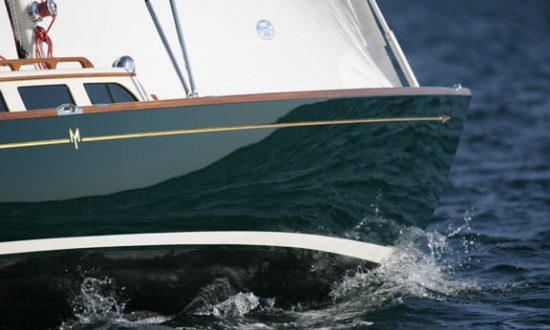
As with all sailing boats built by Morris Yachts, the M36 offers peace of mind. You are onboard one of the most seaworthy boats in the world. Setting the industry standard, Morris Yachts’ level of engineering, fit and finish sets the benchmark by which other builders measure themselves. Morris craftsmen and engineers demand only the finest equipment and use the most modern techniques and technology during the boat building process, proving that the beauty of a Morris is not only skin deep but integrated throughout all facets of the vessel.
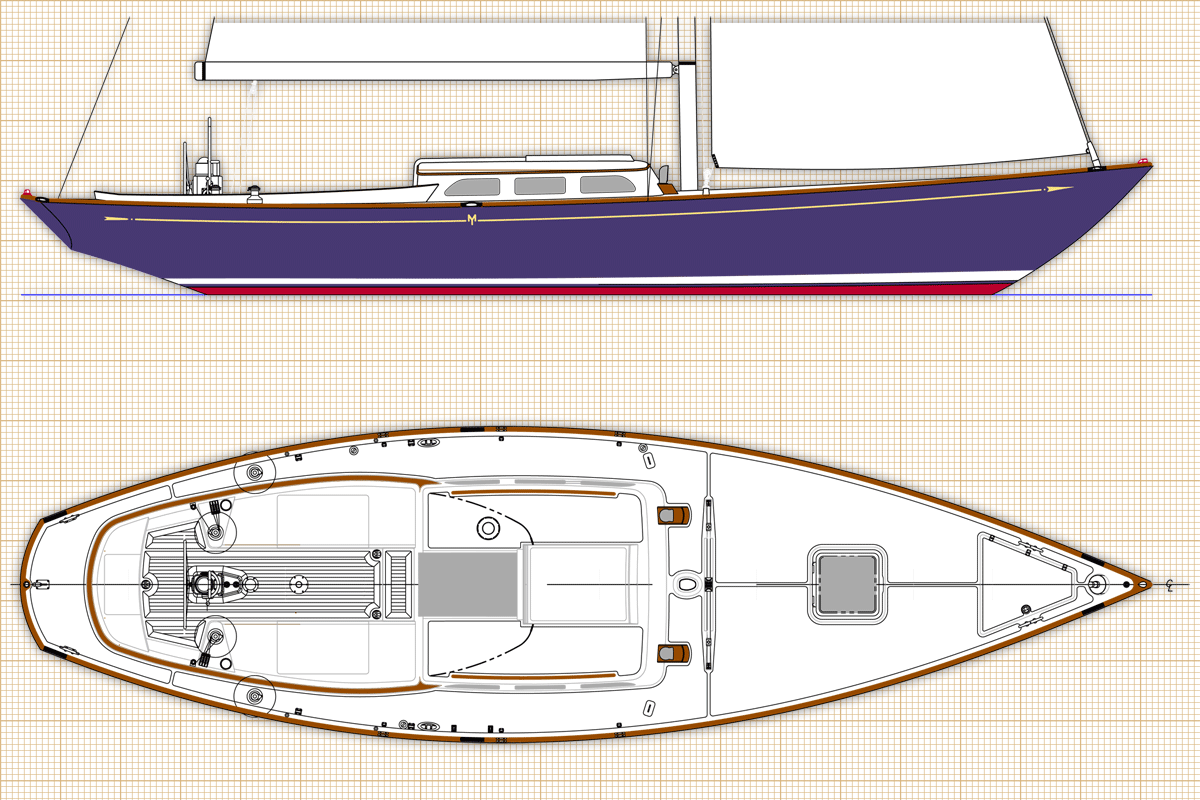
| LOA | 36' 1" |
| LWL | 25' 0" |
| BEAM | 10' 1" |
| DRAFT | 5' 3" |
| DISPLACEMENT | 8900 lbs. |
| FUEL CAPACITY | 20 U.S. gallons |
| ENGINE | Yanmar 3YM20C x SD Saildrive unit, 3-cylinder, direct-injected, fresh water-cooled marine diesel engine, maximum 21 hp @ 3600 RPM. |
| CONSTRUCTION | Carbon-Epoxy & Kevlar™ |
Images and media on this page may represent optional equipment or previous specifications. Specifications and equipment are subject to change.
- First Name *
- Last Name *
- Boating Location: Where do you do most of your boating? *
- Boating Country * Afghanistan Albania Algeria American Samoa Andorra Angola Anguilla Antarctica Antigua and Barbuda Argentina Armenia Aruba Australia Austria Azerbaijan Bahamas Bahrain Bangladesh Barbados Belarus Belgium Belize Benin Bermuda Bhutan Bolivia Bonaire, Sint Eustatius and Saba Bosnia and Herzegovina Botswana Bouvet Island Brazil British Indian Ocean Territory Brunei Darussalam Bulgaria Burkina Faso Burundi Cabo Verde Cambodia Cameroon Canada Cayman Islands Central African Republic Chad Chile China Christmas Island Cocos Islands Colombia Comoros Congo Congo, Democratic Republic of the Cook Islands Costa Rica Croatia Cuba Curaçao Cyprus Czechia Côte d'Ivoire Denmark Djibouti Dominica Dominican Republic Ecuador Egypt El Salvador Equatorial Guinea Eritrea Estonia Eswatini Ethiopia Falkland Islands Faroe Islands Fiji Finland France French Guiana French Polynesia French Southern Territories Gabon Gambia Georgia Germany Ghana Gibraltar Greece Greenland Grenada Guadeloupe Guam Guatemala Guernsey Guinea Guinea-Bissau Guyana Haiti Heard Island and McDonald Islands Holy See Honduras Hong Kong Hungary Iceland India Indonesia Iran Iraq Ireland Isle of Man Israel Italy Jamaica Japan Jersey Jordan Kazakhstan Kenya Kiribati Korea, Democratic People's Republic of Korea, Republic of Kuwait Kyrgyzstan Lao People's Democratic Republic Latvia Lebanon Lesotho Liberia Libya Liechtenstein Lithuania Luxembourg Macao Madagascar Malawi Malaysia Maldives Mali Malta Marshall Islands Martinique Mauritania Mauritius Mayotte Mexico Micronesia Moldova Monaco Mongolia Montenegro Montserrat Morocco Mozambique Myanmar Namibia Nauru Nepal Netherlands New Caledonia New Zealand Nicaragua Niger Nigeria Niue Norfolk Island North Macedonia Northern Mariana Islands Norway Oman Pakistan Palau Palestine, State of Panama Papua New Guinea Paraguay Peru Philippines Pitcairn Poland Portugal Puerto Rico Qatar Romania Russian Federation Rwanda Réunion Saint Barthélemy Saint Helena, Ascension and Tristan da Cunha Saint Kitts and Nevis Saint Lucia Saint Martin Saint Pierre and Miquelon Saint Vincent and the Grenadines Samoa San Marino Sao Tome and Principe Saudi Arabia Senegal Serbia Seychelles Sierra Leone Singapore Sint Maarten Slovakia Slovenia Solomon Islands Somalia South Africa South Georgia and the South Sandwich Islands South Sudan Spain Sri Lanka Sudan Suriname Svalbard and Jan Mayen Sweden Switzerland Syria Arab Republic Taiwan Tajikistan Tanzania, the United Republic of Thailand Timor-Leste Togo Tokelau Tonga Trinidad and Tobago Tunisia Turkmenistan Turks and Caicos Islands Tuvalu Türkiye US Minor Outlying Islands Uganda Ukraine United Arab Emirates United Kingdom United States Uruguay Uzbekistan Vanuatu Venezuela Viet Nam Virgin Islands, British Virgin Islands, U.S. Wallis and Futuna Western Sahara Yemen Zambia Zimbabwe Åland Islands Country
- Boating State * Choose a State Outside US / Canada Alabama Alaska Alberta Arizona Arkansas California - North California - South Colorado Connecticut Delaware District Of Columbia Florida - East Coast Florida - West Coast Gulf Coast Georgia Hawaii Idaho Illinois Indiana Iowa Kansas Kentucky Louisiana Maine Manitoba Maryland Massachusetts - North of Boston Massachusetts - Boston and South Michigan Minnesota Mississippi Missouri Montana Nebraska Nevada New Brunswick New Hampshire New Jersey - Manasquan and North New Jersey - South of Manasquan New Mexico New York - Great Lakes New York - Coastal North Carolina North Dakota Nova Scotia Ohio Oklahoma Oregon Pennsylvania - East Pennsylvania - West Puerto Rico Rhode Island Saskatchewan South Carolina South Dakota Tennessee Texas Utah Vermont Virgin Islands Virginia Washington West Virginia Wisconsin Wyoming
- Mailing Address *
- Street Address *
- Country * Afghanistan Albania Algeria American Samoa Andorra Angola Antigua and Barbuda Argentina Armenia Australia Austria Azerbaijan Bahamas Bahrain Bangladesh Barbados Belarus Belgium Belize Benin Bermuda Bhutan Bolivia Bosnia and Herzegovina Botswana Brazil Brunei Bulgaria Burkina Faso Burundi Cambodia Cameroon Canada Cape Verde Cayman Islands Central African Republic Chad Chile China Colombia Comoros Congo, Democratic Republic of the Congo, Republic of the Costa Rica Côte d'Ivoire Croatia Cuba Curaçao Cyprus Czech Republic Denmark Djibouti Dominica Dominican Republic East Timor Ecuador Egypt El Salvador Equatorial Guinea Eritrea Estonia Ethiopia Faroe Islands Fiji Finland France French Polynesia Gabon Gambia Georgia Germany Ghana Greece Greenland Grenada Guam Guatemala Guinea Guinea-Bissau Guyana Haiti Honduras Hong Kong Hungary Iceland India Indonesia Iran Iraq Ireland Israel Italy Jamaica Japan Jordan Kazakhstan Kenya Kiribati North Korea South Korea Kosovo Kuwait Kyrgyzstan Laos Latvia Lebanon Lesotho Liberia Libya Liechtenstein Lithuania Luxembourg Macedonia Madagascar Malawi Malaysia Maldives Mali Malta Marshall Islands Mauritania Mauritius Mexico Micronesia Moldova Monaco Mongolia Montenegro Morocco Mozambique Myanmar Namibia Nauru Nepal Netherlands New Zealand Nicaragua Niger Nigeria Northern Mariana Islands Norway Oman Pakistan Palau Palestine, State of Panama Papua New Guinea Paraguay Peru Philippines Poland Portugal Puerto Rico Qatar Romania Russia Rwanda Saint Kitts and Nevis Saint Lucia Saint Vincent and the Grenadines Samoa San Marino Sao Tome and Principe Saudi Arabia Senegal Serbia Seychelles Sierra Leone Singapore Sint Maarten Slovakia Slovenia Solomon Islands Somalia South Africa Spain Sri Lanka Sudan Sudan, South Suriname Swaziland Sweden Switzerland Syria Taiwan Tajikistan Tanzania Thailand Togo Tonga Trinidad and Tobago Tunisia Turkey Turkmenistan Tuvalu Uganda Ukraine United Arab Emirates United Kingdom United States Uruguay Uzbekistan Vanuatu Vatican City Venezuela Vietnam Virgin Islands, British Virgin Islands, U.S. Yemen Zambia Zimbabwe
- State * Alabama Alaska American Samoa Arizona Arkansas California Colorado Connecticut Delaware District of Columbia Florida Georgia Guam Hawaii Idaho Illinois Indiana Iowa Kansas Kentucky Louisiana Maine Maryland Massachusetts Michigan Minnesota Mississippi Missouri Montana Nebraska Nevada New Hampshire New Jersey New Mexico New York North Carolina North Dakota Northern Mariana Islands Ohio Oklahoma Oregon Pennsylvania Puerto Rico Rhode Island South Carolina South Dakota Tennessee Texas Utah U.S. Virgin Islands Vermont Virginia Washington West Virginia Wisconsin Wyoming Armed Forces Americas Armed Forces Europe Armed Forces Pacific State
- Zip/Postal Code *
- Pre-Owned Powerboats
- Pre-Owned Sailboats
- Comments This field is for validation purposes and should be left unchanged.
- Mailing Address Street Address Address Line 2 City State / Province / Region ZIP / Postal Code Afghanistan Albania Algeria American Samoa Andorra Angola Anguilla Antarctica Antigua and Barbuda Argentina Armenia Aruba Australia Austria Azerbaijan Bahamas Bahrain Bangladesh Barbados Belarus Belgium Belize Benin Bermuda Bhutan Bolivia Bonaire, Sint Eustatius and Saba Bosnia and Herzegovina Botswana Bouvet Island Brazil British Indian Ocean Territory Brunei Darussalam Bulgaria Burkina Faso Burundi Cabo Verde Cambodia Cameroon Canada Cayman Islands Central African Republic Chad Chile China Christmas Island Cocos Islands Colombia Comoros Congo Congo, Democratic Republic of the Cook Islands Costa Rica Croatia Cuba Curaçao Cyprus Czechia Côte d'Ivoire Denmark Djibouti Dominica Dominican Republic Ecuador Egypt El Salvador Equatorial Guinea Eritrea Estonia Eswatini Ethiopia Falkland Islands Faroe Islands Fiji Finland France French Guiana French Polynesia French Southern Territories Gabon Gambia Georgia Germany Ghana Gibraltar Greece Greenland Grenada Guadeloupe Guam Guatemala Guernsey Guinea Guinea-Bissau Guyana Haiti Heard Island and McDonald Islands Holy See Honduras Hong Kong Hungary Iceland India Indonesia Iran Iraq Ireland Isle of Man Israel Italy Jamaica Japan Jersey Jordan Kazakhstan Kenya Kiribati Korea, Democratic People's Republic of Korea, Republic of Kuwait Kyrgyzstan Lao People's Democratic Republic Latvia Lebanon Lesotho Liberia Libya Liechtenstein Lithuania Luxembourg Macao Madagascar Malawi Malaysia Maldives Mali Malta Marshall Islands Martinique Mauritania Mauritius Mayotte Mexico Micronesia Moldova Monaco Mongolia Montenegro Montserrat Morocco Mozambique Myanmar Namibia Nauru Nepal Netherlands New Caledonia New Zealand Nicaragua Niger Nigeria Niue Norfolk Island North Macedonia Northern Mariana Islands Norway Oman Pakistan Palau Palestine, State of Panama Papua New Guinea Paraguay Peru Philippines Pitcairn Poland Portugal Puerto Rico Qatar Romania Russian Federation Rwanda Réunion Saint Barthélemy Saint Helena, Ascension and Tristan da Cunha Saint Kitts and Nevis Saint Lucia Saint Martin Saint Pierre and Miquelon Saint Vincent and the Grenadines Samoa San Marino Sao Tome and Principe Saudi Arabia Senegal Serbia Seychelles Sierra Leone Singapore Sint Maarten Slovakia Slovenia Solomon Islands Somalia South Africa South Georgia and the South Sandwich Islands South Sudan Spain Sri Lanka Sudan Suriname Svalbard and Jan Mayen Sweden Switzerland Syria Arab Republic Taiwan Tajikistan Tanzania, the United Republic of Thailand Timor-Leste Togo Tokelau Tonga Trinidad and Tobago Tunisia Turkmenistan Turks and Caicos Islands Tuvalu Türkiye US Minor Outlying Islands Uganda Ukraine United Arab Emirates United Kingdom United States Uruguay Uzbekistan Vanuatu Venezuela Viet Nam Virgin Islands, British Virgin Islands, U.S. Wallis and Futuna Western Sahara Yemen Zambia Zimbabwe Åland Islands Country
- Boating State * Choose a State Outside US / Canada Alabama Alaska Alberta Arizona Arkansas California - North California - South Colorado Connecticut Delaware District Of Columbia Florida - East Coast Florida - West Coast Georgia Hawaii Idaho Illinois Indiana Iowa Kansas Kentucky Louisiana Maine Manitoba Maryland Massachusetts - North of Boston Massachusetts - Boston and South Michigan Minnesota Mississippi Missouri Montana Nebraska Nevada New Brunswick New Hampshire New Jersey - North of Sandy Hook New Jersey - South of Sandy Hook New Mexico New York - Great Lakes New York - Coastal North Carolina North Dakota Nova Scotia Ohio Oklahoma Oregon Pennsylvania - East Pennsylvania - West Puerto Rico Rhode Island Saskatchewan South Carolina South Dakota Tennessee Texas Utah Vermont Virgin Islands Virginia Washington West Virginia Wisconsin Wyoming
- Boating Plans? * Planning to purchase within 18 months Yacht Enthusiast
- Phone This field is for validation purposes and should be left unchanged.
- Boating State * Outside US / Canada Alabama Alaska Alberta Arizona Arkansas California - North California - South Colorado Connecticut Delaware District Of Columbia Florida - East Coast Florida - West Coast Gulf Coast Georgia Hawaii Idaho Illinois Indiana Iowa Kansas Kentucky Louisiana Maine Manitoba Maryland Massachusetts - North of Boston Massachusetts - Boston and South Michigan Minnesota Mississippi Missouri Montana Nebraska Nevada New Brunswick New Hampshire New Jersey - North of Sandy Hook New Jersey - South of Sandy Hook New Mexico New York - Great Lakes New York - Coastal North Carolina North Dakota Nova Scotia Ohio Oklahoma Oregon Pennsylvania - East Pennsylvania - West Puerto Rico Rhode Island Saskatchewan South Carolina South Dakota Tennessee Texas Utah Vermont Virgin Islands Virginia Washington West Virginia Wisconsin Wyoming
- 2024 BOAT BUYERS GUIDE
- SHALLOW WATER FISHING
- Email Newsletters
- Boating Tips
- Boating Safety
- Electronics
- Baits & Lures
- Fishing Tackle
- Fishing Travel
- Conservation
- Fishing Knots
- Women in Fishing

Small Boats for Offshore Fishing
- By Sport Fishing Staff
- Updated: May 23, 2024
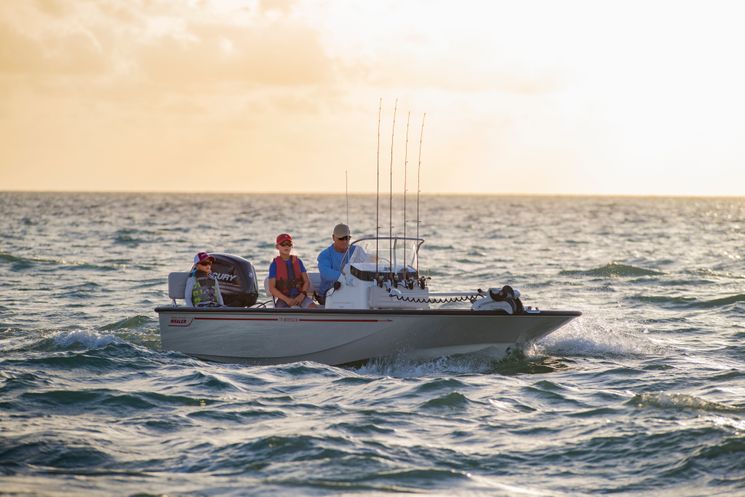
What is the minimum size boat for offshore fishing? The answer depends on who you ask. The challenge and your budget are the two biggest reasons for fishing from a small offshore boat. Many cite the unique satisfaction of taking on the ocean to fish it on their own terms, knowing they have the boat, the knowledge and the ability to get out there, catch some good fish and get back.
“There’s definitely the excitement of being out there in a small boat where you’re in control and doing your own thing,” said Angelo Cuanang, a West Coast offshore fishing writer and expert who regularly fishes off San Francisco Bay. He’s done so for many years — all in a 17-foot Boston Whaler Montauk. Being unsinkable, the Whaler is one of the best small boats for ocean fishing.
One school of thought from skilled mariners actually considers a smaller hull advantageous in large swells. Tom King, once a professional mate in Massachusetts, for years made the 20-plus-mile run to fish Stellwagen Bank aboard his 19-foot Midland (“a Nova Scotia-style hull,” he said, with a very high bow and very low freeboard). “We came home riding on top of the big seas like an eggshell, while much bigger sport-fishing boats were having a tough time rolling in the swells.”
For purposes of this discussion, let’s focus on saltwater fishing boats with a minimum size ranging from 17 to 22 feet in length overall (LOA). A boat this size has an element of responsiveness that much larger hulls lose. In addition to being a criterion for offshore fishing, this size range also offers the best small boats for rough seas. Of course, rough seas are relative, and distance from shore often dictates the decision to go or not go.
– GET A VHF RADIO – A VHF marine band radio is your first line of communication on the water, allowing you to talk to the Coast Guard and other boat traffic. Use Channel 16 only for hailing and emergencies. Safety Tip Provided by the U.S. Coast Guard
Offshore Boating Benefits of Small Fishing Boats
Besides the challenge, downsized boats are less expensive and easy to tow on the road than king-size boats. Small boats can also be easier to handle and dock in tight quarters, though features such as joystick controls on larger boats are making low-speed maneuvers easier for skippers of large boats.
Start comparing costs of purchase, insurance, moorage or storage, maintenance and so on for a 30-foot center-console with those of a 22-footer. Then of course there are fuel costs. At today’s prices, a day fishing a 30-footer with twin 300 hp outboards can cost you in the high hundreds of dollars, if not more than $1,000. But you can run offshore and troll all day in a boat such as the Robalo R222 (21 feet 6 inches LOA) or Sea Chaser 22 HFC (21 feet 9 inches LOA) with a single 200 or 250 hp outboard for a few hundred or less.
Lots of anglers trailer their boats 50 to 100 miles at the drop of a hat. Compare hauling a double- or triple-axle trailer behind a ¾- to 1-ton pickup versus a lighter, single- or double-axle trailer behind a half-ton pickup — and there’s even more economy.
Small-Boat Knowledge, Ability and Common Sense
There’s no federal regulation stating that “Thou shalt not take thy boat and go (offshore),” and in fact the Coast Guard only has authority in a few places to prevent boaters from going where they want, a Coast Guard spokesman said. To go or not to go is not the question. Rather, focus on knowing your small boat, recognizing when to go or not, and with what gear and preparation.
Accident reports often retell scenarios where anglers in small boats perished before the Coast Guard could reach them. Often these are cases where knowing the boat and having the right equipment could have saved lives. Experience often makes a major difference when it comes to safety. Anglers who know what the ocean can dish out and respect that power choose to err on the side of caution, and do not scrimp on safety gear .
Many who skipper such mighty mites far from land tend to be independent by nature. Still, many make it a point to travel offshore with another boat — known as “buddy boating”— when possible, small or large, which in effect offers a second engine.
Whether or not you have a buddy going with you, be sure to file a float plan before you leave. That can be as simple as making sure someone back on land knows when you plan to depart and return, and where — in general — you expect to fish.
– LOWER YOUR RATES – Taking a boating safety course won’t just make you a better skipper. It could also help you save big on insurance. Safety Tip Provided by the U.S. Coast Guard
The Right Boat: Moderate Vees and Hard Chines
What is the best small boat for offshore fishing? There are plenty of 17- to 22-footers for fishing bays, channels or flats. But if you plan to run offshore, you’ll need to investigate construction, quality and design.
That said, some bay boats such as the Pathfinder 2200 TE (22 feet 2 inches LOA) or Sea Born FX22 Bay Sport (21 foot 9 inches LOA) offer offshore fishing capability , as well as the ability to sneak into shallow inshore waters.
Still, there can be no doubt that with the specialized demands of offshore fishing, not all small hulls are created equal. When it comes to hull design, opinions vary — suggesting competent small hulls might come in more than one style.
A modified V rather than the deep V common on larger center consoles ranks as the top choice among experts looking for the optimal small planing hull for big water. While the steeper deadrise angle of up to 26 degrees at the transom offers the softest ride through waves, an angle in the 17- to 20-degree range proves more stable. That way you still get some damping effect from the V but also get some benefit of lateral stability.
Fuel capacity becomes a serious consideration for any small boat heading offshore. On the minus side: Many small boats have built-in tanks and some provide space only for portables. On the plus side: Light boats with small outboards can go all day on amazingly little fuel. Once you pick a boat, know its range and always allow for at least a 15 percent reserve.
A small but important point: marine battery placement. Batteries should ride forward, beneath the console, rather than at the transom, where they can get wet and add unnecessary weight.
One other essential element of small boat construction that becomes particularly important offshore is flotation. Positive flotation is required for certification by the National Marine Manufacturers Association in boats less than 20 feet, but the best hulls are fully filled with foam, and the reasons should be obvious. In an emergency, water can force air out of a hull or sides but not out of foam. A light hull gains little weight (always a factor) but considerable strength and rigidity from foam.
Water In, Water Out
A small boat easily takes on spray and, on rough days, some green water as well. That’s when scuppers become critical. (This assumes that no angler without a death wish would be offshore in a boat that’s not self-bailing.) The scuppers must be able to drain water as fast as it comes into the hull — if not, you’ll soon be playing submarine.
Transom height and design also play key roles in keeping water out of small boats. A small outboard-powered boat faces trouble fast once enough ocean water enters and runs to one side or the other in heavy seas. To help avoid that, look for small offshore boats with a full transom. A cut-out transom might work with a really good, generous motorwell. Worst case for offshore: a low, cut-out transom with no well. If that describes your boat, stick to the bay.
The Right Offshore Boating Equipment
No small boat, however seaworthy and stable, belongs offshore — ever — if it’s not properly equipped. The most major piece of equipment to consider is your outboard engine . A traditional preference among blue-water anglers has been twin or even triple outboards for safety. However, adding a second engine for the small boater might be either cost-, design- or weight-prohibitive. Fortunately, today’s outboard engines are more reliable than ever.
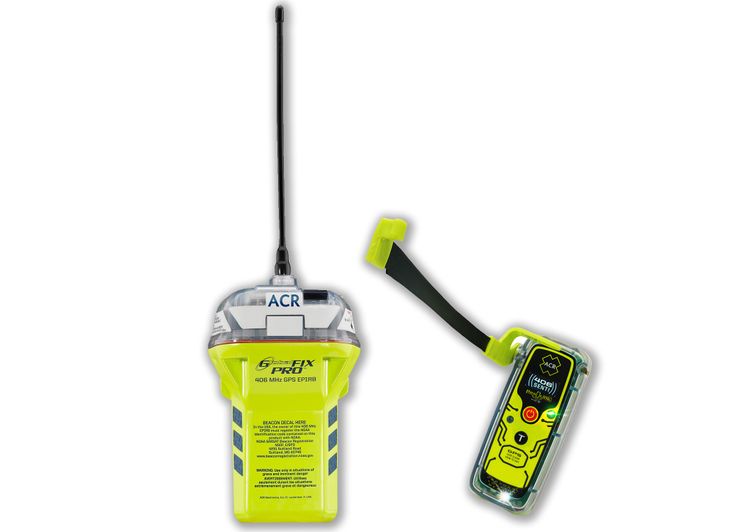
When feasible, a small auxiliary engine (aka kicker) is a great addition since it can get you home in a pinch — but, again, it may not be worth the additional weight on the stern of a 17- to 22-footer.
Additional key safety equipment to carry when fishing offshore includes the following:
Fixed-Mount VHF Radio — Fundamental and essential. Fixed-mount radios offer a range of 15 to 20 miles while handhelds only reach out 3 to 8 miles. All new VHFs, by law, come with Digital Selective Calling, which instantly sends a distress call to authorities anywhere in the world. Be sure that you set up your DSC calling feature before leaving port. Cell phones are popular everywhere, including offshore, and offer some backup. But these can’t substitute for a VHF in a pinch since users might not find coverage in all areas offshore, and a phone call does not immediately summon on-water help. Mate your VHF radio to a tall (8-foot) VHF antenna for the range necessary when fishing offshore.
GPS Plotter/Sounder — As critical for navigation as for fishing. Separate units are fine, but a single unit (capable of showing both chart plotter and sounder reading on screen simultaneously) maximizes limited space on small consoles.
Compass — With a good nautical chart, a compass will keep you headed in the right direction if your GPS fails. Amazingly, some small boaters venture far offshore with neither radio nor compass, according to the Coast Guard.
Extra Battery — Any boat fishing offshore should have a dual-battery system with a selector switch. This allows you to keep one battery in reserve in case one goes dead.
Emergency Beacons — An EPIRB (Emergency Position Indicator Radio Beacon) and a PLB (Personal Locator Beacon) are good ideas for any boat fishing offshore. Once activated, an encoded digital message is received by satellites, and is then transmitted back to ground-based search and rescue authorities. This signal provides information to assist in the search. Assuming you have properly registered the EPIRB or PLB, it tells rescuers who you are, your boat type and size, where you are, and other important data, including emergency contact information. An EPIRB is registered to the boat and is usually mounted on deck, while a PLB is registered to an individual and is carried by that person.
Life Jackets — Going offshore without them would not only be illegal but insane. Make sure your jackets are Coast Guard rated for offshore use (Type I). It is a good idea to wear a life jacket at all times, especially if fishing alone.
Emergency Kit — including flare gun and flares, cyalume sticks and waterproof strobe lights. (I also make sure my boat’s running lights are in good working order.) Don’t forget a good flashlight and extra sunscreen.
Emergency Food and Water — At least a half-gallon of water, some granola bars and beef jerky or canned meat can get you through a day or two.
Anchor and Lots of Line — Even if you don’t anchor to fish, you might find an anchor valuable, and plenty of heavy line is a must if you need to be towed.
Sea Anchor — Space might preclude stowing a small sea anchor, but make sure you have at least a bucket or, in a pinch, even a spare life jacket. Most boats tend to drift stern-to — the worst situation in a building sea. Your odds of staying afloat when broken down and adrift go up by a big chunk if you can keep the bow into the waves, and any sort of sea anchor will help accomplish this.
– CARRY A BEACON – Satellite beacons such as EPIRBs or PLBs allow boaters to transmit distress signals and their exact coordinates from anywhere on the planet, no cell service required. It may be the best $400 you ever spend. Safety Tip Provided by the U.S. Coast Guard
Pick the Right Fishing Weather
Given a seaworthy boat, properly equipped, everything else comes down to common sense. And nowhere can the small boater better demonstrate that than by reading the weather before and during a trip.
Starting out the morning in a 3-foot sea is a mere irritant to a 30-footer, but for the mini-boater who has his head screwed on right, it means a canceled trip. Many mornings I’ve arisen to find the weather service data revised from the previous evening’s 5- to 10-knot wind forecast to one of 10 to 20 knots. Anyone hoping to go offshore in a 17- to 22-footer has to realize his fishing days will be limited.
Look for periods between frontal systems, particularly in fall, winter and spring when dead-calm days sneak in between blows. During the summer, high pressure systems often bring many successive days of calm weather, particularly in the morning. The run home in many regions might mean a moderate but manageable chop, thanks to afternoon sea breezes.
Just be sure you know the marine forecast for the day, before you head out. When the forecast calls for light breezes all day and into the night, boating anglers with small boats can usually venture forth into offshore ocean waters with peace of mind. Otherwise, the best rule of thumb is a simple one: When in doubt, don’t go out.
- More: Boating Skills , Center Consoles , fishing boats , Marine Electronics , Saltwater Fishing Gear
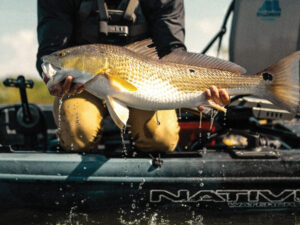
Best Kayaks for the Marsh

What’s Good Fuel Economy for a Fishing Boat?

Yamaha Releases New 350 Horsepower Outboard
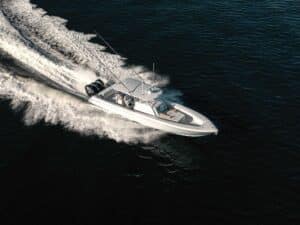
Supersize Center-Consoles Expand Angling Horizons

Fishing the Mid-Atlantic Cobia Run
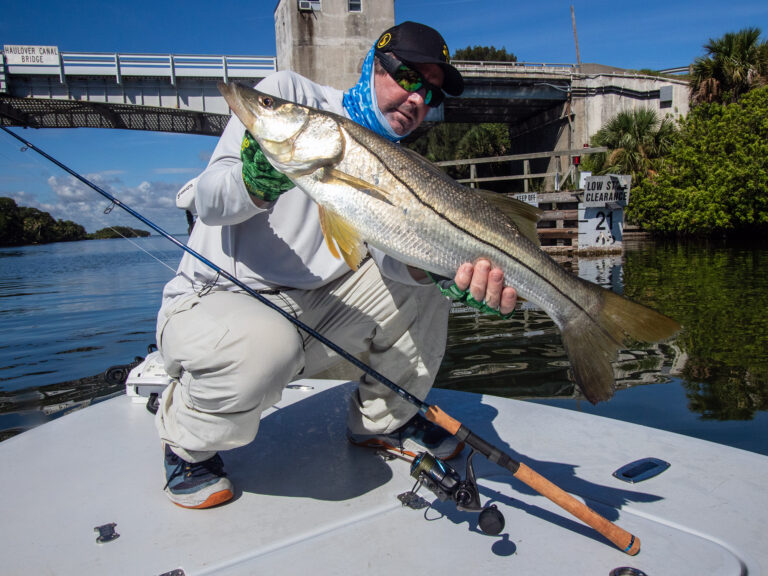
Make Mine a Jumbo

Sport Fishing’s Deals of the Week

Tracking Texas Tarpon
- Privacy Policy
- Terms of Use
- Cruising World
- Sailing World
- Salt Water Sportsman
- Sport Fishing
- Wakeboarding
Many products featured on this site were editorially chosen. Sport Fishing may receive financial compensation for products purchased through this site.
Copyright © 2024 Sport Fishing Firecrown . All rights reserved. Reproduction in whole or in part without permission is prohibited.
Yachting Monthly
- Digital edition

What makes a boat seaworthy?
- Duncan Kent
- April 17, 2020
What characteristics make a yacht fit for purpose? Duncan Kent explores the meaning of 'seaworthy' and how hull design and technology have changed the way we think

Hallberg-Rassy yachts have long been the epitome of a rock solid modern cruiser. These too have now changed to twin rudders. Credit: Rick Tomlinson Credit: Rick Tomlinson
A hundred years ago a yacht was considered seaworthy if it could stand up to a full gale whilst continuing to make headway under sail while still keeping its crew safe.
Today, yachts are designed and built using entirely different construction parameters, with far more emphasis on speed, ease of handling, openness and comfortable living.
Do any of the old maxims still apply or are new cruising yachts better than the classics?

A cutter rig gives you more options for reducing sail and balancing your canvas. Credit: Graham Snook/Yachting Monthly
There are many improvements to the contemporary offshore yacht that have indeed increased its seaworthiness.
Take sail plans and sail handling, for instance.
Fifty years ago it was common to battle your way to the bucking foredeck to change headsails as the wind reached screaming pitch.
Rarely would you be wearing a lifejacket either, as these consisted of big lumps of foam tied awkwardly together, which always got in the way of what you were doing.
Today, the fractional sloop rig with furling headsails is pretty much standard, so the foresails are smaller and the risk of leaving the cockpit to reef is removed.

Powered winches have revolutionised sail handling
Cutters or ‘slutters’ (twin headstays close to each other) seem to be the sail plan for long distance sailing and even downwind sails come with furlers and the yachts with bowsprits for their tacks.
The same goes for the mainsail which, even if it isn’t the furling type, is often fully battened and can usually be dropped safely into a zipped sail bag using cockpit-led sail controls.
There’s no doubt that this has brought about a massive improvement to the safety of the crew, and in turn the yacht’s general seaworthiness.
The introduction of modern ropes has also improved the life of the sailor no end.
Massively strong man-made fibres such as Spectra and Dyneema have allowed much lighter and smaller diameter lines to be used and many are changing their old steel shackles for the more user-friendly ‘soft’ shackles, eliminating the dangers of flying bits of heavy metal and making a corroded shackle pin a thing of the past.
Despite modern yachts being able to sail so much better than the classics in light airs, at some point you’ll need an engine – even if it’s just to charge your batteries.
Despite being relied upon so heavily these days, the good old marine diesel can be the cause of many headaches.
A properly designed engine installation will offer easy access to all the regular service points, particularly the water pump, fuel filters and water traps, alternator, coolant, oil filler, dipstick and filter and starter battery.
Hull design
One of today’s most prevalent and popular yacht designers is Stephen Jones, creator of the Rustler 33, 42 and 44, Starlight 35 and 39, the Hunter Mystery 35, Sadler 260, Southerly 32, 38 and 470 and many more performance cruisers as well as traditional racing designs such as the Spirit.
One of the primary reasons for his popularity is that he undoubtedly has the knack of blending tradition and technology – the result being a stunning combination of beauty and performance, rather than an indifferent compromise between new and old.

A Rustler 37, with an encapsulated keel, emerges from its mould. Credit: Graham Snook
Of his many classic designs Jones says: ‘Without doubt the modern CAD-derived hull outperforms all of those built in the days when the main criteria for a cruising yacht was just that it had to be virtually indestructible. I try to blend the aesthetically attractive elements with the best technology can offer in order to produce a yacht that doesn’t just look beautiful but is also exciting to sail.’
A great deal has changed in hull design since the advent of the famous Folkboat, some 50 years ago.
The advent of bolt-on keels has allowed bilges to be shallower, improving the yacht’s speed – especially off the wind.

Traditional long keels, with external and internal ballast, soften the motion at sea
Whereas a 50% ballast ratio used to be considered the norm for an offshore yacht, today fin keels often have the ballast placed deep down in a bulb at their tip, where it provides the greatest righting moment possible for the least amount of ballast, so it’s not uncommon to find the ratio is now more like 30-35%.
In addition, the keel’s short length reduces the wetted area and associated drag. Some insist that bolt-on keels are unseaworthy and indeed, accidents have happened where they have become detached. But these incidents are actually very rare and almost always the result of a hard grounding or poor maintenance.
Making the bilges too shallow made for a good deal of slamming when sailing to windward in many 1980-90s boats, but in later years this habit was eliminated with the introduction of finer bows with deeper entry.
Wider hulls
One downside of a wide, flat boat is that it can be almost as stable inverted as upright, so increasing the angle of heel at which the yacht’s stability vanishes (AVS) to the highest degree is very important.
Hull chines, which were originally introduced for plywood and steel boats to allow simple flat materials to be used in their construction, have made a widespread comeback over the past decade.
With sterns becoming wider and wider to improve accommodation below and cockpit space for twin wheels, any means of increasing a hull’s inherent form stability (the hull natural resistance to heeling and inversion) is welcome and hard chines appear to do just that – giving the hull defined ‘rails’ on which to run.

Modern: The Beneteau 46.1’s full-length chine and twin rudders. Credit: Guido Cantini / Beneteau
They also improve directional stability and help prevent the yacht rounding up when over-pressed.
More cruising yachts are disabled through loss of, or damage to their rudder by flotsam than almost anything else.
Traditionally, they were well protected either by a long keel or, more likely, a stout skeg at least half the depth of the rudder.

Classic: A long keel and a slender stern
The modern trend, however, appears to be for deep spade rudders with no such protection, and twin rudders are now becoming popular. Primarily they’re designed to keep steerage when the quarter of a very wide stern lifts clear of the water when heeled.
Some believe they provide redundancy in the event one is knocked off, but any amount of heel beyond 10° with a wide-sterned cruiser can cause the windward rudder to come out of the water. If you’ve lost a rudder, you are forced to remain on one tack or to sail dead downwind.
More importantly, unless you’re smart (like renowned circumnavigator Jimmy Cornell with his new Aventura ) and you ensure each rudder can be independently steered, damage to one rudder will very likely disable the entire steering system due to the linkage between them.
Although there’s a tendency these days for yacht designers to prioritise style over substance, the wide-open cockpits of the modern production cruiser can fulfil both the need for lounging space at anchor and safety at sea by making a few simple, relatively inexpensive modifications.
Before embarking on regular offshore passages, the owner needs to carry out a careful analysis of the likely risk areas and to retro-fit extra safety features such as grabrails and harness points where necessary.
The centre cockpit, made famous by Bill Dixon in his many Moody yachts, is still popular in many Swedish yachts, but like many aspects of yacht design it has its advantages and disadvantages.

The Amel 55 is designed to take her owners anywhere in the world in comfort. Credit: Graham Snook/Yachting Monthly
Being higher up and forward in the boat means that water rarely gets near it and it often imparts a feeling of security in the crew being so far above the water.
However, it does restrict the helmsman’s view forward when the genoa’s flying and it can make those prone to seasickness feel worse due to the more pronounced side-to-side movement in a beam sea.
One real bonus, however, is the raised height allows for huge aft cabins – something for which Moody and Halberg-Rassy yachts are renowned.
An aft cockpit, though more vulnerable to a steep following sea, does make you feel more in touch with the boat somehow.
A high bridge deck or similar can greatly reduce the risk of down-flooding from the stern in stormy conditions.
Below decks
The seaworthiness of a yacht is not only affected by its hull design and rig, but also how sea kindly it is below.
For a start, those wanting to cruise overnight will need a decent bunk for the off-watch crew.
By that I mean one that’s preferably close to the middle of the boat and that can be converted to a comfy, secure single berth.
In most production cruisers this will mean the saloon berths, so if you’re looking to buy it’s worth just checking the length, width and suitability of these.

The raised coachroof of the Garcia 45 Exploration gives comfort below, while granny bars at the mast keep crew on deck secure. Credit: Morris Adant
If not, then double berths can often be converted using lee cloths or boards, which can be removed or folded away when at anchor or in port. The worst place for a sea berth is in the forepeak, as this is where the motion will be greatest.
You’ll often need to add a few handrails around the boat too, especially as you descend the companionway. A little clever repositioning or subtle padding of furniture can make a difference.
One of the most important aspects of boat safety is the through hull fittings. It’s a good idea to draw a sketch of where they all are and what they do so that crew unfamiliar with the boat could find them quickly in an emergency.
Also ensure all your seacocks are good quality marine devices (Bronze or DZR), not domestic plumbing ones (worryingly common on many new boats) and that you tie a suitable softwood bung to it.
Choosing a yacht
The very first question you should ask yourself when considering buying a yacht is ‘what do I intend to do on this boat?’
The answer should then steer you towards the type of yacht suitable for your endeavours, whether they be pootling along the coast on fair weather days and tying up in a marina berth at night or taking your family on long passages in open and unprotected offshore waters.
The former is catered for by myriad production boatbuilders and should be reasonably affordable. The latter not so.
A properly designed and constructed offshore yacht will cost much more – probably three to four times as much as a production cruiser – and rightly so.
All that extra investment will be reflected in the integrity of the design, the quality of the materials used and the standard of craftsmanship put into building her.
Saying that, it’s a myth that many pocket cruisers are inherently dangerous if sailed offshore.

Roger Taylor converted his Achilles 24 to sail to some of the most remote high latitudes imaginable
I’ve often felt happier sailing a well-found 26-footer across the English Channel in a near gale than I would have felt in a modern 50ft production cruiser set up for day sailing in fine conditions.
I know this rather makes a mockery of the RCD categorisation scheme (A-ocean; B-offshore etc), but often smaller boats are only Cat B or C because the builders can’t afford the more stringent testing for higher categories.
Any sailor worth their salt will know that a large portion of a vessel’s ability to sail safely offshore is in how you prepare your boat and crew beforehand and many adventurous sailors have ventured far afield without incident in small yachts.
Roger Taylor single-handedly overcome the vagaries of the northern latitude weather systems, covering thousands of miles safely in the same type boat in which Ellen MacArthur first circumnavigated Britain.
Shane Acton’s 18ft long Caprice, Shrimpy , would never get an RCD A (Ocean) rating whatever you did to it, but she proved seaworthy enough to get Acton around the world in one piece.
Without doubt, there have been numerous innovations over the past few decades that have made offshore sailing easier.

Effective self-steering made Jean-Luc Van Den Heede’s life easier in the 2018 Golden Globe Race. The Rustler 36 was the boat of choice in the race, sailed by the first three finishers. Credit: Alain Zimeray/Golden Globe Race/PPL
A crew of two can now easily handle the latest 60ft yacht, thanks in particular to cockpit sail controls, electrically assisted deck gear and up-to-the-minute navigation technology.

Duncan Kent has tested hundreds of yachts and is the author of Choosing and Buying A Yacht
The greatest advantage a modern yacht has over an older, heavier boat is speed. A modern yacht’s ability to make headway fast is in fact one of its most seaworthy points as it allows the crew to navigate around a slow-moving storm or to sail off a dangerous lee shore in the event the engine dies or the anchor drags.
Problems encountered by many of the 2018 Golden Globe Race (GGR) entrants were certainly aggravated by their inability to sail faster than a few knots away from threatening weather.
Instead, they had to sit it out, hoping their sluggish old classics would be tough enough to take the hammering of the Southern Ocean waves.
Most recently launched hulls are a huge improvement over the over-engineered 20th-Century designs, but changes in style mean compromises will have to be made to ensure your yacht is as seaworthy as it can be.
Wide, open cockpits require more clipping on points and extra handrails, and for those planning to go world cruising in a standard production boat, much of the kit supplied will need to be upgraded before you set off.
Top tips to improve seaworthiness before blue- water cruising
- Install watertight crash bulkheads forward and aft (forward of the rudder stock).
- Move heavy items such as batteries, tanks, spare anchors and tinned provisions as low and as close to the centre of the boat as possible and ensure they are strapped down.
- Make sure all locker lids, soleboards and washboards can be securely locked in place.
- Pre-build a workable emergency steering system and test it out in heavy seas before you depart.
- Create easy-launch stowage for the liferaft.
- Carry several heavy lines, a series drogue and a sea anchor.

Ensure the right size bungs are attached to your seacocks
- Make tough wooden shutters and easy attachments for vulnerable hatches and portlights.
- Any windows in the topsides should be non-opening and made from seriously reinforced glass.

Have a means of locking stowage shut. Credit: Graham Snook/Yachting Monthly
- Tie suitable bungs to every skin fitting for emergency use.
- Fit fire extinguishers of varying sorts near to where they might be needed and keep them regularly serviced.
- Fit a bilge alarm and dual electric bilge pumps plus a manual.
For all the latest from the sailing world, follow our social media channels Facebook, Twitter and Instagram .
Have you thought about taking out a subscription to Yachting Monthly magazine?
Subscriptions are available in both print and digital editions through our official online shop Magazines Direct and all postage and delivery costs are included.
- Yachting Monthly is packed with all the information you need to help you get the most from your time on the water.
- Take your seamanship to the next level with tips, advice and skills from our expert skippers and sailors
- Impartial in-depth reviews of the latest yachts and equipment will ensure you buy the best whatever your budget
- If you are looking to cruise away with friends Yachting Monthly will give you plenty of ideas of where to sail and anchor
By providing your information, you agree to our Terms of Use and our Privacy Policy . We use vendors that may also process your information to help provide our services. This site is protected by reCAPTCHA Enterprise and the Google Privacy Policy and Terms of Service apply.
Shocking ‘Industry’ Twist Began with ‘Coke and Boats’ Email to HBO
Chris o'falt, vp, features strategy.
- Share on Facebook
- Share to Flipboard
- Share on LinkedIn
- Show more sharing options
- Submit to Reddit
- Post to Tumblr
- Print This Page
- Share on WhatsApp
[Editor’s note: This story contains spoilers for “ Industry ” Season 3, Episode 6, “Nikki Beach, or: So Many Ways to Lose.”]
It is the most dramatic and arguably most consequential moment in the three seasons of HBO ‘s “ Industry .” During a heated argument with his daughter Yasmin ( Marisa Abela ), the disgraced book publisher Charles Hanani (Adam Levy) leaps from his yacht into the Mediterranean. His daughter decides not throw the buoy and save him, instead confiding in her friend Harper (Myha’la) to cover her tracks.
After the father-daughter unload, saying the most brutal and brutally honest things imaginable to one another, Levy, a well-established theater actor, saw the moment from his character’s perspective as a piece of theater, with Charles jumping as his moment to play the martyr.
“I was quickly able to find the motivation,” said Levy. “Charles is theatrical. It’s a vitriolic moment for him, before going in the water it was actually liberating. I think the trickiness was actually the intimate scenes on the boat with my daughter.”
Eklöf had one big note for Levy, which the actor agrees was the key to unlocking any villains he’s ever played.
“I’ve worked with male narcissists and psychopath [characters] in almost every single thing I’ve done, it’s always the same problem,” said Eklöf. “They have a hard time defending the character, because they think they’re supposed to play a stereotype. I always have to convince the guys who play rapists and bad guys that they need to have sympathy with this guy, otherwise it’s not going to work.”
“For Marisa, it wasn’t hard for her at all to find it. She’s very, very talented,” said Eklöf. “I think maybe it is kind of accessible for most women. Most women have had that feeling through life of butting their head against a stone wall of privilege, so I think it’s easily accessible.”
According to Abela, the way the writing built toward the moment, her character’s motivation was clear, and there was one moment in particular she saw a point of no return.
“I think it comes from the fact that when he pulls her into the hug, that she can feel him [Charles is still erect], I think that is a trigger for her because of her past. She sees red,” said Abela. “Hearing this sort of barrage of hatred from him, I do really think in that moment she wants to never see or think or hear from him again.”

In breaking down what immediately happens after Charles jumps, and her character’s decision to not act, Abela told IndieWire she analyzed the moment from three different perspectives, asking her the following: Is it a shock that he jumped? Is it an active decision? Is it negligence or even murder?
For Abela the Episode 6 fireworks are the punctuation of how the season has unfolded, with various flashbacks to the boat layered throughout the previous episodes.
“The flashbacks throughout the season punctuates how we filmed it. Each moment leads into the next,” said Abela. “Seeing him in her room on her bed [having sex with his young employee in Episode 1]. He’s brought her here, but he’s in lots of trouble, so he’s implicating her. There’s so much power abuse at the beginning of this [season] when it comes to her father because he knows that she’s completely financially dependent on him.”
The “Industry” creators Mickey Down and Konrad Kay agree with Abela, and view the payoff in Episode 6 as an example of how in Season 3 the former investors-turned- TV writers finally got the hang of how to structure the arc of a season of TV. It started when they sat down to write the first episode of the season, making the realization they needed to start on the boat, dropping the audience into Yasmin’s perspective of navigating Charles’ debachorous world of drugs and young women.
Added Kay, “We had to [convince] a few of the producers, because they were like, ‘Why don’t you just front load this, why are you parceling out over the season? Why are you keeping Harper’s revelation on the boat to the end of [Episode] 2? And we actually felt emotionally that those scenes were going to have way more impact the way we doled them out. I think Episode 6 is one of the more successful episodes of the season in terms of how it clicks everything into focus.”

One of the late story adjustments was deciding to put Harper (Myha’la) on the boat, which leads to her helping Yasmin. Abela loved what the episode revealed about Harper’s character, juxtaposed to the two characters blow-out fight at the end of the episode — Yasmin infuriated Harper used her at work for her own gain, knowing she was particularly vulnerable. The contradiction saying everything about how transactional relationships are on “Industry.”
“[Harper] would literally bury a body with her if she needed to,” said Abela, referencing Harper helping Yasmin after Charles jumps. “But if Yasmin asks her to forfeit her climbing the professional ranks, that’s where she draws the line. It’s insane, but that’s the way it is.”
Most Popular
You may also like.


COMMENTS
Three naval architects share their thoughts on what to look for in a good-riding boat.
Have you ever wondered what brands and models are the most popular bluewater cruising boats? So have we, so we plundered the archives of the World Cruising Club to see which boats have featured most prominently in the last five years of the rallies that the WCC organizes—the Atlantic Rally for Cruisers (ARC) from the Canary Islands to St Lucia; the Caribbean 1500 from Portsmouth, Virginia to ...
"We've always been enthusiastic about the panga hulls — how seaworthy they are, how efficient they are and how unique they are," says Rivolta, co-owner of the newly formed Mojito Boats division of Rivolta Yachts. "They do stand out in comparison to all the other small boats on the market, with their high-rising bow."
We analyzed two-thousand bluewater sailboats to bring you a list of the top proven offshore designs. Read on to learn about bluewater boats.
How do you choose the right yacht for you? We highlight the very best bluewater sailboat designs for every type of cruising
Few trawlers of this size can circumnavigate the world. The Nordhavn 40 is one of them. Nordhavn's goal was to demonstrate that even the smallest boat in its fleet was a safe and seaworthy passagemaker, so upon its launch the 40 circumnavigated the world. Twenty-six weeks after its departure, it completed a 23,000-nautical-mile voyage.
Pocket cruisers and yachts are great boats for those seeking offshore, overnight adventures or just a weekend day cruise with friends or family. Check out our lineup and quick reviews of the best cruisers under 50-feet to help find your next ride.
The best ocean and offshore boats are large and seaworthy enough to safety handle rough conditions, outfitted with the necessary equipment, designed with corrosion-resistant hardware, and have excellent fuel capacity.
If asked about the most seaworthy boats, you would think of giant cruise and cargo ships. But what are the most seaworthy boats under 30 feet?
A complete guide to the best center console boats for rough water. We've rounded up the most comfortable riding boats at every length and class.
Small sailboats are the ticket to big dreams on a small budget. Here are our five favorite small blue water sailboats for sailing around the world.
In this article, we've handpicked the top 7 legendary solo bluewater sailboats worth considering for their excellent track records. The most legendary solo bluewater sailboats are the Contessa 32, Westsail 32, Hallberg-Rassy 42F, Pacific Seacraft 37, Island Packet 38, Tayana 42, and Amel 54. These boats have it all: from robust designs to a ...
Here's The Answer To What Is The Best Boat For Rough Water: Aluminum-construction hulls are best for rough water, as are boats with semi-displacement hulls. Proper weight distribution also helps. Sailing boats are a great choice for rough water.
One of our favorite things every year is discovering new power cruisers at fall boat shows. Large or small, fancy or practical, these new boats are like presents under the tree. This year, the boat building elves were busy with dozens of new hulls launched. Here's a small sample of some of our favorites (ordered by length) that our team got to enjoy in 2018—and be sure to look at last year ...
These seven pocket powerboat cruisers are perfect for folks looking to downsize and simplify their boating lifestyle.
Six archetypes of seaworthiness. While my family and I were on summer vacation in Barnstable, Mass., on Cape Cod, I had the pleasure of encountering a veritable smorgasbord of recreational boats. On display from Pleasant Bay to the Cape Cod Canal, they were by turns provocative, charming and inspiring. Seeing them set me to musing about the ...
Lucky bastards. Sanlorenzo's yachts are nicer than most 5-star hotels, and they cost about as much as a castle. But you can probably afford that with your lottery winnings too. These boats are ...
Seaworthy As with all sailing boats built by Morris Yachts, the M36 offers peace of mind. You are onboard one of the most seaworthy boats in the world. Setting the industry standard, Morris Yachts' level of engineering, fit and finish sets the benchmark by which other builders measure themselves.
Come learn about the best liveaboard boats! You will find out the best size boat for liveaboard, what kinds of boats you can live on and more.
The Right Offshore Boating Equipment No small boat, however seaworthy and stable, belongs offshore — ever — if it's not properly equipped. The most major piece of equipment to consider is your outboard engine. A traditional preference among blue-water anglers has been twin or even triple outboards for safety.
A hundred years ago a yacht was considered seaworthy . if it could stand up to a full gale whilst continuing to make headway under sail while still keeping its crew safe. Today, yachts are designed and built using entirely different construction parameters, with far more emphasis on speed, ease of handling, openness and comfortable living.
Altering consumer demand is the surest way to seaworthy designs safely moored to reality rather than fantasy afloat. This article originally appeared in the June 2012 issue. If the idea needed reinforcement, there's been plenty of it in the news recently — big ship or small boat, there's no room for complacency at sea.
[Editor's note: This story contains spoilers for "Industry" Season 3, Episode 6, "Nikki Beach, or: So Many Ways to Lose."] It is the most dramatic and arguably most consequential moment ...